Project Overview
Awards
3rd Prize
Awards
Project Description
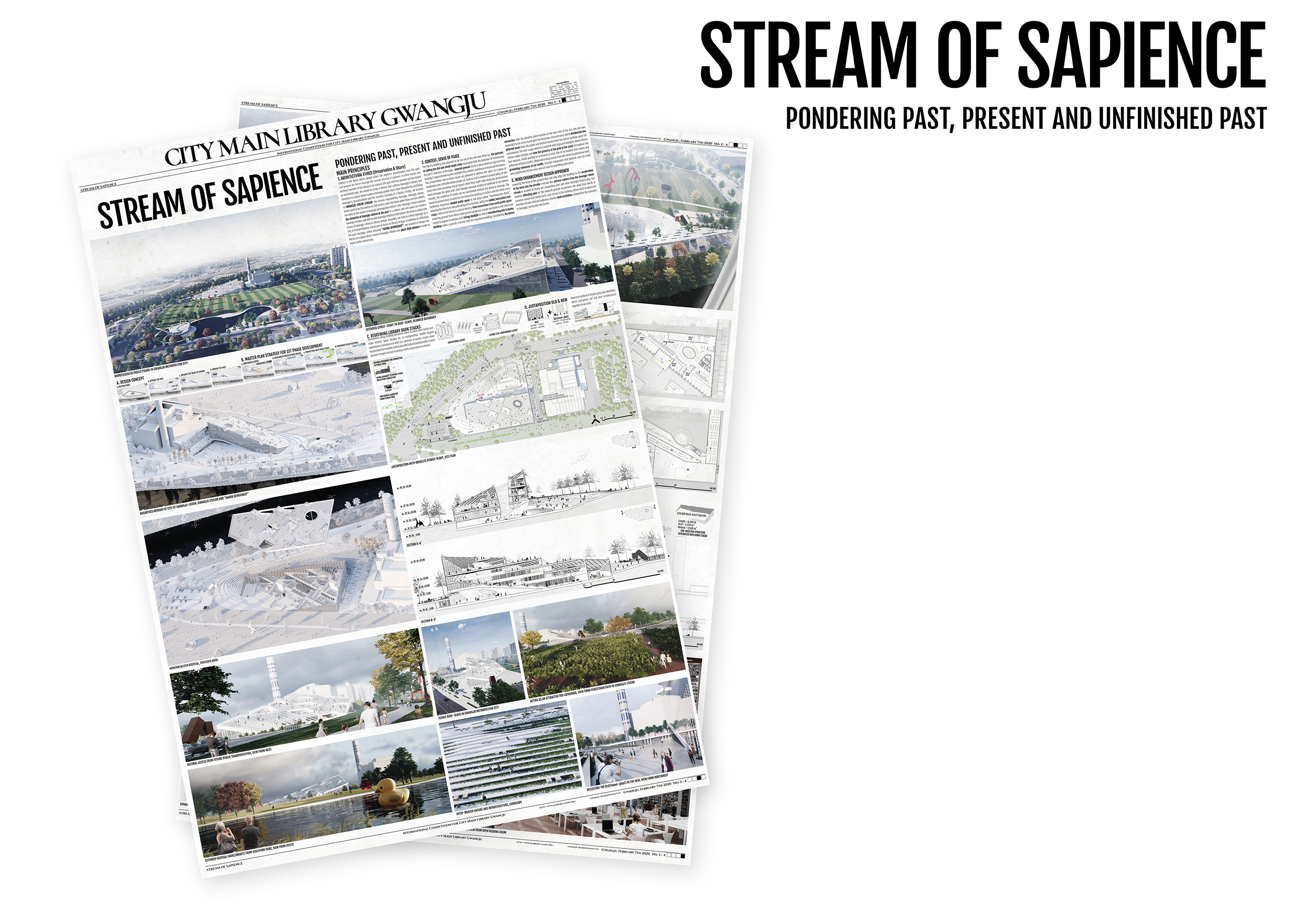

1. Architectural Ethics (Preservation & Share)
Library is the space where people share the sapience accumulated from the past and prepare for future through the current sharing of sapience. In other words, the intrinsic function of the library is to connect the past with the present and the future as unfinished past. We aimed to create a library that reflects Gwangju’s history and functions as a place where modern Gwangju people share their thoughts by combining Gwangju’s characteristics and the intrinsic function of a library. Firstly, we focused to Gwangju-cheon stream, the stream representing Gwangju. Gwangju-cheon, which used to be 130 meters to 300 meters wide (10 times wider than current width), has been at the center of Gwangju metropolitan citizen’s life. Gwangju-cheon contains the memories of Gwangju citizens in the past, is a culture and rest space for modern Gwangju citizens, and will be with Gwangju citizens in the future. We tried to reflect the traces of Gwangju-cheon in library design. Secondly, we tried to reflect Gwangju as a city of democratization movement of Korea in library design. In addition to reflecting the past Gwangju, which elevated “Agora democracy”, we wanted to design the library as a space where modern Gwangju citizens can share their wisdom in order to realize better democracy.
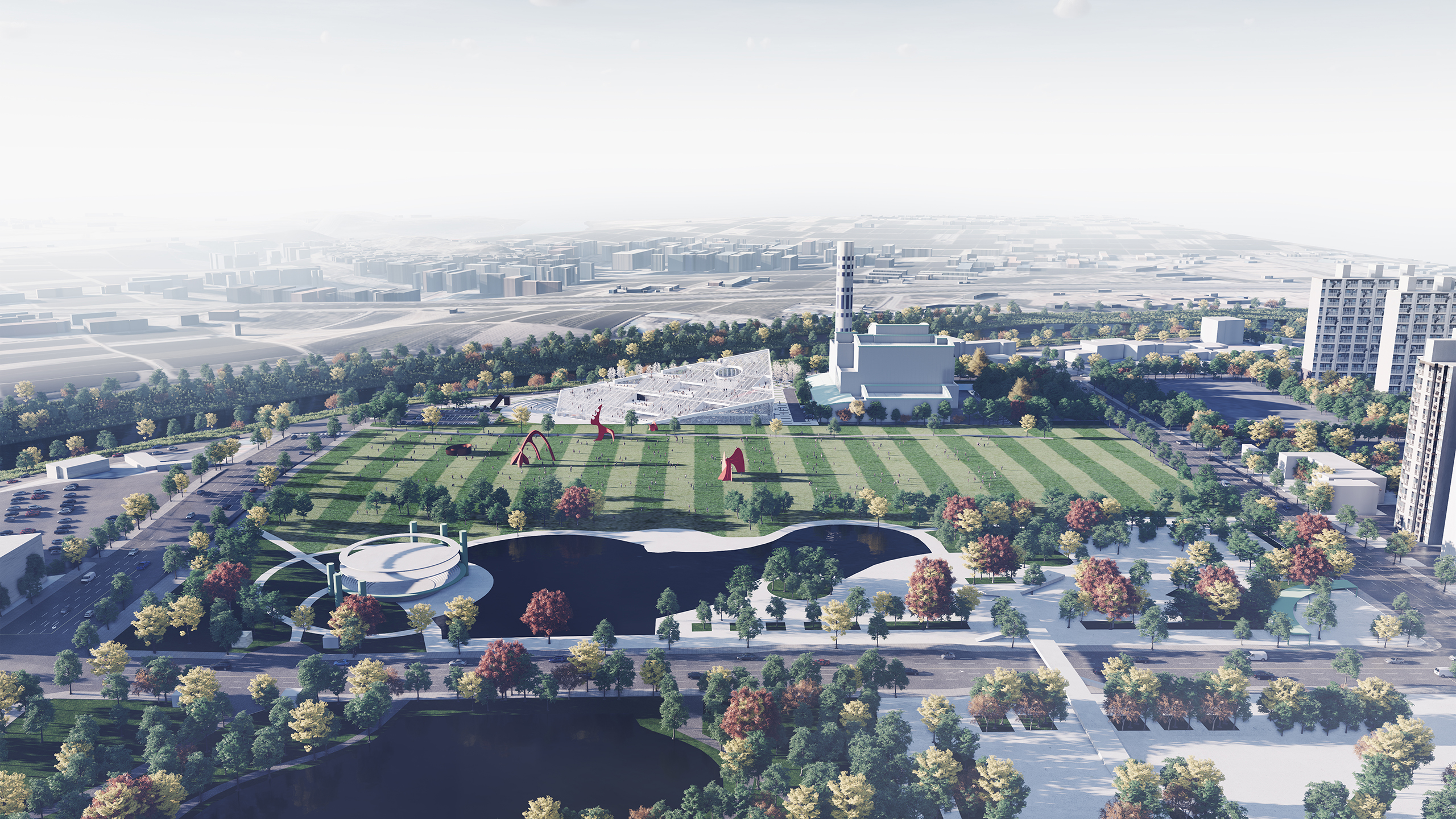
UNPRECEDENTED PUBLIC FIGURE IN GWANGJU METROPOLITAN CITY
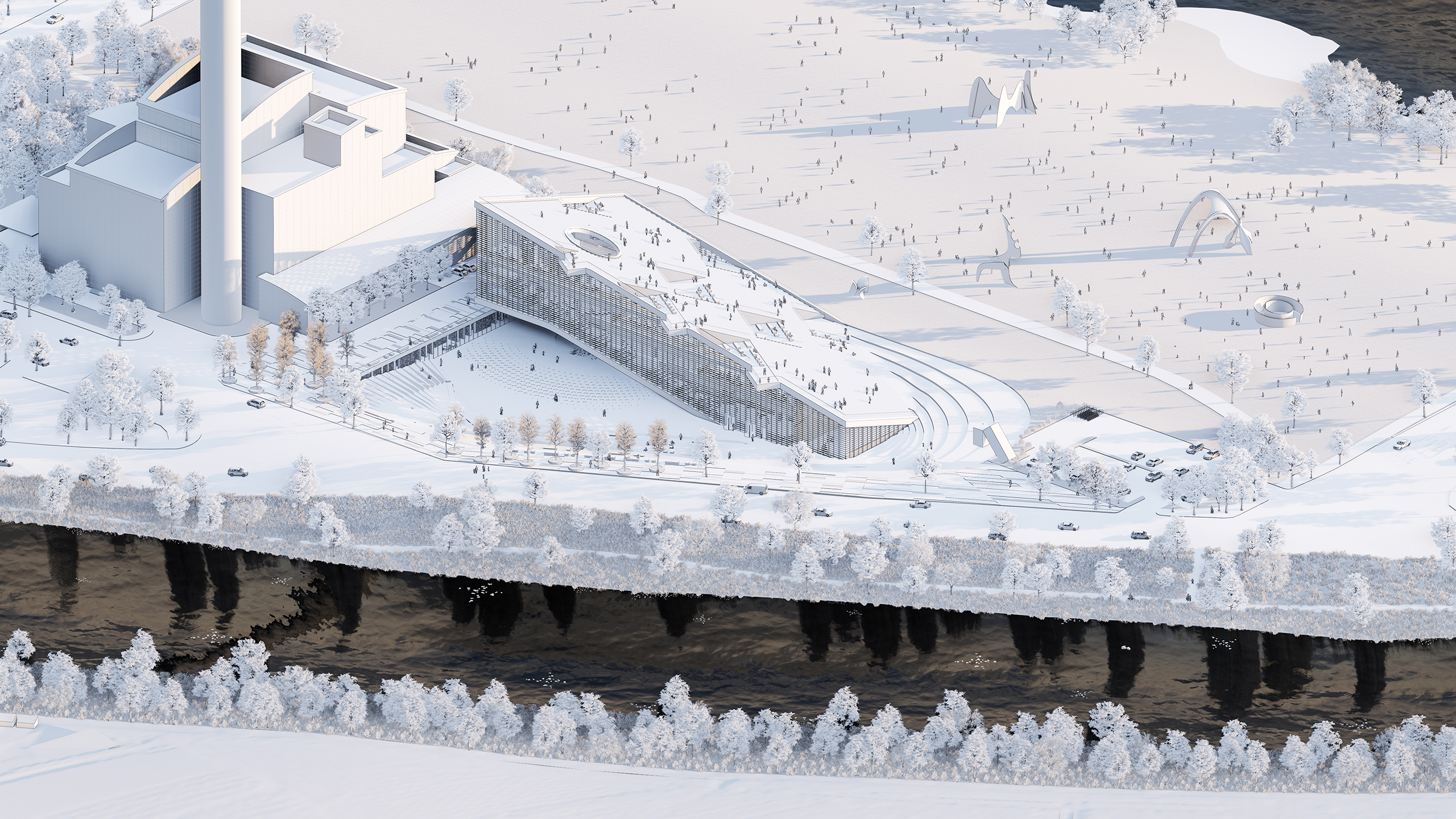
UNEARTHED MEMORY OF CITY OF GWANGJU-CHEON, GWANGJU STREAM AND “AGORA DEMOCRACY”
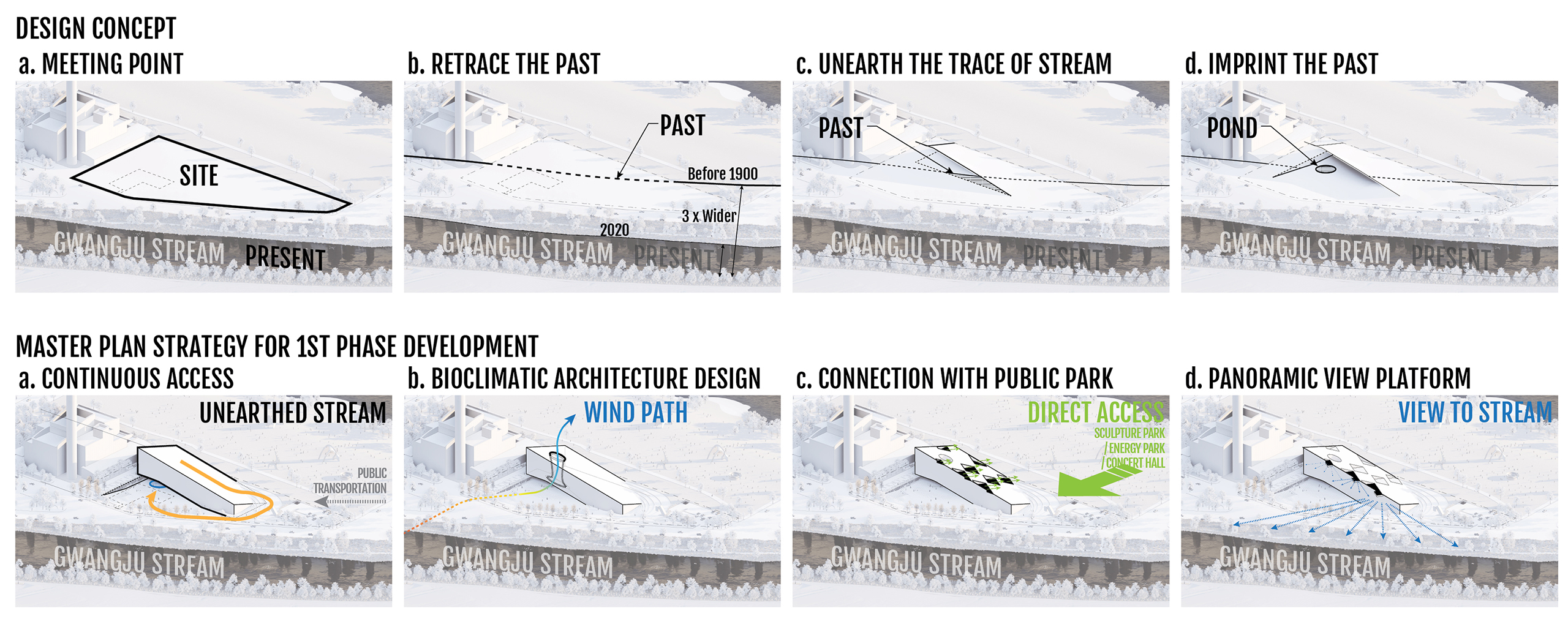
2. Context, Sense of place
The library building was planned to be cut out of the site and lifted up. The gestures of cutting the site and raised single mass associated with the behavior of reminiscing the past’s memory in Gwangju. Lowered ground can be a plaza which is representing Gwangju’s Agora democracy for multiple uses, shelter, and dance or music performance.
The preservation and archive rooms are planned to bestow the users to a place of meditation and reflection while people sit, read or rest in lowered ground plaza. At the same time with providing visual impact while they could walk along the preservation room through the glass wall. Even though valuable archive is exhibited to all visitors visually, the condition of media can be maintained without any physical damage. The lowered ground plaza created for the future demanding of visitors and the lifted mass facilitates maximum shaded public space in the plaza called “Reminiscence Plaza”, allowing the library to take advantage of its location, while the visible, interactive roof-scape, reflects the library’s radical identity, fluid connections from south public space. Lowering ground level allow underground programs except mechanical and electrical rooms to expose to outside and it brings daylight as well as transforming into 5 stories building unlike a generic 4 stories and one basement building. Considering the future connection with the obsolete plant located on the east side of the site, the site was separated to use as an access path for librarians. East entrance clearly divided into two different levels from the public and located closely from the service parking space for convenience. The roof-scape which is consisted with steps and skylights allows library visitors enjoy daylight and view the greenery of the park to the south throughout the four seasons. Public parking lot is located in west side to be isolated from noises and pollutants of heavy traffic. While welcoming access from the north on pedestrian level, preventing nuisances of car traffic, benches integrated with bollards and tall trees were populated and the mass was set back for providing open plaza.
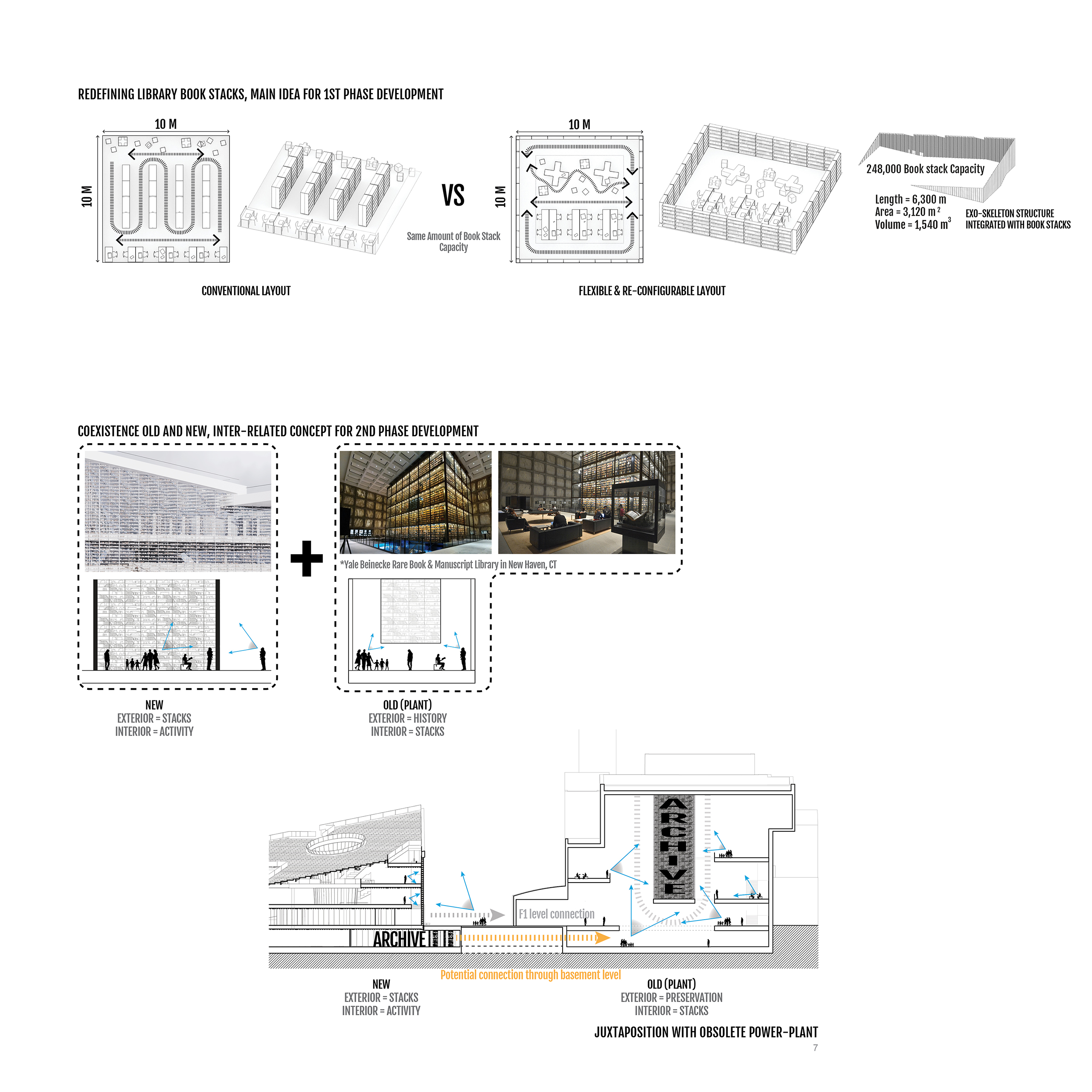
3. Wind enhancement design approach
Lowering the level of the ground does not only align the building to the acceleration of the wind into the circular void but also attracts visitors from the Gwangju-cheon stream is located in North yet connecting east and west Gwangju historically. The shallow reflecting pool on the lowered ground accelerates the wind from North in summer season and raised north-east corner of the building allows wind to penetrate into the circular void and improves interior wind ventilation, integral for the summers in Gwangju, mostly hot and humid.
4. Environment, Minimal Intervention
The skylight of the south side is composed of frosted glass, which allows indirect natural light to the library, and the remaining east, west and north bookcase facades allow to have a consistent indirect light as well. Through a gap among books on facade from inside, visitors look out Gwangju-cheon stream.
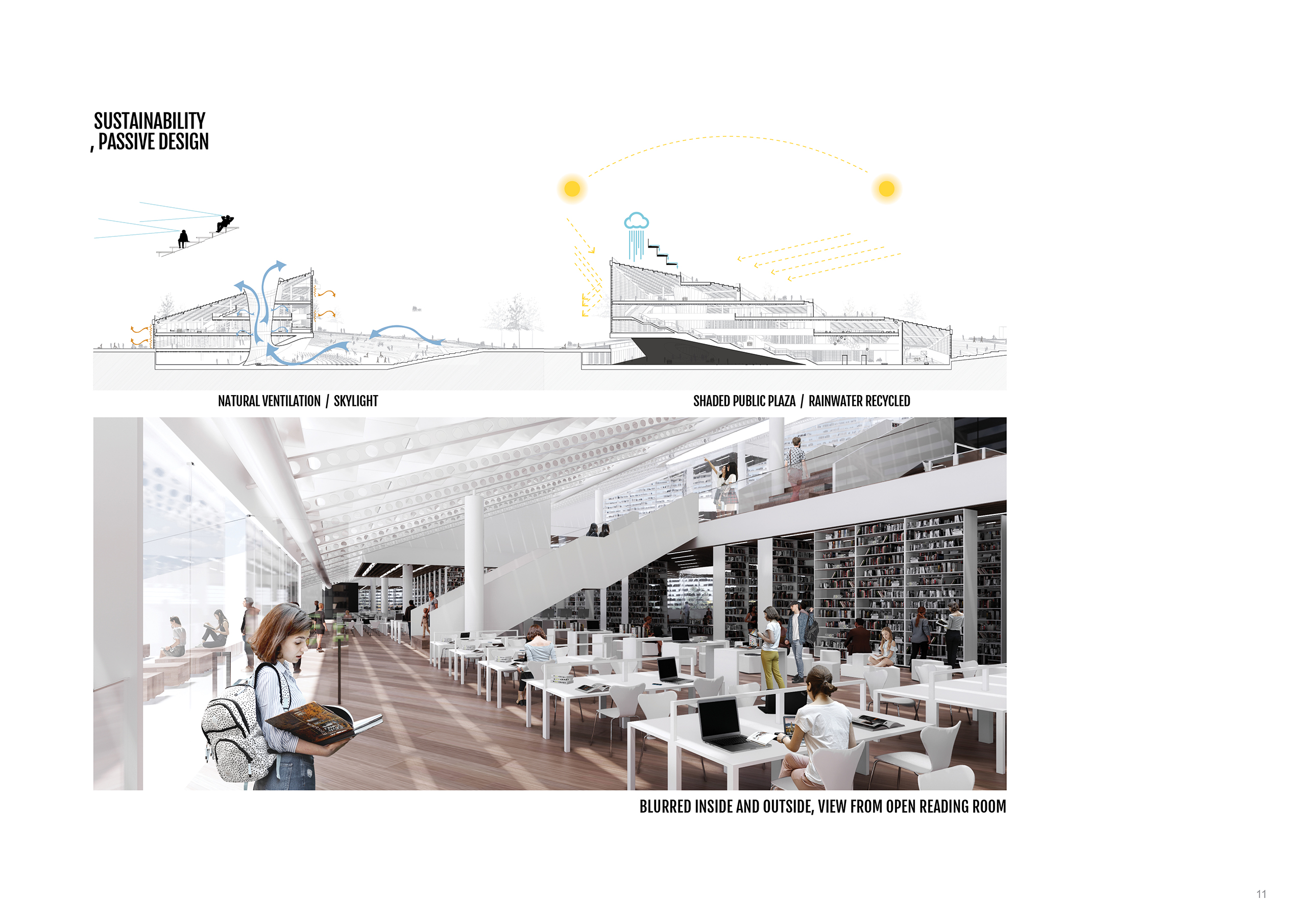
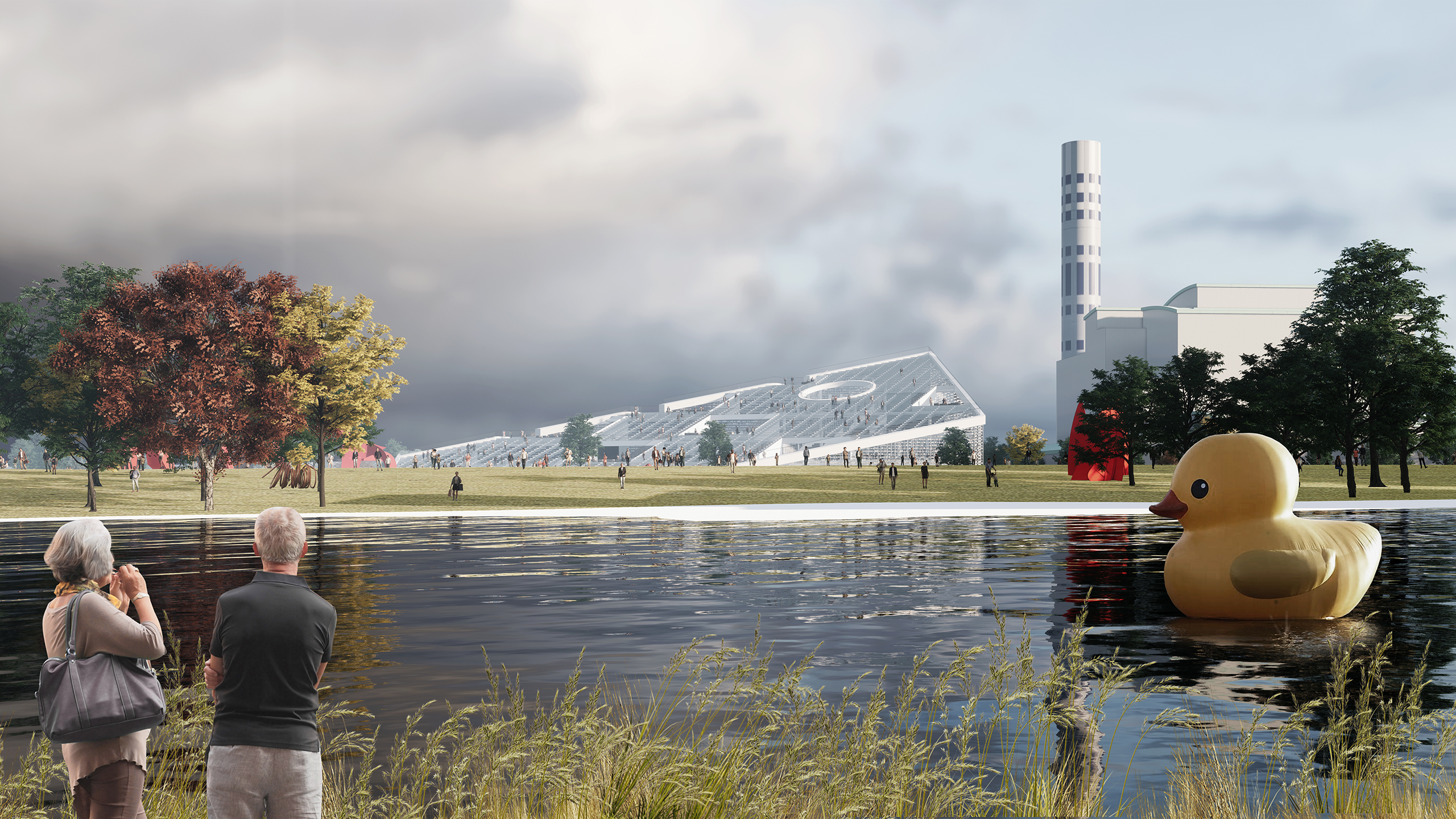
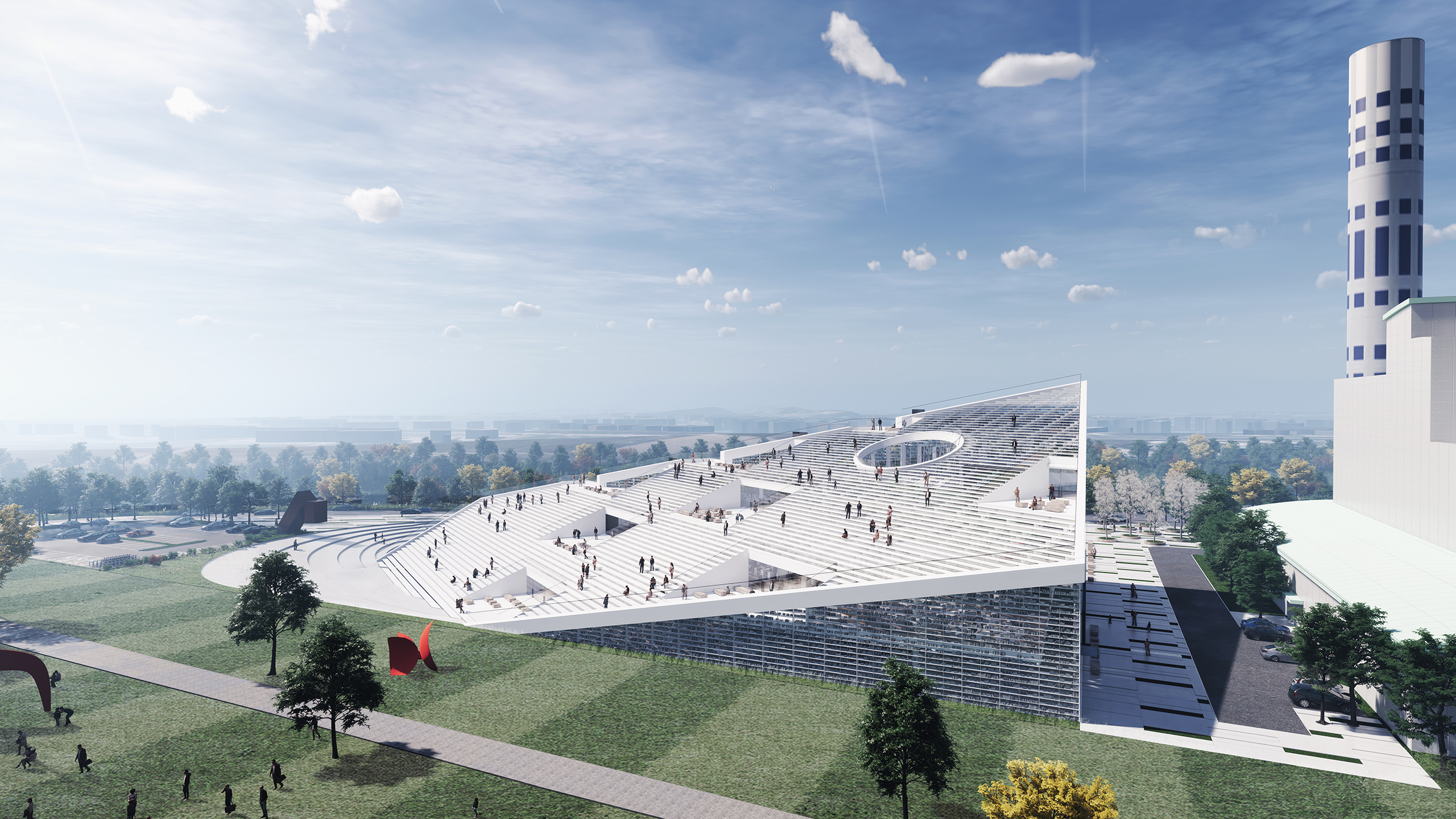
EXTENDED STREET-SCAPE TO ROOF-SCAPE, BLURRED BOUNDARY
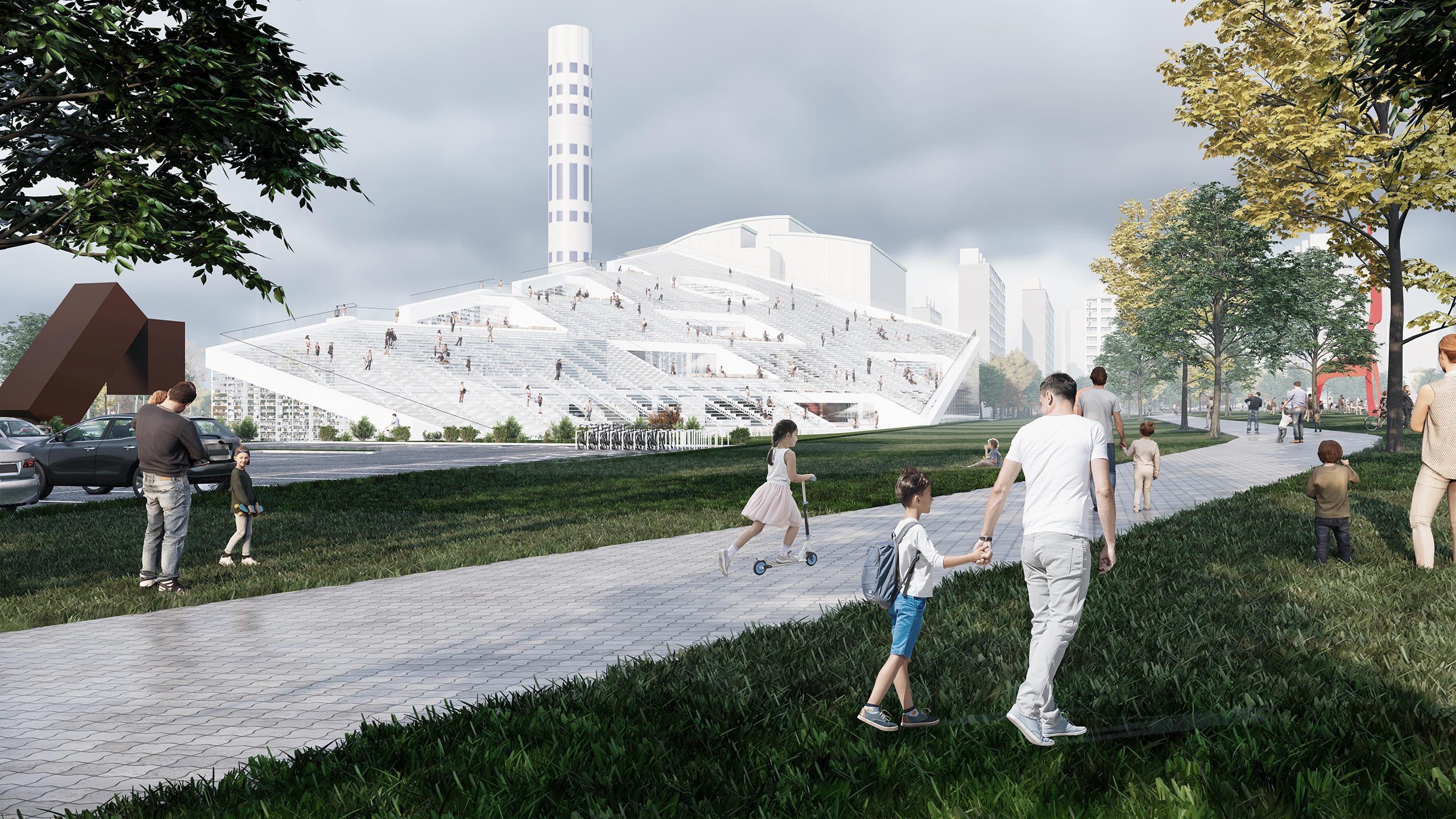
NATURAL ACCESS FROM FUTURE PUBLIC TRANSPORTATION, VIEW FROM WEST
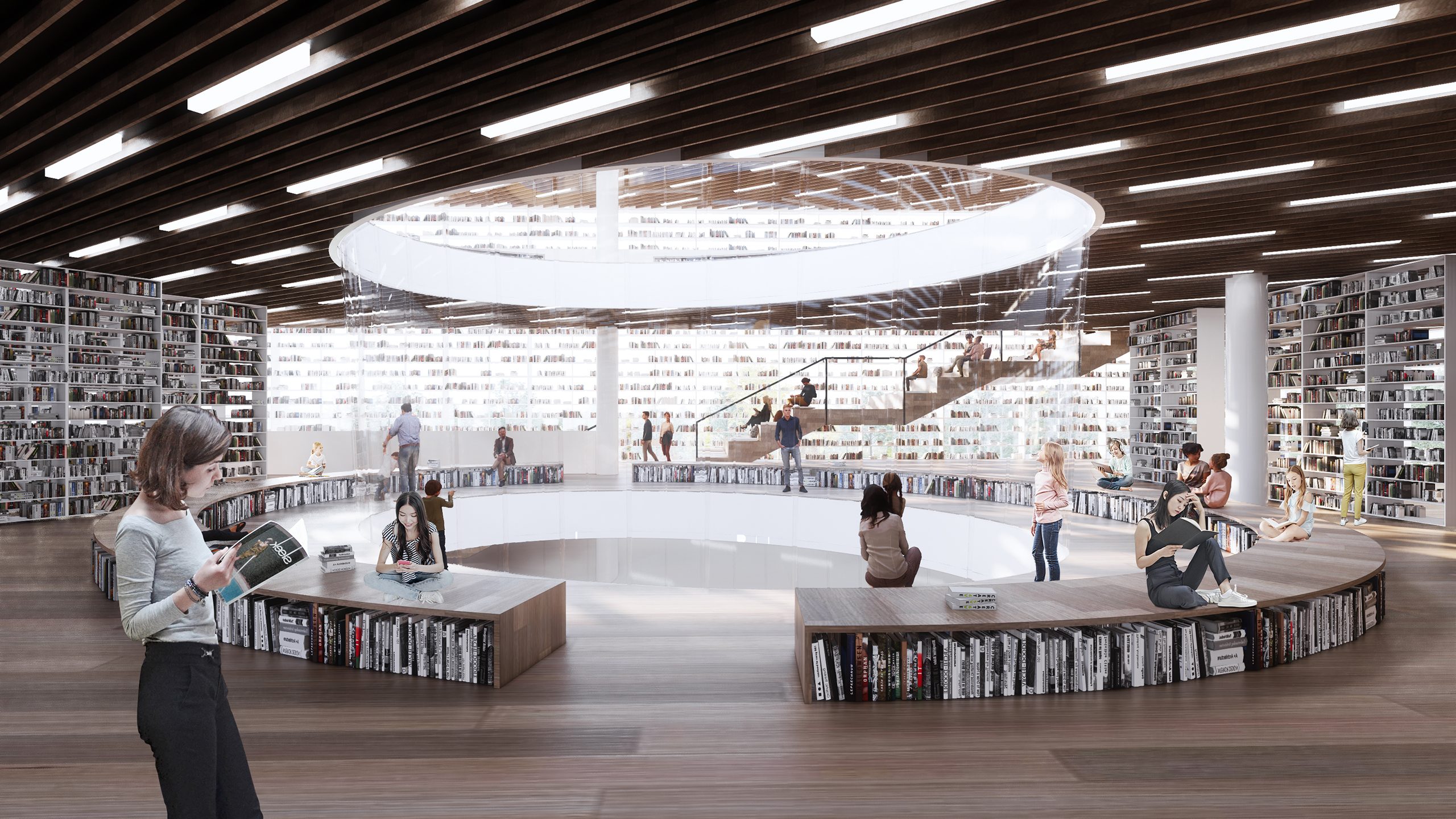
DAYLIGHT AND VENTILATED CENTRAL CIRCULAR LOUNGE ADJACENT STACKS, VIEW FROM 2ND FLOOR LOUNGE TO NORTH
5. Program
Reading desks which have the advantage of two storey heights on the south side have open views and daylight, yet bookshelves were located behind the row of desks under one storey height area for access with convenient.
The entire building facade consists of bookshelves and it allows to accommodate more shelves for books. The facade itself is identified as a collection of books in an urban context.
6. Circulation, LOOP and Openness
It was planned to enter from the main entrance on the lowered ground level on the north side to the fourth floor reading room with continuous amphitheater steps. From the fourth floor reading room, visitors choose to descend along the south library reading room or exit to roof-scape in every floor. It is either a trajectory or a continuous loop that walks through five floors from the basement to the fourth floor as if it were a single space.
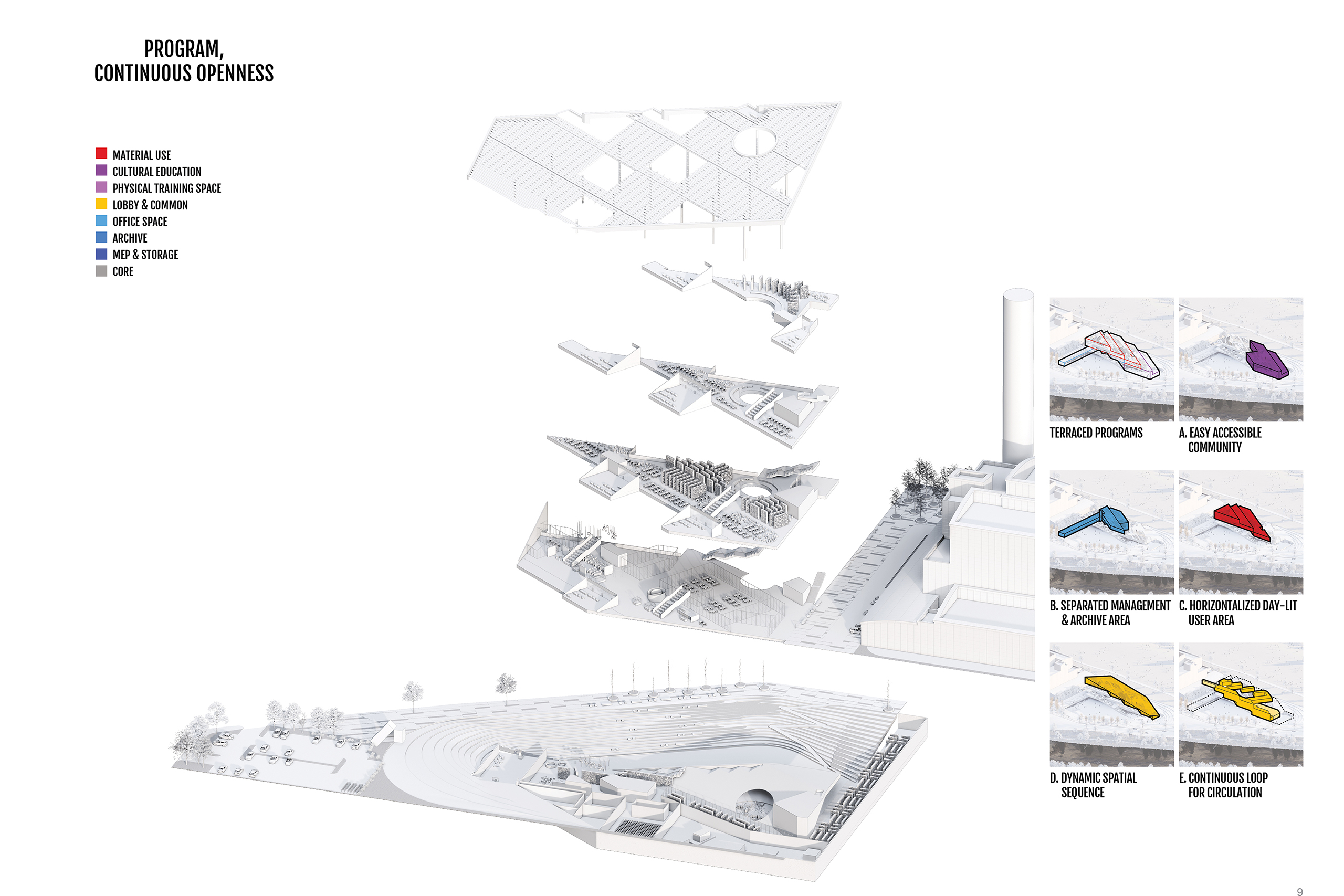
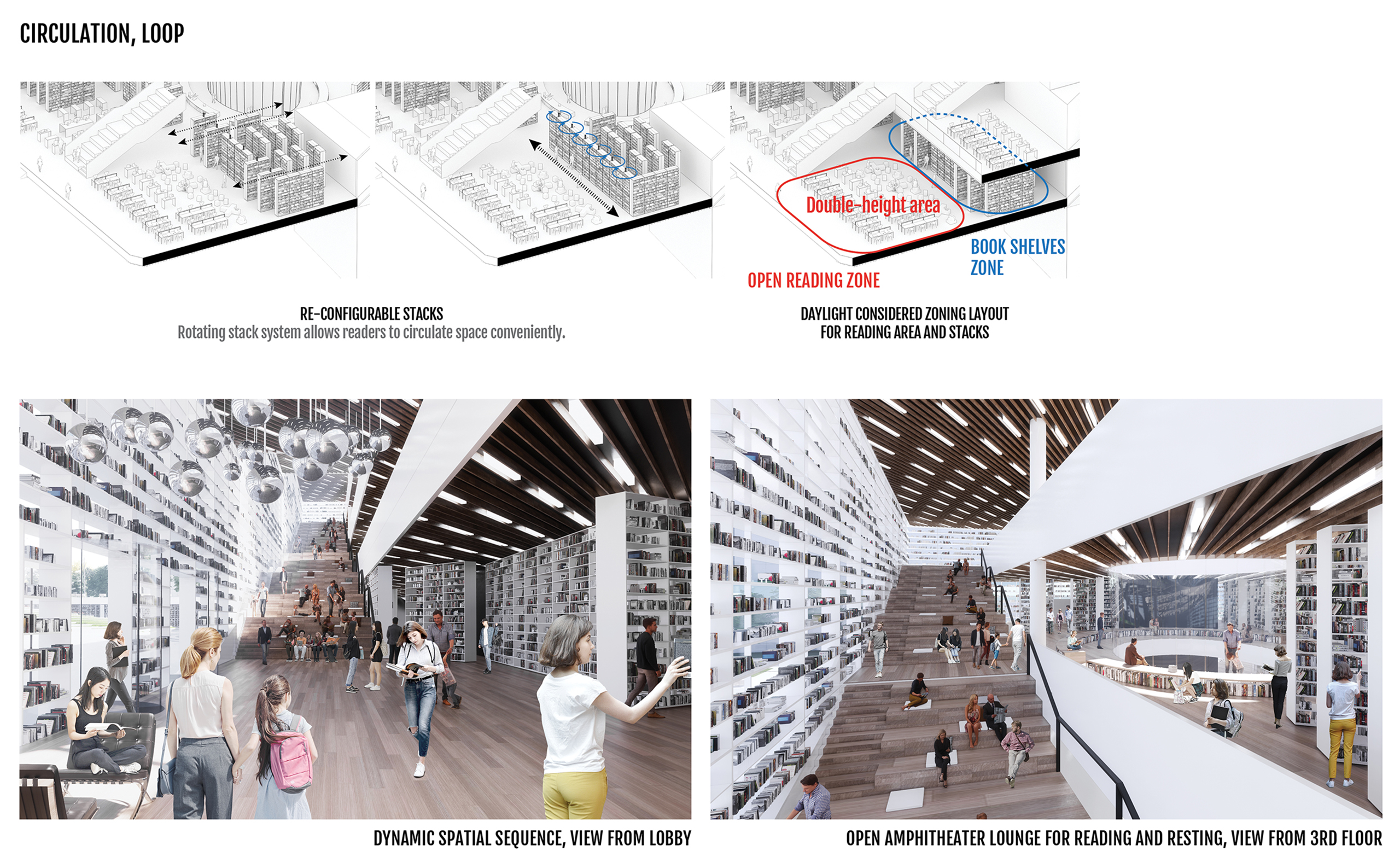
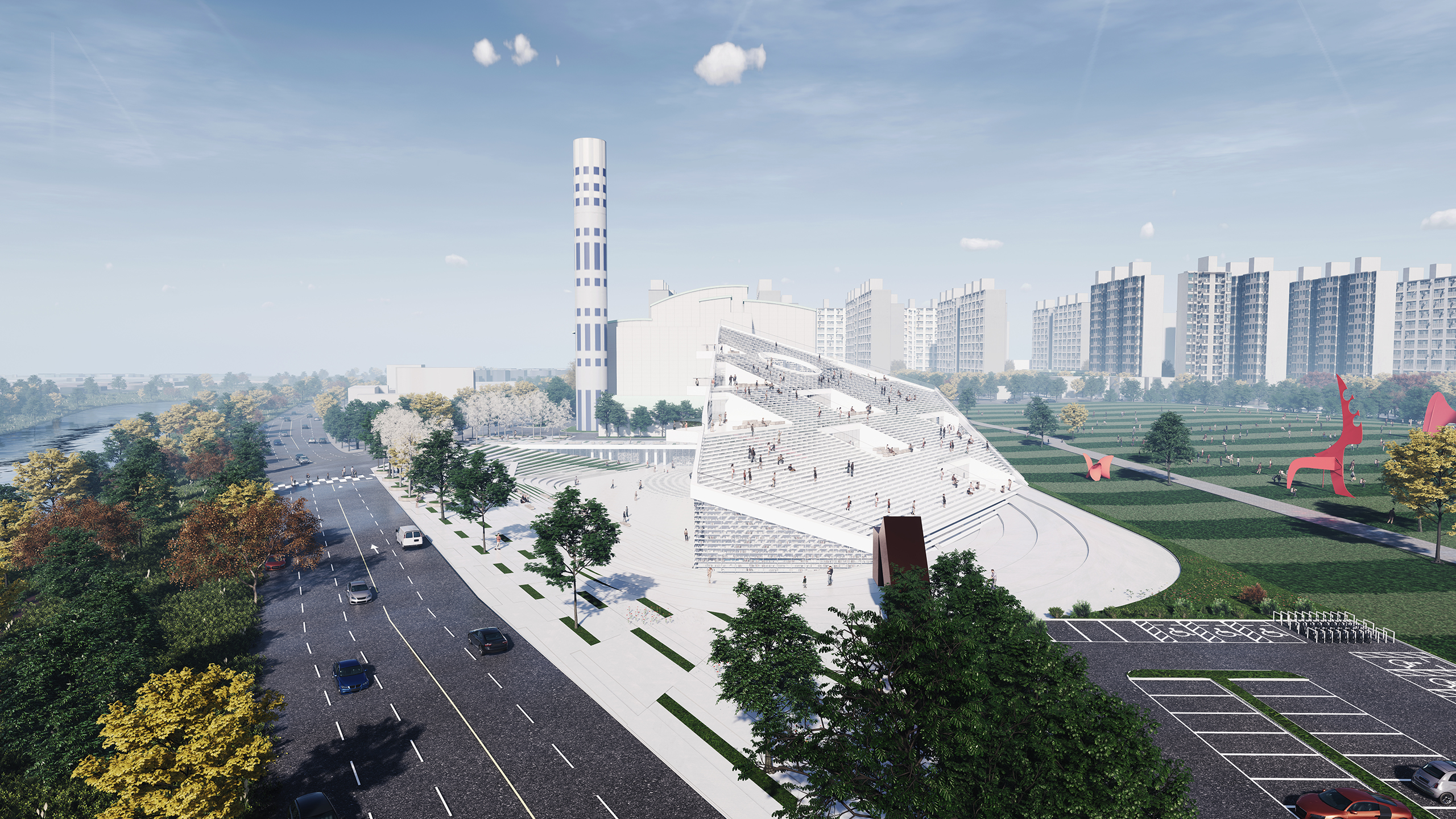
ICONIC ROOF-SCAPE IN GWANGJU METROPOLITAN CITY
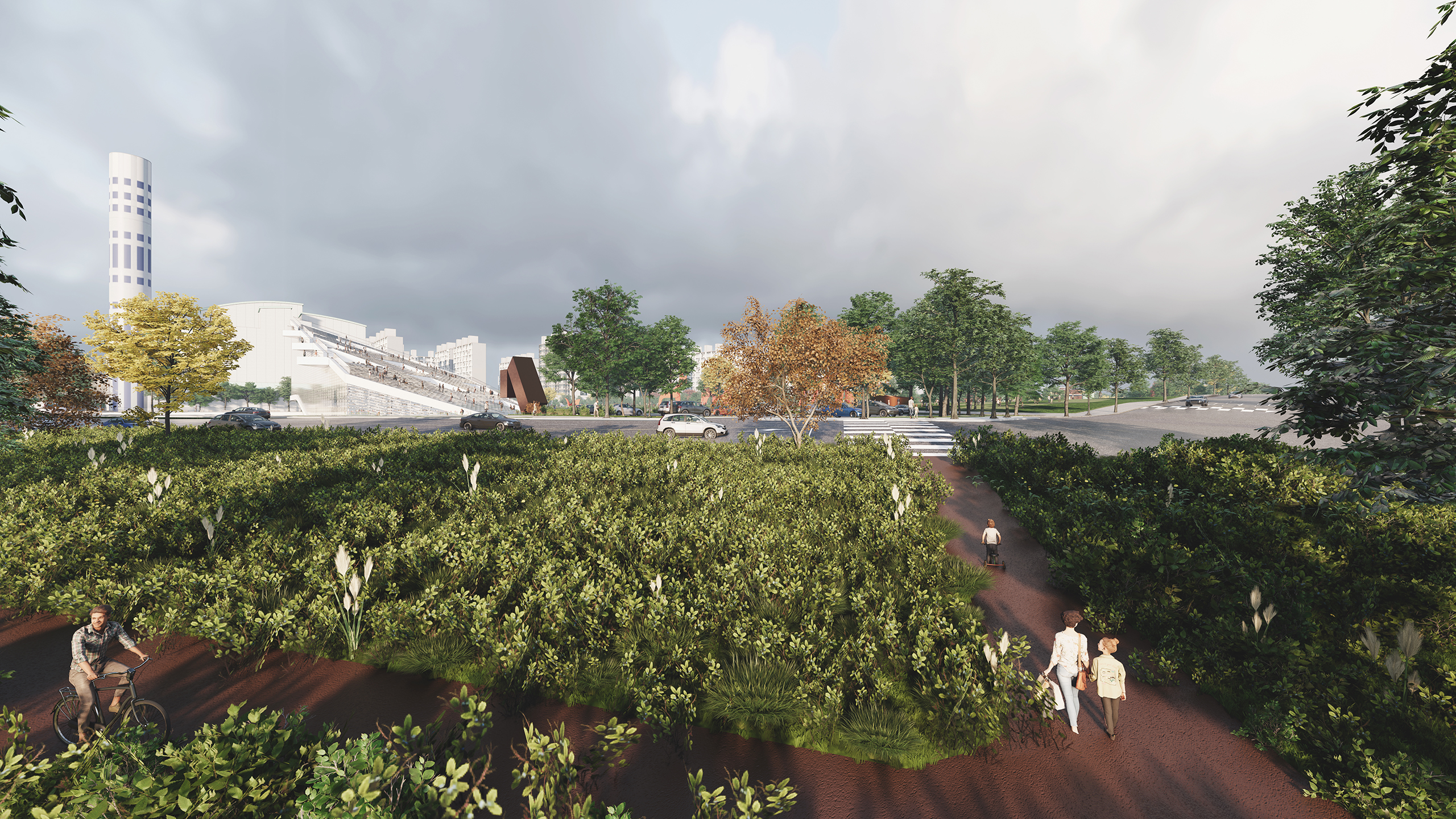
ACTING AS AN ATTRACTOR FOR GATHERING, VIEW FROM PEDESTRIAN PATH IN GWANGJU-CHEON

INTER-WEAVED NATURE AND INFRASTRUCTURE, LANDSCAPE
REFLECTING THE OLD(Power-plant) IN THE NEW, VIEW FROM NORTHWEST
7. Sustainability, Passive Design
1) NATURAL VENTILATION
Avoid accumulation of heat and pollutant inside building.
2) SKYLIGHT
The facade combines minimum solar gain and glare with maximum daylight and translucency. The passive shading will reduce the cooling needs, AC energy consumption.
3) SHADED PUBLIC PLAZA
Underneath space of the floated mass provides shade and a cool place to rest from the summer sun.
4) RAINWATER RECYCLED
A system of drains underneath the roof steps collects rain then carried down to storage tanks in the basement level. This grayed water can be recycled for flushing.
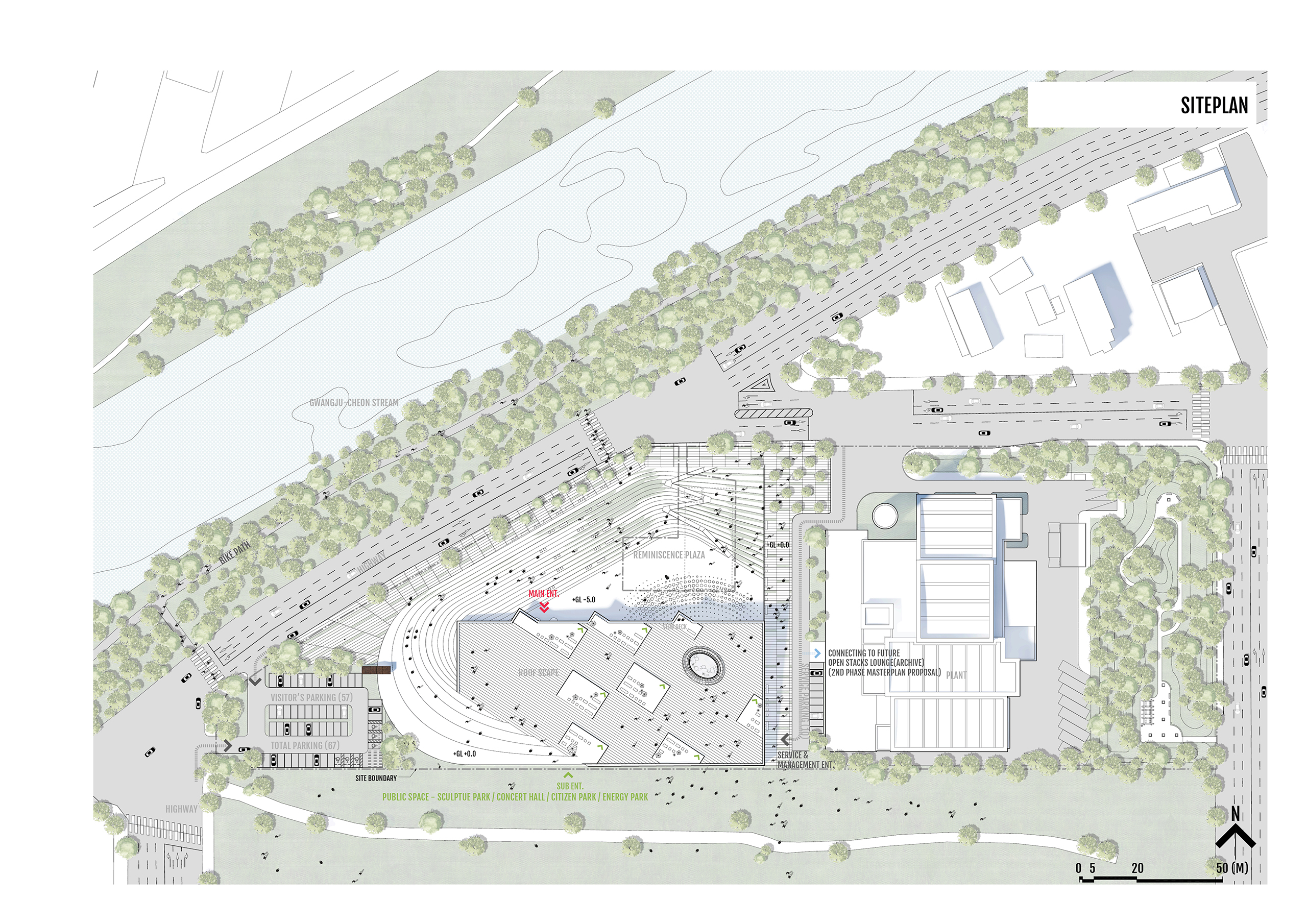
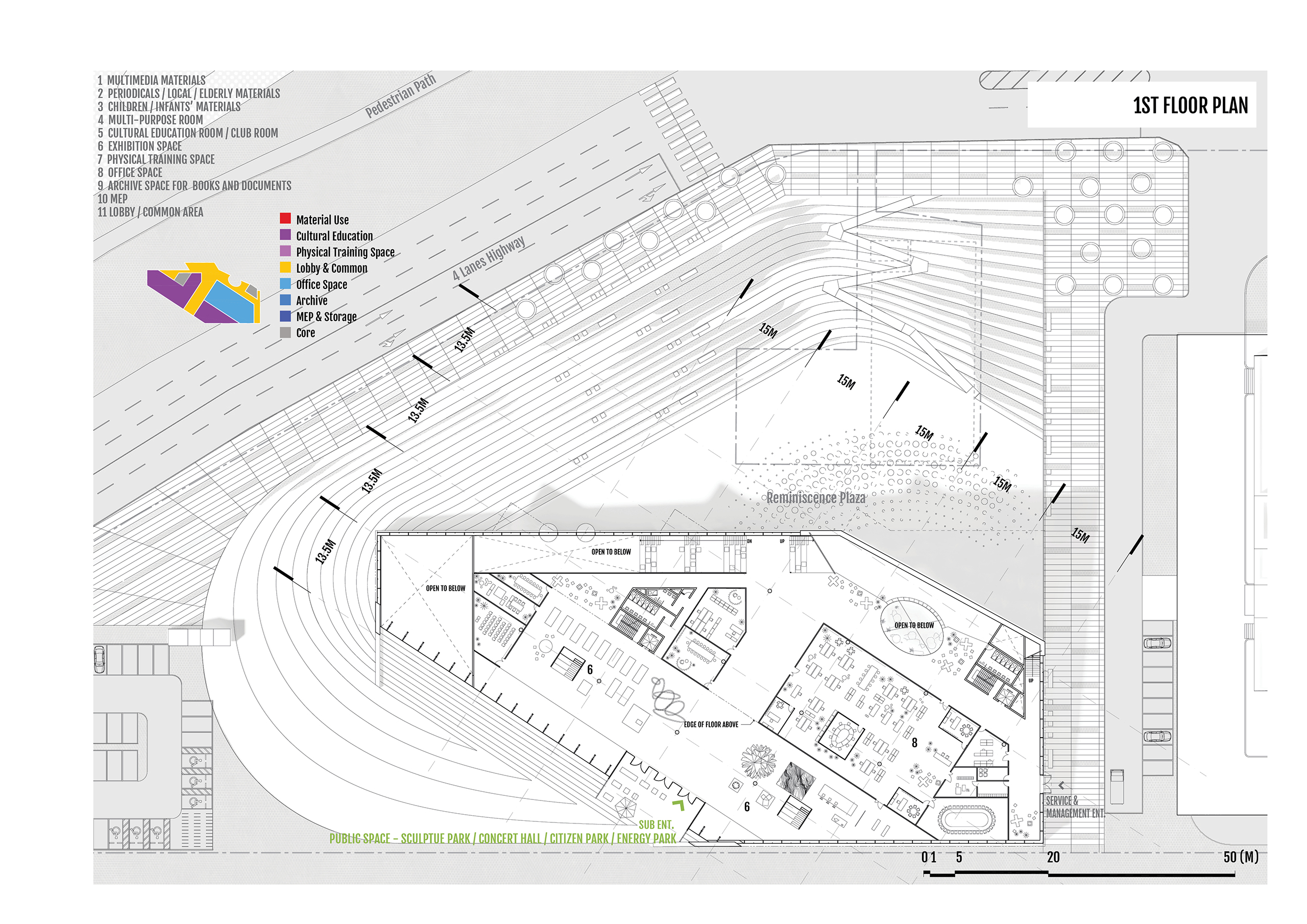
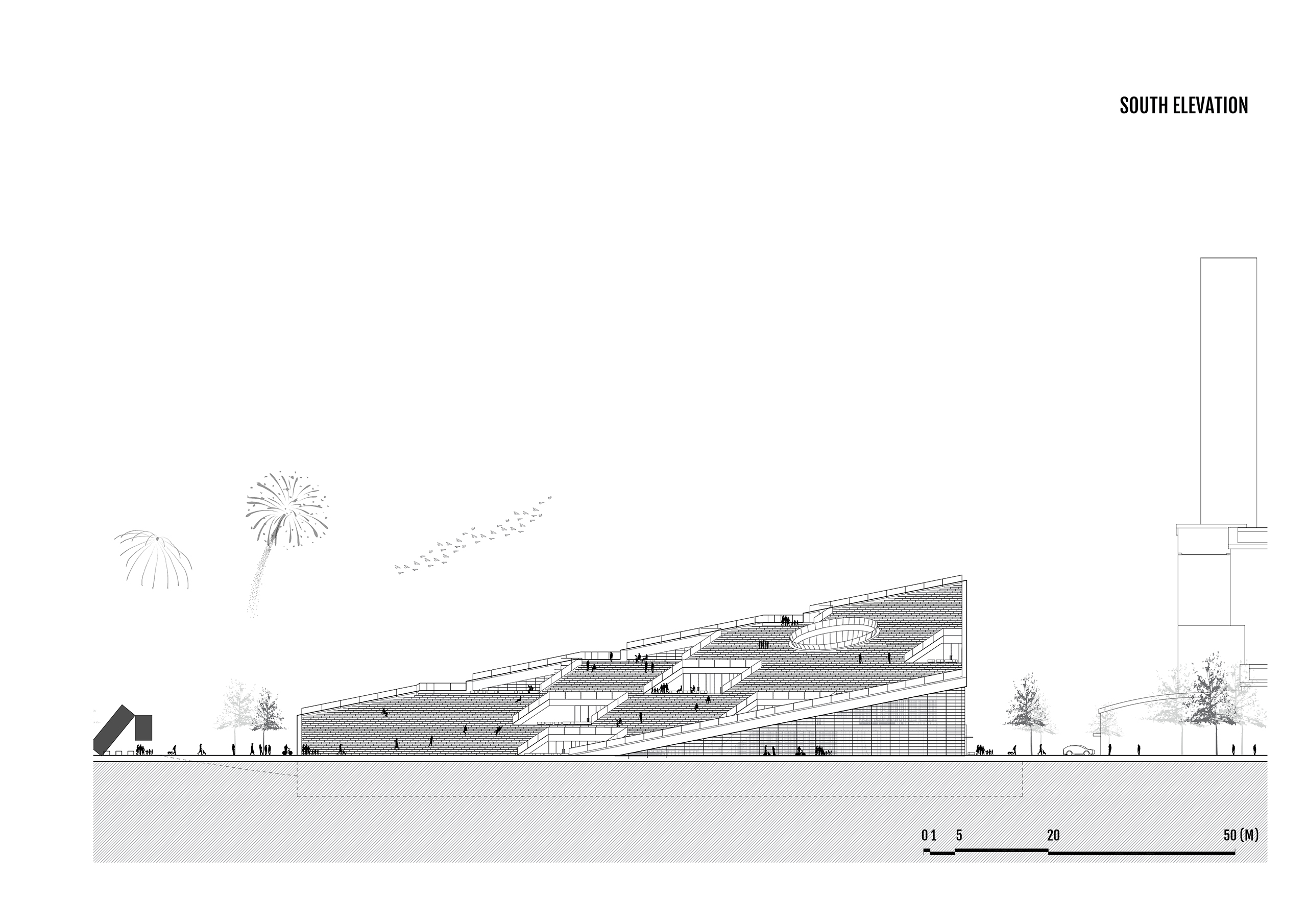
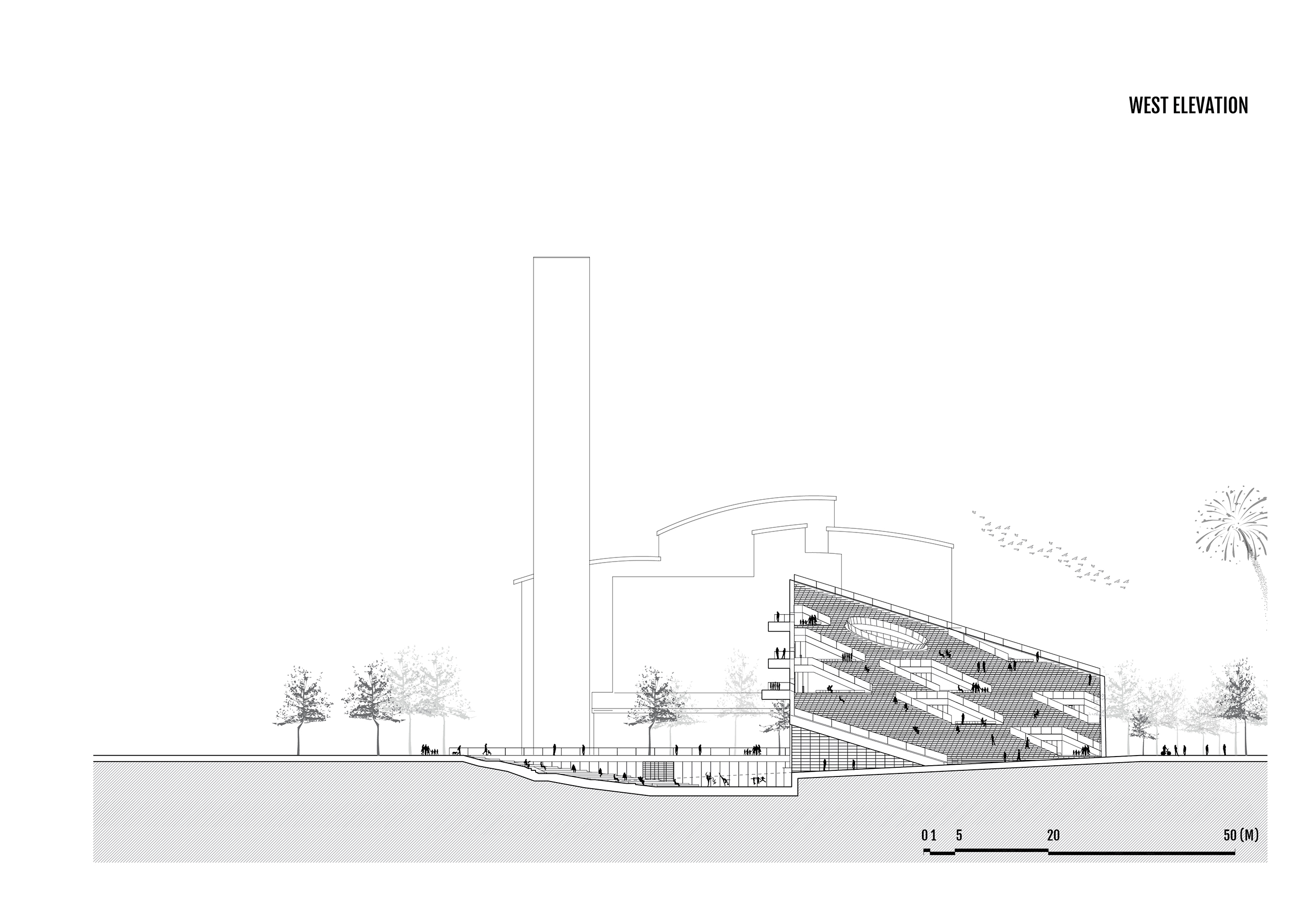
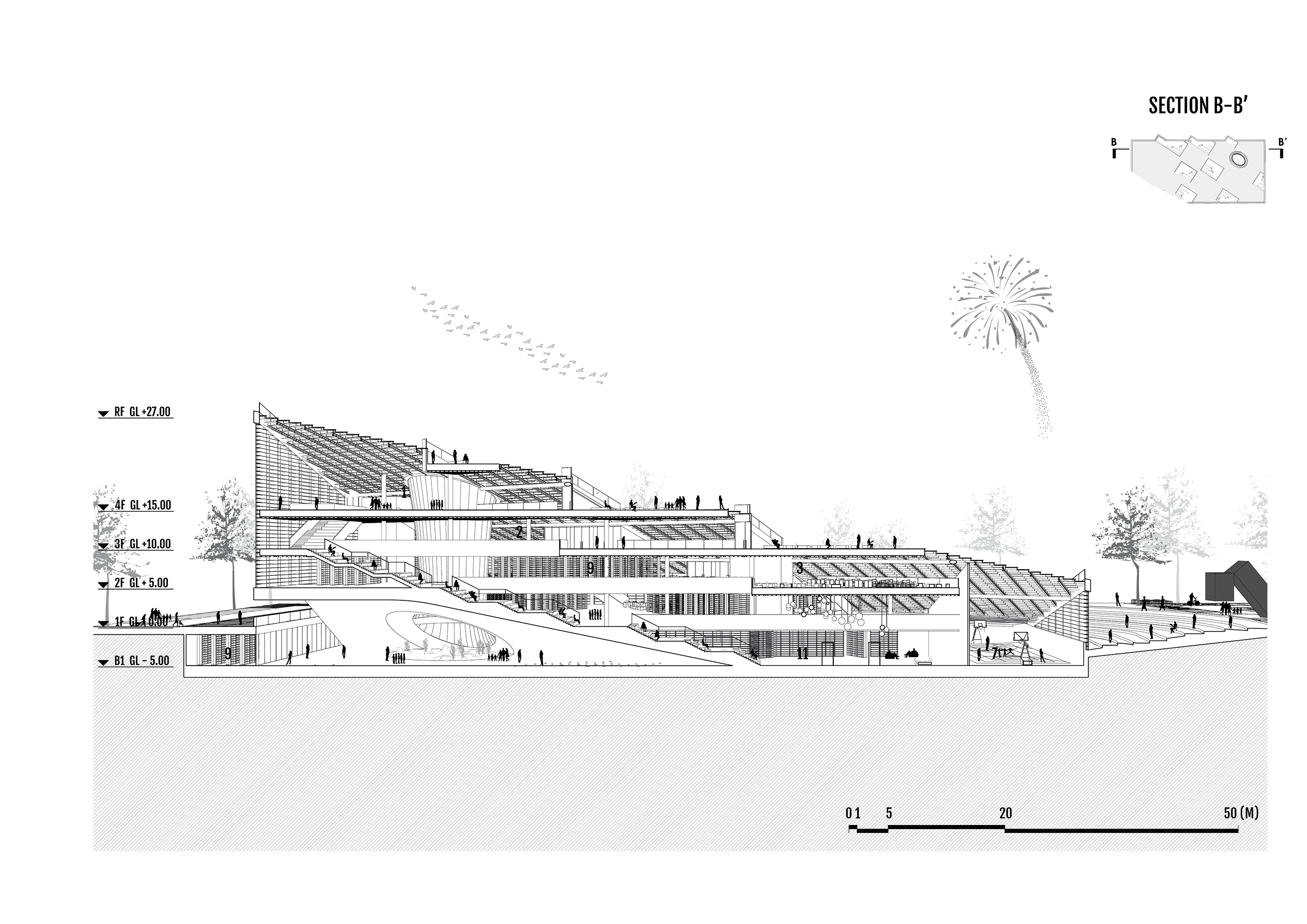
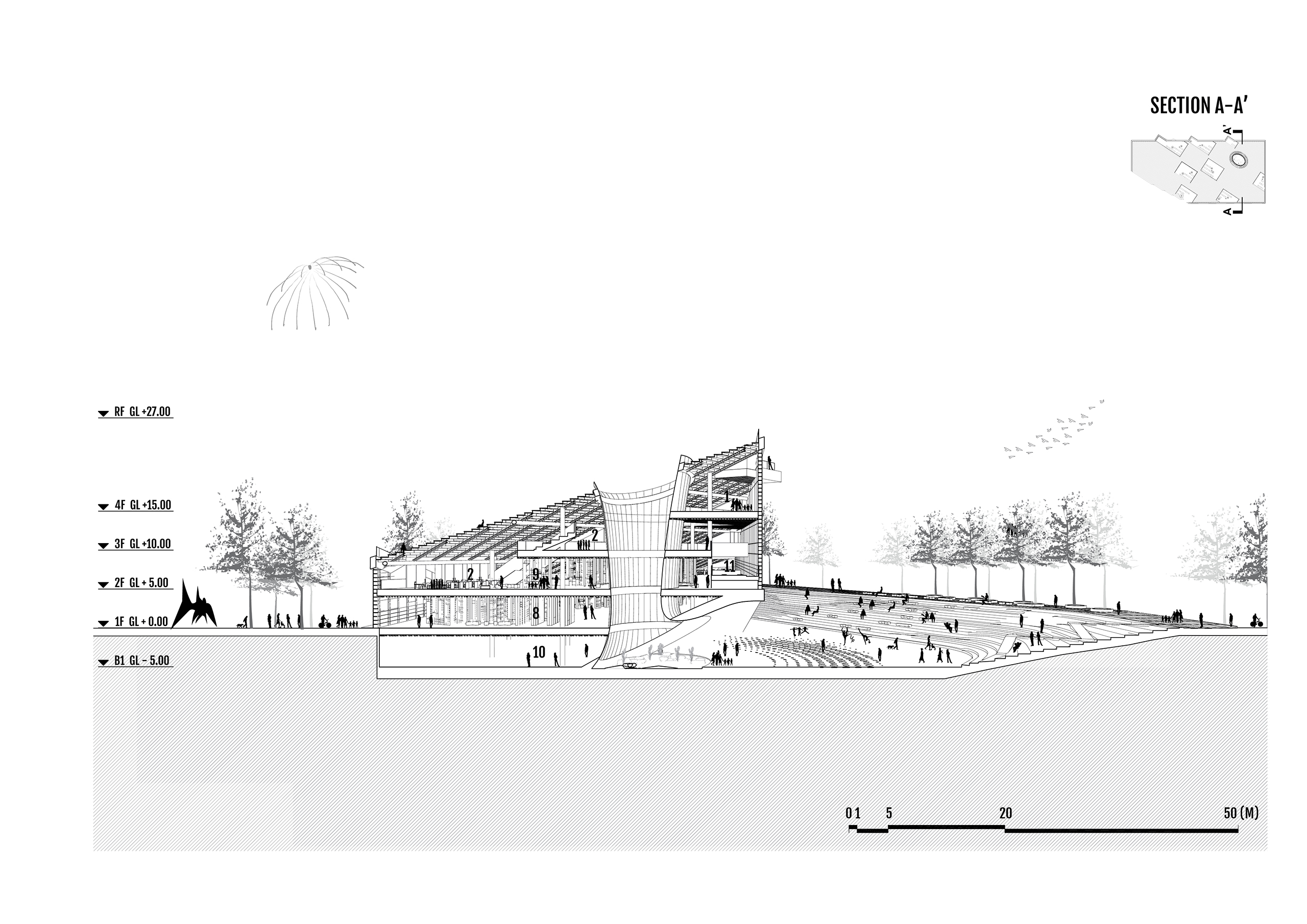
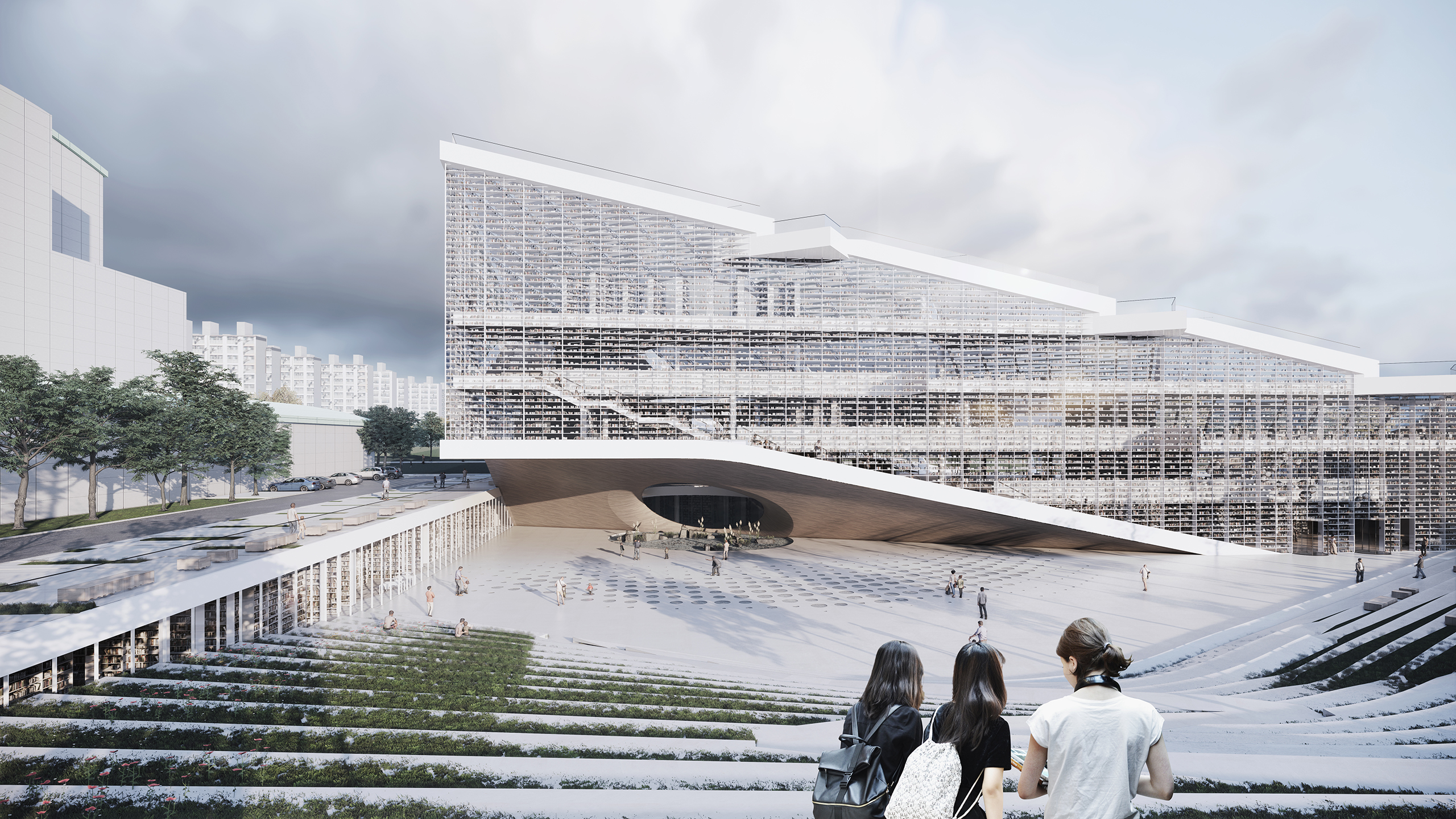
UNEARTHED PLAZA FOR WIND ACCELERATION AND REMINISCENCE
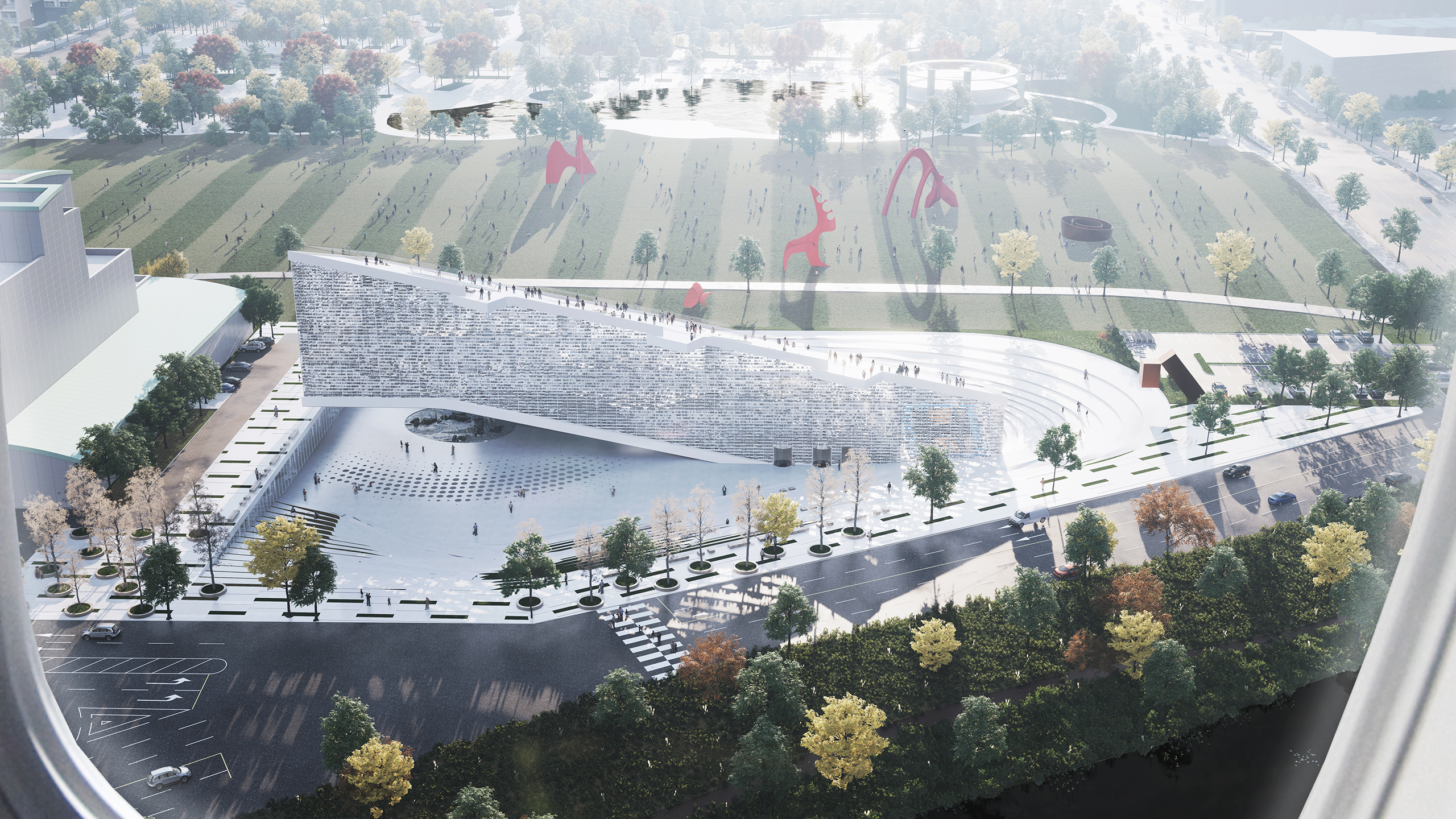
HOMAGE OF “AGORA DEMOCRACY”, VIEW FROM AIRPLANE
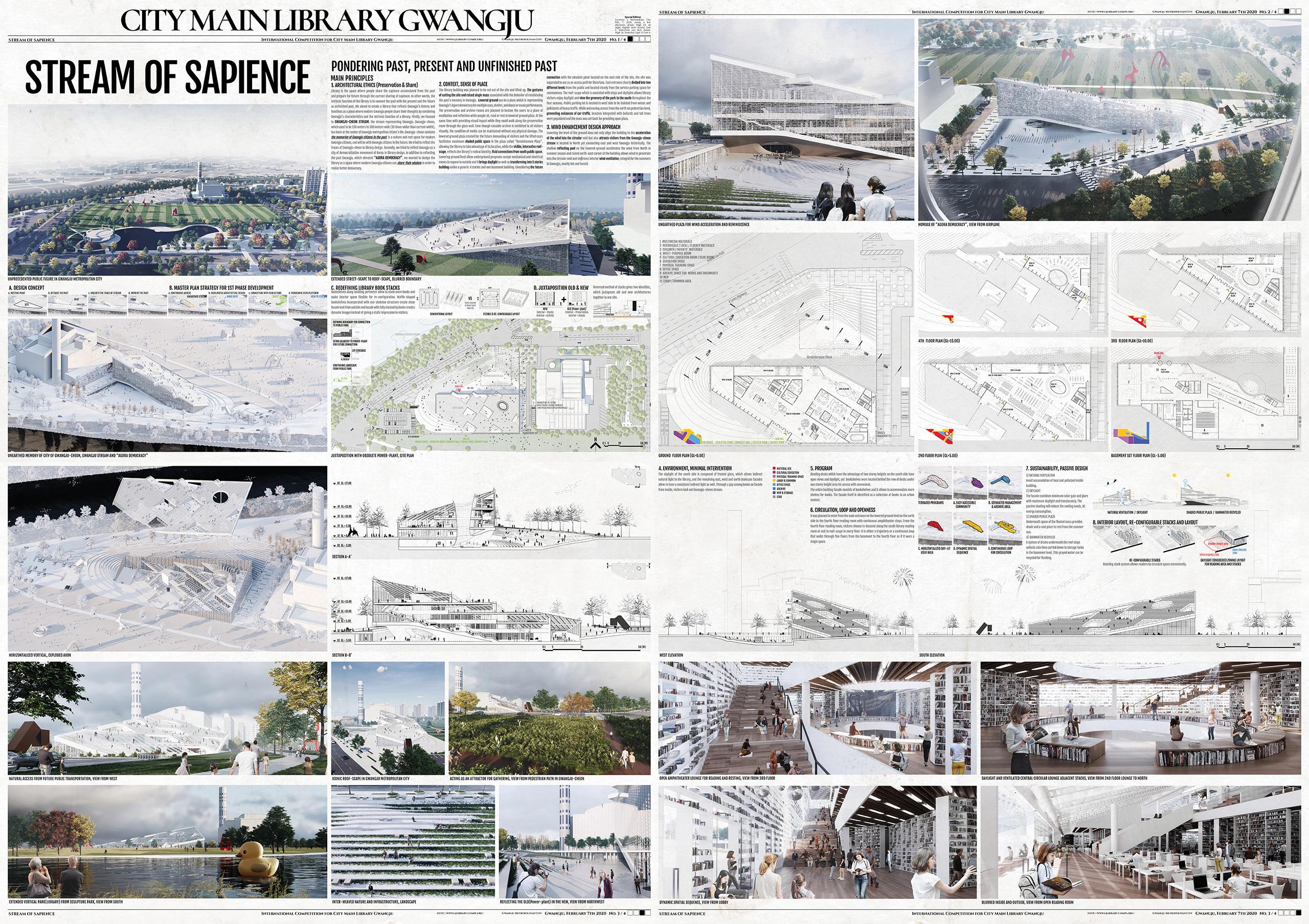 Submission Boards (4 x A1 Board)
Submission Boards (4 x A1 Board)
Can find other winning entries including the 1st prize winner at official competition website:
http://www.gjlibrary-compe.org/
And here is the captured PDF for some of visitors cannot reach out to official website:
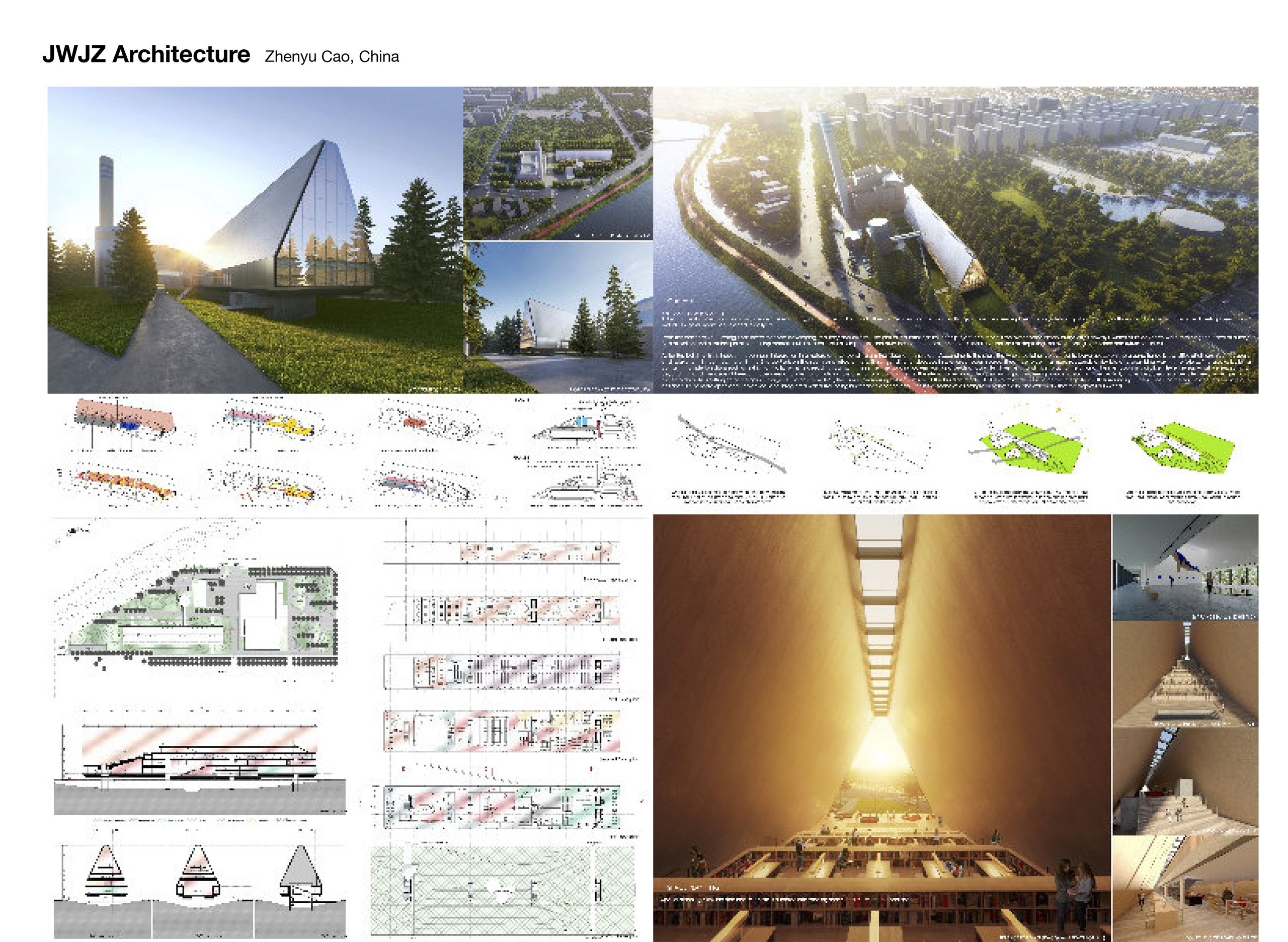

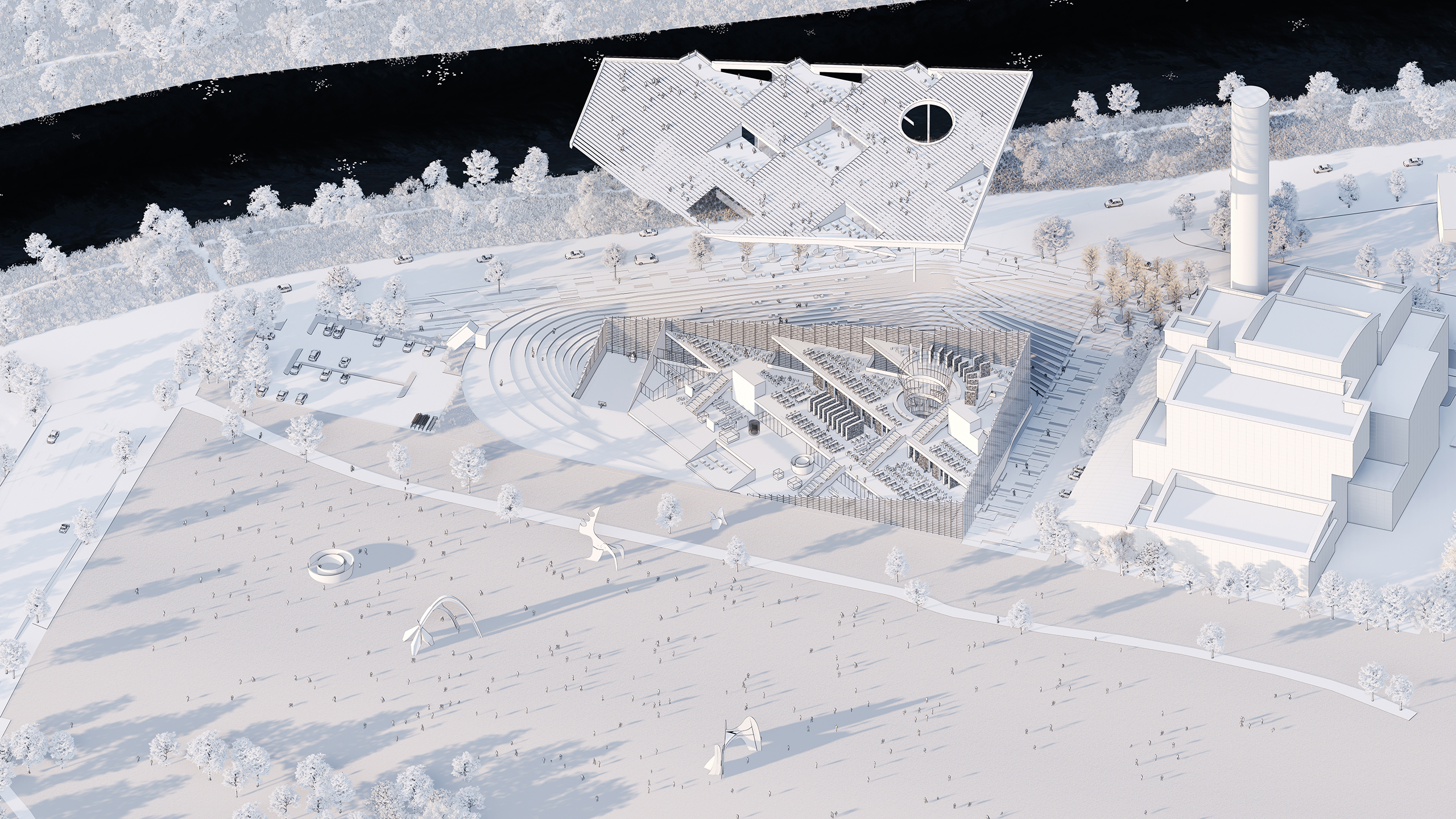
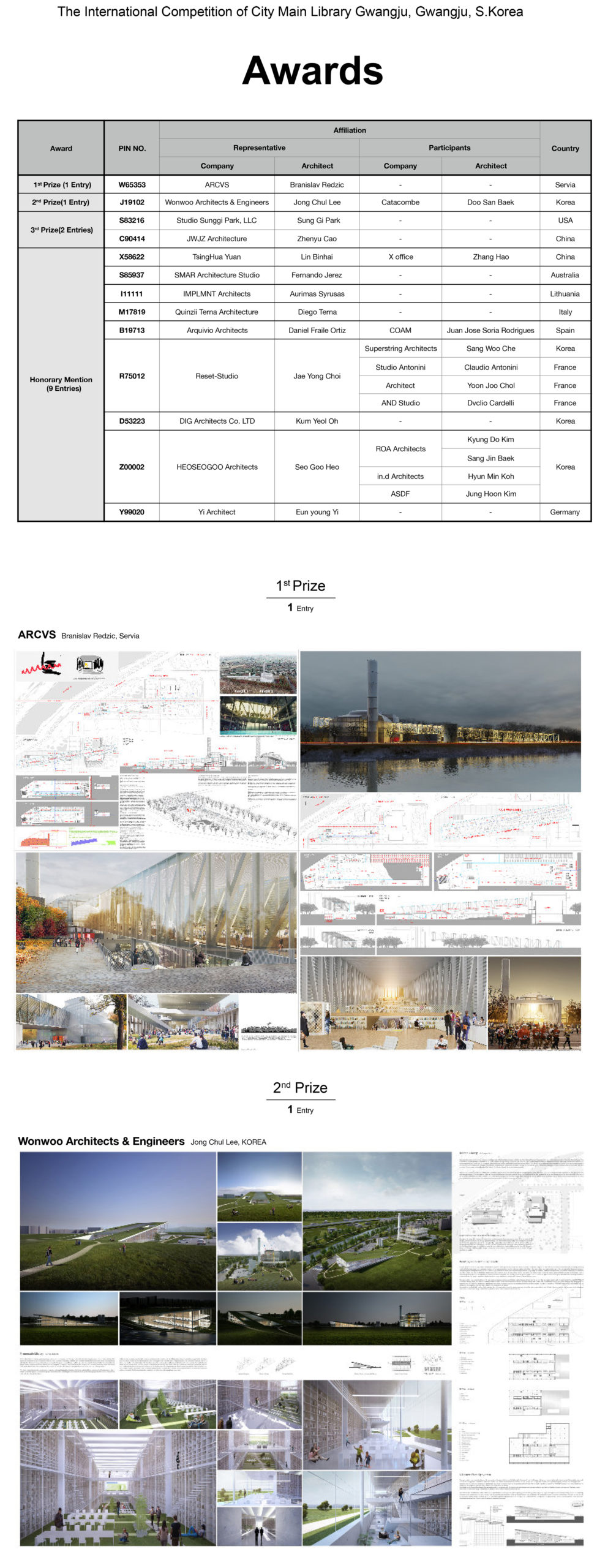

 “3rd Prize”
“3rd Prize”
![[견축학개론] 건축을 잘하려면 꼭 해외 유학을 가야하나요?🤔 건축학과 교수님이 알려주는 해외 건축 유학이 필요한 이유!
[Introduction to Architecture] Do you really need to study abroad to become a good architect? 🤔
건축가의 시선으로 바라보는 흥미로운 건축 이야기! 플레이스 인사이트의 새로운 콘텐츠 '견(見)축학개론'이 소개되었습니다. 첫 번째 이야기에서는 많은 건축가와 건축학도들이 공통적으로 고민하는 주제인 “해외 건축 유학은 왜 필요할까?”를 다뤘습니다.
Place Insight’s new series “Introduction to Architecture” features a discussion on a question many architects and students share: “Why study architecture abroad?”
서른이 넘은 나이에 유학을 결심하게 된 개인적인 경험부터, 하버드에서의 배움, OMA·BIG·파리 사무실에서 쌓은 실무 이야기까지 현장에서 느낀 고민과 배움에 대해 이야기를 나누었습니다. 인터넷 정보로는 알기 어려운 건축 교육의 차이, 미국·유럽·스위스·영국 주요 학교들의 분위기, 학부와 대학원 유학의 선택 기준, 그리고 언어·취업·커리어 공백 같은 현실적인 고민들을 다루었습니다.
The video reflects on studying overseas in one’s thirties, experiences at Harvard and at firms such as OMA, BIG, and studios in Paris, and the differences found in architectural education around the world. It also touches on important considerations including school culture, program selection, language, employment, and career gaps, offering a grounded perspective on pursuing architectural studies abroad.
자세한 내용은 플레이스인사이트 Youtube에서 확인하실 수 있습니다.
For more details, please visit PlaceInsight Youtube.
출처: 플레이스인사이트 PLACE INSIGHT
https://www.youtube.com/watch?v=rdpQgh8gH-o
@place_zine
#SSP #Architecture #Architect #Architecturaldesign #Youngarchitect #PlaceInsight #HarvardGSD #OMA #BIG #ArchitecturalPractice #ArchitectureStudyAbroad #StudyAbroad #ArchitectureEducation #ArchitectureSchool #에스에스피건축사사무소 #박성기 #건축가 #건축 #젊은건축가 #플레이스인사이트 #견축학개론 #건축유학 #해외건축유학 #건축공부 #건축이야기 #유학](https://sspsup.com/Ver6/wp-content/uploads/2025/07/590936453_18429873184129907_3780197652428080688_n-360x640.avif)
![[견축학개론] 건축 유학 준비, 어디서부터 손 대야 할지 모르겠다면? 영상과 함께 차근차근 준비하세요! 📝
[Introduction to Architecture] Preparing to study architecture abroad: Not sure where to start? 📝
건축가의 시선으로 바라보는 흥미로운 건축 이야기! 플레이스 인사이트의 새로운 콘텐츠 '견(見)축학개론'이 소개되었습니다. 두번째 이야기에서는 많은 학생들이 가장 어려워하는 해외 건축 유학 준비의 시작점을 다뤘습니다.
Place Insight’s new series “Introduction to Architecture” explores a topic many students struggle with: where and how to begin preparing for architecture studies abroad.
포트폴리오 구성 방법부터 학업계획서(SOP), 추천서(LOR) 준비 과정, 필요한 시험과 비자 인터뷰까지 해외 건축 유학을 준비하며 겪게 되는 현실적인 과정과 고민들에 대해 이야기를 나누었습니다. 포트폴리오 스타일의 차이, 학교가 선호하는 지원자의 특징, 활동·경력 관리 방법, 시험 준비 전략 등 실제 유학 준비 흐름을 기반으로 한 실용적인 팁들을 다루었습니다.
The video explains the key steps and challenges in preparing for architecture studies abroad, including creating a portfolio, writing a strong Statement of Purpose and recommendation letters, preparing for required exams, and managing the visa process. It also highlights what schools look for in applicants, differences in portfolio styles, and practical tips for organizing experience and study plans.
자세한 내용은 플레이스인사이트 Youtube에서 확인하실 수 있습니다.
For more details, please visit PlaceInsight Youtube.
출처: 플레이스인사이트 PLACE INSIGHT
https://www.youtube.com/watch?v=sxqh-Jh9Rvg
@place_zine
#SSP #Architecture #Architect #Architecturaldesign #Youngarchitect #PlaceInsight #ArchitecturePortfolio #Portfolio #SOP #ArchitecturalPractice #ArchitectureStudyAbroad #StudyAbroad #ArchitectureEducation #ArchitectureSchool #에스에스피건축사사무소 #박성기 #건축가 #건축 #젊은건축가 #플레이스인사이트 #견축학개론 #건축유학 #해외건축유학 #건축입시 #포트폴리오준비 #건축공부 #건축이야기 #유학](https://sspsup.com/Ver6/wp-content/uploads/2025/07/590872135_18429873220129907_5854990682638555617_n-360x640.avif)
![[견축학개론] 수백만 원 주고 맡기는 SOP? 스스로 작성해도 되는 이유 📝
[Introduction to Construction Engineering] Why You Should Pay Millions of Won for an SOP? 📝
건축가의 시선으로 바라보는 흥미로운 건축 이야기! 플레이스 인사이트의 새로운 콘텐츠 '견(見)축학개론'이 소개되었습니다. 세번째 이야기에서는 해외 유학을 준비할 때 꼭 알아두어야 할 “학업계획서(SOP)는 어떻게 작성해야 할까?”를 다뤘습니다
Place Insight’s new series “Introduction to Architecture” looks at an essential question for many study-abroad applicants: how to write an effective Statement of Purpose (SOP).
학업계획서(SOP)의 역할부터 스스로 작성하는 방법, 학교가 중요하게 보는 평가 요소까지 해외 건축 유학을 준비할 때 꼭 알아야 할 핵심 내용들을 다뤘습니다. 유학원 도움 없이 SOP를 쓰는 과정에서 겪는 고민, 지원 동기 구성법, 학교 프로그램과의 적합성 설명, 구체적인 경험 제시, 미래 기여도를 어필하는 방법 등 실제 합격 경험을 바탕으로 한 실용적인 조언과 함께 학교별 맞춤 SOP의 중요성, 문서 구성과 분량 팁 등 SOP 작성 시 유의해야 할 요소들 등을 다루었습니다.
This episode introduces the essential points of writing an effective Statement of Purpose (SOP) for architecture studies abroad, including how to write it on your own, what schools look for, and how to present your motivation and experience clearly. It also provides practical tips on tailoring your SOP to each program and organizing the document in a clear and compelling way.
자세한 내용은 플레이스인사이트 Youtube에서 확인하실 수 있습니다.
For more details, please visit PlaceInsight Youtube.
출처: 플레이스인사이트 PLACE INSIGHT
https://www.youtube.com/watch?v=UMu_MPL8oqM
@place_zine
#SSP #Architecture #Architect #Architecturaldesign #Youngarchitect #PlaceInsight #ArchitecturePortfolio #Portfolio #SOP #ArchitecturalPractice #ArchitectureStudyAbroad #StudyAbroad #ArchitectureEducation #ArchitectureSchool #에스에스피건축사사무소 #박성기 #건축가 #건축 #젊은건축가 #플레이스인사이트 #견축학개론 #건축유학 #해외건축유학 #SOP작성법 #건축입시 #포트폴리오준비 #건축공부 #건축이야기 #유학](https://sspsup.com/Ver6/wp-content/uploads/2015/07/589337420_18429872299129907_5073770148780494564_n-360x640.avif)
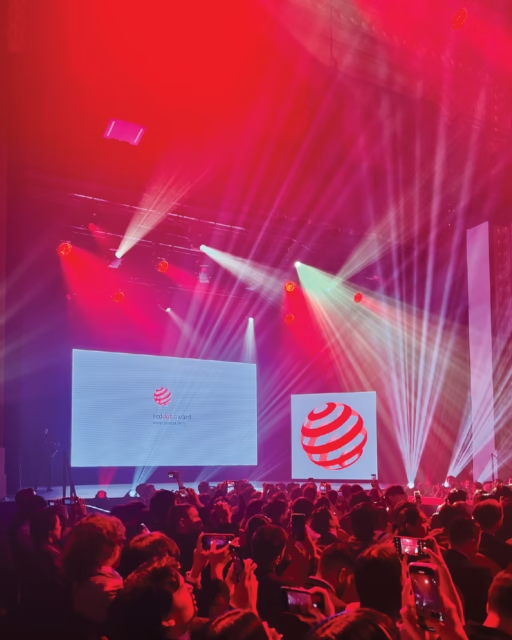
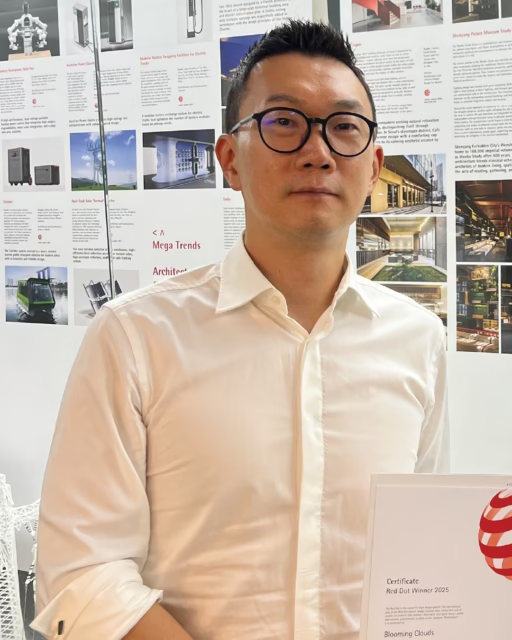
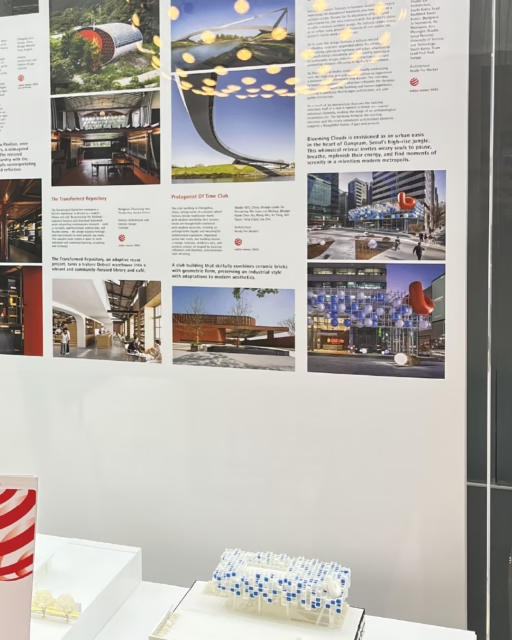
!['Blooming Clouds' 유튜브 소개 영상
'Blooming Clouds' YouTube introduction video
[플레이스 매거진] 테헤란로 보행자를 위한 오아시스 | 건축가가 설계한 빗썸 라운지 삼성점
[Place Magazine] An Oasis for Pedestrians on Teheran-ro | Bithumb Lounge Samsung Branch by Architecture
테헤란로 보행자를 위한 오아시스 'Blooming Clouds'가 플레이스인사이트 유튜브 채널에서 다뤄졌습니다.
"The pedestrian oasis on Teheran-ro, 'Blooming Clouds,' was featured on the Place Insight YouTube channel."
테헤란로 중심부에 위치한 1,300제곱피트(약 30평) 부지에 지어진 빗썸 라운지 삼성점.
클라이언트와 건축가는 암호화폐 거래소의 무형적 이미지를 구현하는 건물을 세심하게 설계했습니다.
그 결과 도심 속 "사막의 오아시스"처럼 휴식과 사색의 공간이 탄생했습니다.
도시에서는 보기 드문 절벽을 연상시키는 인공 벽부터, 반은 건물이고 반은 조경인 외부 공간,
그리고 도시를 생각하게 하는 여유로운 입구까지. 북적이는 테헤란로 속에서도 자연의 여유로움을 느낄 수 있는 빗썸 라운지 삼성점을 경험해 보세요!
(일부 발췌)
Built on a 1,300-square-foot site in the heart of TeheranRo, Bithumb Lounge Samsung Branch
The client and architect meticulously crafted a building that embodies the intangible image of a cryptocurrency exchange.
This resulted in a space of relaxation and contemplation, like an "oasis in the desert," within the heart of the city.
From the artificial wall reminiscent of a cliff, a rare sight in the city,
to the exterior space, half building, half landscaping,
and the leisurely entrance that invites contemplation of the city.
Experience Bithumb Lounge Samsung Branch, where you can experience the leisurely pace of nature even in the midst of the bustling TeheranRo!
(Excerpt)
자세한 내용은 플레이스인사이트에서 확인하실 수 있습니다.
For more details, please visit PlaceInsight.
출처: 플레이스인사이트 PLACE INSIGHT
https://www.youtube.com/watch?v=5RX7dYqTk2U
📍 서울특별시 강남구 대치동 945-2, 3, 4 필지
📍 945-2, 3, 4 Daechi-dong, Gangnam-gu, Seoul, South Korea
Youtube: 플레이스인사이트 PLACE INSIGHT
@place_zine @clark____03 @ms_ar_h
#SSP #SeoulArchitecture #Youngarchitect #Architecture #UrbanDesign #PlaceInsight #PublicSpace #Gangnam #Seoul #Oasis #SustainableDesign #ArchitectureLovers #DesignStudio #Cityscape #UrbanOasis #에스에스피건축사사무소 #박성기 #건축가 #건축 #젊은건축가 #플레이스인사이트 #강남 #삼성역 #디자인 #공공건축 #오아시스 #비썸라운지삼성점](https://sspsup.com/Ver6/wp-content/uploads/2025/08/536676010_18413794948129907_7624276764730822351_n-512x640.avif)
!['Blooming Clouds' 유튜브 소개 영상
'Blooming Clouds' YouTube introduction video
[플레이스 매거진] 테헤란로 보행자를 위한 오아시스 | 건축가가 설계한 빗썸 라운지 삼성점
[Place Magazine] An Oasis for Pedestrians on Teheran-ro | Bithumb Lounge Samsung Branch by Architecture
테헤란로 보행자를 위한 오아시스 'Blooming Clouds'가 플레이스인사이트 유튜브 채널에서 다뤄졌습니다.
"The pedestrian oasis on Teheran-ro, 'Blooming Clouds,' was featured on the Place Insight YouTube channel."
테헤란로 중심부에 위치한 1,300제곱피트(약 30평) 부지에 지어진 빗썸 라운지 삼성점.
클라이언트와 건축가는 암호화폐 거래소의 무형적 이미지를 구현하는 건물을 세심하게 설계했습니다.
그 결과 도심 속 "사막의 오아시스"처럼 휴식과 사색의 공간이 탄생했습니다.
도시에서는 보기 드문 절벽을 연상시키는 인공 벽부터, 반은 건물이고 반은 조경인 외부 공간,
그리고 도시를 생각하게 하는 여유로운 입구까지. 북적이는 테헤란로 속에서도 자연의 여유로움을 느낄 수 있는 빗썸 라운지 삼성점을 경험해 보세요!
(일부 발췌)
Built on a 1,300-square-foot site in the heart of TeheranRo, Bithumb Lounge Samsung Branch
The client and architect meticulously crafted a building that embodies the intangible image of a cryptocurrency exchange.
This resulted in a space of relaxation and contemplation, like an "oasis in the desert," within the heart of the city.
From the artificial wall reminiscent of a cliff, a rare sight in the city,
to the exterior space, half building, half landscaping,
and the leisurely entrance that invites contemplation of the city.
Experience Bithumb Lounge Samsung Branch, where you can experience the leisurely pace of nature even in the midst of the bustling TeheranRo!
(Excerpt)
자세한 내용은 플레이스인사이트에서 확인하실 수 있습니다.
For more details, please visit PlaceInsight.
출처: 플레이스인사이트 PLACE INSIGHT
https://www.youtube.com/watch?v=5RX7dYqTk2U
📍 서울특별시 강남구 대치동 945-2, 3, 4 필지
📍 945-2, 3, 4 Daechi-dong, Gangnam-gu, Seoul, South Korea
Youtube: 플레이스인사이트 PLACE INSIGHT
@place_zine @clark____03 @ms_ar_h
#SSP #SeoulArchitecture #Youngarchitect #Architecture #UrbanDesign #PlaceInsight #PublicSpace #Gangnam #Seoul #Oasis #SustainableDesign #ArchitectureLovers #DesignStudio #Cityscape #UrbanOasis #에스에스피건축사사무소 #박성기 #건축가 #건축 #젊은건축가 #플레이스인사이트 #강남 #삼성역 #디자인 #공공건축 #오아시스 #비썸라운지삼성점](https://sspsup.com/Ver6/wp-content/uploads/2025/08/537888623_18413794657129907_4118789334514777971_n-512x640.avif)
!['Blooming Clouds' 유튜브 소개 영상
'Blooming Clouds' YouTube introduction video
[플레이스 매거진] 테헤란로 보행자를 위한 오아시스 | 건축가가 설계한 빗썸 라운지 삼성점
[Place Magazine] An Oasis for Pedestrians on Teheran-ro | Bithumb Lounge Samsung Branch by Architecture
테헤란로 보행자를 위한 오아시스 'Blooming Clouds'가 플레이스인사이트 유튜브 채널에서 다뤄졌습니다.
"The pedestrian oasis on Teheran-ro, 'Blooming Clouds,' was featured on the Place Insight YouTube channel."
테헤란로 중심부에 위치한 1,300제곱피트(약 30평) 부지에 지어진 빗썸 라운지 삼성점.
클라이언트와 건축가는 암호화폐 거래소의 무형적 이미지를 구현하는 건물을 세심하게 설계했습니다.
그 결과 도심 속 "사막의 오아시스"처럼 휴식과 사색의 공간이 탄생했습니다.
도시에서는 보기 드문 절벽을 연상시키는 인공 벽부터, 반은 건물이고 반은 조경인 외부 공간,
그리고 도시를 생각하게 하는 여유로운 입구까지. 북적이는 테헤란로 속에서도 자연의 여유로움을 느낄 수 있는 빗썸 라운지 삼성점을 경험해 보세요!
(일부 발췌)
Built on a 1,300-square-foot site in the heart of TeheranRo, Bithumb Lounge Samsung Branch
The client and architect meticulously crafted a building that embodies the intangible image of a cryptocurrency exchange.
This resulted in a space of relaxation and contemplation, like an "oasis in the desert," within the heart of the city.
From the artificial wall reminiscent of a cliff, a rare sight in the city,
to the exterior space, half building, half landscaping,
and the leisurely entrance that invites contemplation of the city.
Experience Bithumb Lounge Samsung Branch, where you can experience the leisurely pace of nature even in the midst of the bustling TeheranRo!
(Excerpt)
자세한 내용은 플레이스인사이트에서 확인하실 수 있습니다.
For more details, please visit PlaceInsight.
출처: 플레이스인사이트 PLACE INSIGHT
https://www.youtube.com/watch?v=5RX7dYqTk2U
📍 서울특별시 강남구 대치동 945-2, 3, 4 필지
📍 945-2, 3, 4 Daechi-dong, Gangnam-gu, Seoul, South Korea
Youtube: 플레이스인사이트 PLACE INSIGHT
@place_zine @clark____03 @ms_ar_h
#SSP #SeoulArchitecture #Youngarchitect #Architecture #UrbanDesign #PlaceInsight #PublicSpace #Gangnam #Seoul #Oasis #SustainableDesign #ArchitectureLovers #DesignStudio #Cityscape #UrbanOasis #에스에스피건축사사무소 #박성기 #건축가 #건축 #젊은건축가 #플레이스인사이트 #강남 #삼성역 #디자인 #공공건축 #오아시스 #비썸라운지삼성점](https://sspsup.com/Ver6/wp-content/uploads/2025/08/537534093_18413794477129907_7136120570704363036_n-512x640.avif)
!["Blooming Clouds", 2025 레드닷 디자인 어워드 수상 | "Tomorrow Scape", 도시건축디자인 혁신 사업에 선정
"Blooming Clouds" Wins 2025 Red Dot Design Award | "Tomorrow Scape" Selected for Creative Innovation Project
강남 한복판에 자리한 'Blooming Clouds'가 중앙일보 기사로 다뤄졌습니다. 시민에게 열린 공간과 독창적 디자인으로 2025 레드닷 디자인 어워드를 수상했고, 앞으로 지어질 R&D 센터가 서울시 도시건축디자인 혁신사업에 선정된 소식도 함께 전해졌습니다.
“Blooming Clouds,” located in the heart of Gangnam, was featured in a JoongAng Ilbo article. Recognized for its open public space and unique design, it won the 2025 Red Dot Design Award, and upcoming R&D Center was also selected for Seoul’s Creative Innovation Project.
[행인에 길 내준 강남 한복판 1층 건물, 세계 3대 디자인상 받았다]
[Gangnam Building That Gave Way to Pedestrians Wins One of the World’s Top Three Design Awards]
서울 강남구 코엑스 앞 삼성역 사거리, 빽빽한 고층 빌딩 사이로 지난해 12월 지하 2층, 지상 1층 규모의 작은 건물 하나가 들어섰다. 대지 면적은 1322㎡인데 건물 면적은 243㎡로, 대지의 18%밖에 안 된다. 건물이 헐렁하게 들어선 덕에 나머지 땅은 행인들의 길이자 쉼터가 됐다.
건물은 가상자산거래소 빗썸이 사회공헌 커뮤니티 공간으로 만든 빗썸 나눔센터다. 세계 3대 디자인상으로 꼽히는 2025 레드닷 디자인 상(컨셉디자인 부분)을 최근 받았다. 빗썸 나눔센터는 R&D센터 공사가 시작되기 전까지 운영될 예정이다.이 센터의 경우 지난달 10일 서울시가 혁신적인 디자인의 민간 건축물을 발굴하기 위해 추진하고 있는 도시건축디자인 혁신 사업에 선정됐다.
(일부 발췌)
Completed in December last year at the Samsung Station intersection near COEX in Gangnam, Seoul, the Bithumb Nanum Center occupies only 18% of its site, leaving the rest as public walkways and a rest area.
Created by cryptocurrency exchange Bithumb as a social contribution space, it won the 2025 Red Dot Design Award (Concept Design) and upcoming R&D Center was selected for Seoul’s Creative Innovation Project.
(Excerpt)
자세한 내용은 중앙일보 기사에서 확인하실 수 있습니다.
For more details, please see the JoongAng Ilbo article
출처:중앙일보 (JoongAng Ilbo)
https://www.joongang.co.kr/article/25358378
📍 서울특별시 강남구 대치동 945-2, 3, 4 필지
📍 945-2, 3, 4 Daechi-dong, Gangnam-gu, Seoul, South Korea
Photo: Yoon,joonhwan_UrbanRecord @yoon_joonhwan
CG: NRML.STUDIO @we_are_nrml
#SSP #SeoulArchitecture #Youngarchitect #Architecture #UrbanDesign #RedDotDesign #Winner2025 #PublicSpace #Gangnam #Seoul #SustainableDesign #ArchitectureLovers #DesignStudio #Cityscape #UrbanOasis #에스에스피건축사사무소 #박성기 #건축가 #건축 #젊은건축가 #레드닷어워드 #레드닷디자인어워드 #레드닷수상작#사회공헌공간 #강남 #삼성역 #디자인 #공공건축](https://sspsup.com/Ver6/wp-content/uploads/2025/08/529293609_18412499254129907_8420391241796730582_n-512x640.avif)
!["Blooming Clouds", 2025 레드닷 디자인 어워드 수상 | "Tomorrow Scape", 도시건축디자인 혁신 사업에 선정
"Blooming Clouds" Wins 2025 Red Dot Design Award | "Tomorrow Scape" Selected for Creative Innovation Project
강남 한복판에 자리한 'Blooming Clouds'가 중앙일보 기사로 다뤄졌습니다. 시민에게 열린 공간과 독창적 디자인으로 2025 레드닷 디자인 어워드를 수상했고, 앞으로 지어질 R&D 센터가 서울시 도시건축디자인 혁신사업에 선정된 소식도 함께 전해졌습니다.
“Blooming Clouds,” located in the heart of Gangnam, was featured in a JoongAng Ilbo article. Recognized for its open public space and unique design, it won the 2025 Red Dot Design Award, and upcoming R&D Center was also selected for Seoul’s Creative Innovation Project.
[행인에 길 내준 강남 한복판 1층 건물, 세계 3대 디자인상 받았다]
[Gangnam Building That Gave Way to Pedestrians Wins One of the World’s Top Three Design Awards]
서울 강남구 코엑스 앞 삼성역 사거리, 빽빽한 고층 빌딩 사이로 지난해 12월 지하 2층, 지상 1층 규모의 작은 건물 하나가 들어섰다. 대지 면적은 1322㎡인데 건물 면적은 243㎡로, 대지의 18%밖에 안 된다. 건물이 헐렁하게 들어선 덕에 나머지 땅은 행인들의 길이자 쉼터가 됐다.
건물은 가상자산거래소 빗썸이 사회공헌 커뮤니티 공간으로 만든 빗썸 나눔센터다. 세계 3대 디자인상으로 꼽히는 2025 레드닷 디자인 상(컨셉디자인 부분)을 최근 받았다. 빗썸 나눔센터는 R&D센터 공사가 시작되기 전까지 운영될 예정이다.이 센터의 경우 지난달 10일 서울시가 혁신적인 디자인의 민간 건축물을 발굴하기 위해 추진하고 있는 도시건축디자인 혁신 사업에 선정됐다.
(일부 발췌)
Completed in December last year at the Samsung Station intersection near COEX in Gangnam, Seoul, the Bithumb Nanum Center occupies only 18% of its site, leaving the rest as public walkways and a rest area.
Created by cryptocurrency exchange Bithumb as a social contribution space, it won the 2025 Red Dot Design Award (Concept Design) and upcoming R&D Center was selected for Seoul’s Creative Innovation Project.
(Excerpt)
자세한 내용은 중앙일보 기사에서 확인하실 수 있습니다.
For more details, please see the JoongAng Ilbo article
출처:중앙일보 (JoongAng Ilbo)
https://www.joongang.co.kr/article/25358378
📍 서울특별시 강남구 대치동 945-2, 3, 4 필지
📍 945-2, 3, 4 Daechi-dong, Gangnam-gu, Seoul, South Korea
Photo: Yoon,joonhwan_UrbanRecord @yoon_joonhwan
CG: NRML.STUDIO @we_are_nrml
#SSP #SeoulArchitecture #Youngarchitect #Architecture #UrbanDesign #RedDotDesign #Winner2025 #PublicSpace #Gangnam #Seoul #SustainableDesign #ArchitectureLovers #DesignStudio #Cityscape #UrbanOasis #에스에스피건축사사무소 #박성기 #건축가 #건축 #젊은건축가 #레드닷어워드 #레드닷디자인어워드 #레드닷수상작#사회공헌공간 #강남 #삼성역 #디자인 #공공건축](https://sspsup.com/Ver6/wp-content/uploads/2025/08/529178020_18412499140129907_2718062005043897949_n-512x640.avif)
!["Blooming Clouds", 2025 레드닷 디자인 어워드 수상 | "Tomorrow Scape", 도시건축디자인 혁신 사업에 선정
"Blooming Clouds" Wins 2025 Red Dot Design Award | "Tomorrow Scape" Selected for Creative Innovation Project
강남 한복판에 자리한 'Blooming Clouds'가 중앙일보 기사로 다뤄졌습니다. 시민에게 열린 공간과 독창적 디자인으로 2025 레드닷 디자인 어워드를 수상했고, 앞으로 지어질 R&D 센터가 서울시 도시건축디자인 혁신사업에 선정된 소식도 함께 전해졌습니다.
“Blooming Clouds,” located in the heart of Gangnam, was featured in a JoongAng Ilbo article. Recognized for its open public space and unique design, it won the 2025 Red Dot Design Award, and upcoming R&D Center was also selected for Seoul’s Creative Innovation Project.
[행인에 길 내준 강남 한복판 1층 건물, 세계 3대 디자인상 받았다]
[Gangnam Building That Gave Way to Pedestrians Wins One of the World’s Top Three Design Awards]
서울 강남구 코엑스 앞 삼성역 사거리, 빽빽한 고층 빌딩 사이로 지난해 12월 지하 2층, 지상 1층 규모의 작은 건물 하나가 들어섰다. 대지 면적은 1322㎡인데 건물 면적은 243㎡로, 대지의 18%밖에 안 된다. 건물이 헐렁하게 들어선 덕에 나머지 땅은 행인들의 길이자 쉼터가 됐다.
건물은 가상자산거래소 빗썸이 사회공헌 커뮤니티 공간으로 만든 빗썸 나눔센터다. 세계 3대 디자인상으로 꼽히는 2025 레드닷 디자인 상(컨셉디자인 부분)을 최근 받았다. 빗썸 나눔센터는 R&D센터 공사가 시작되기 전까지 운영될 예정이다.이 센터의 경우 지난달 10일 서울시가 혁신적인 디자인의 민간 건축물을 발굴하기 위해 추진하고 있는 도시건축디자인 혁신 사업에 선정됐다.
(일부 발췌)
Completed in December last year at the Samsung Station intersection near COEX in Gangnam, Seoul, the Bithumb Nanum Center occupies only 18% of its site, leaving the rest as public walkways and a rest area.
Created by cryptocurrency exchange Bithumb as a social contribution space, it won the 2025 Red Dot Design Award (Concept Design) and upcoming R&D Center was selected for Seoul’s Creative Innovation Project.
(Excerpt)
자세한 내용은 중앙일보 기사에서 확인하실 수 있습니다.
For more details, please see the JoongAng Ilbo article
출처:중앙일보 (JoongAng Ilbo)
https://www.joongang.co.kr/article/25358378
📍 서울특별시 강남구 대치동 945-2, 3, 4 필지
📍 945-2, 3, 4 Daechi-dong, Gangnam-gu, Seoul, South Korea
Photo: Yoon,joonhwan_UrbanRecord @yoon_joonhwan
CG: NRML.STUDIO @we_are_nrml
#SSP #SeoulArchitecture #Youngarchitect #Architecture #UrbanDesign #RedDotDesign #Winner2025 #PublicSpace #Gangnam #Seoul #SustainableDesign #ArchitectureLovers #DesignStudio #Cityscape #UrbanOasis #에스에스피건축사사무소 #박성기 #건축가 #건축 #젊은건축가 #레드닷어워드 #레드닷디자인어워드 #레드닷수상작#사회공헌공간 #강남 #삼성역 #디자인 #공공건축](https://sspsup.com/Ver6/wp-content/uploads/2023/03/531673339_18412499005129907_3371833652877060571_n-1-512x640.avif)
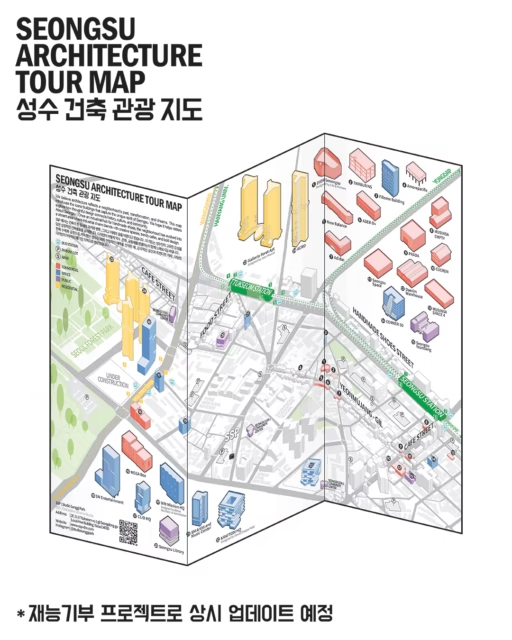
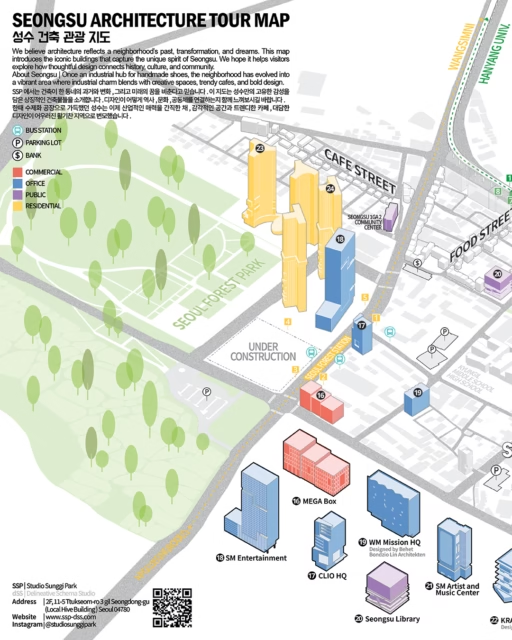
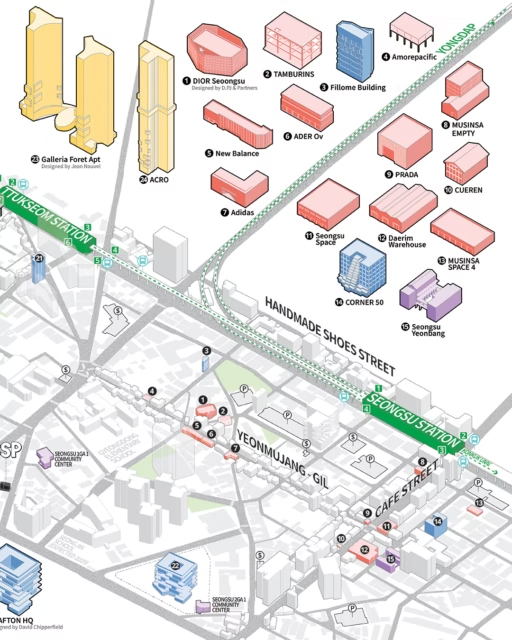
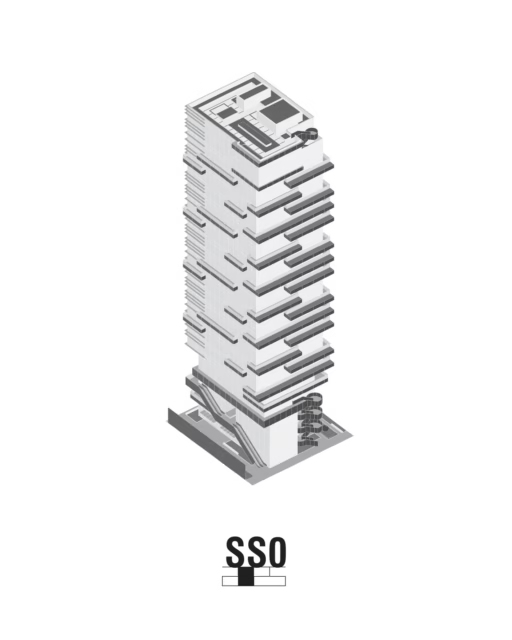
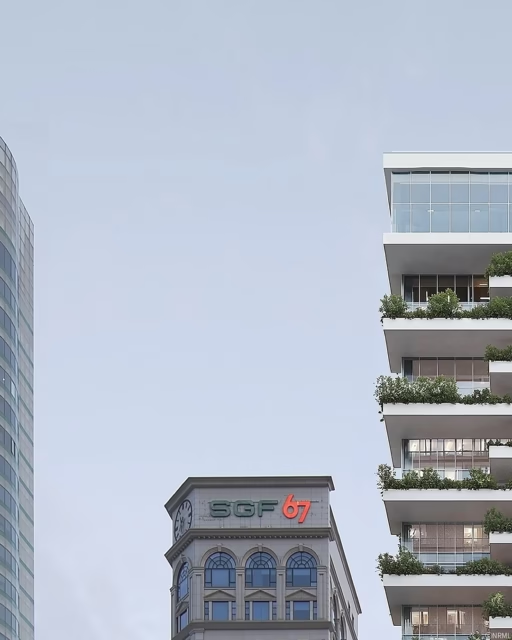
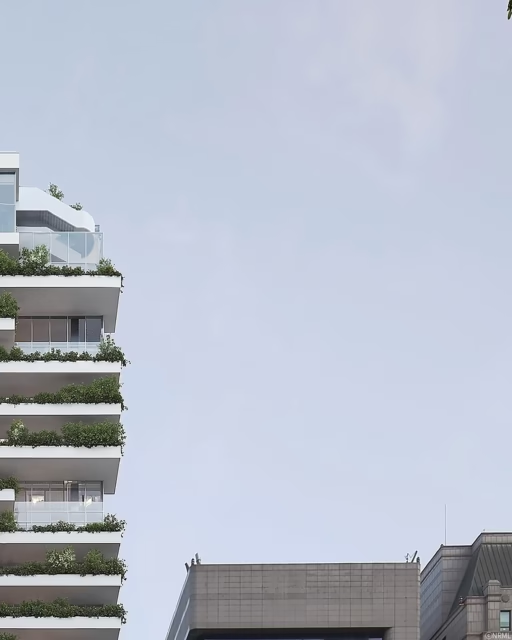
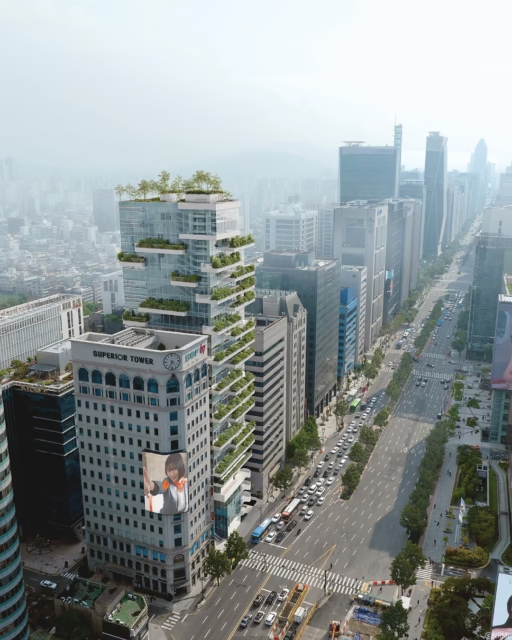
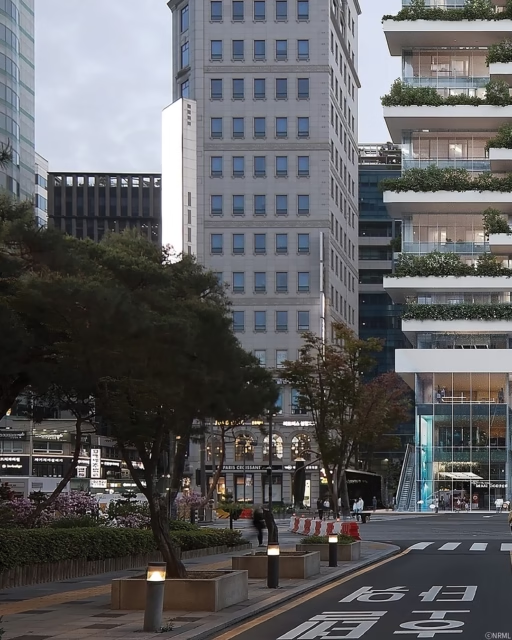
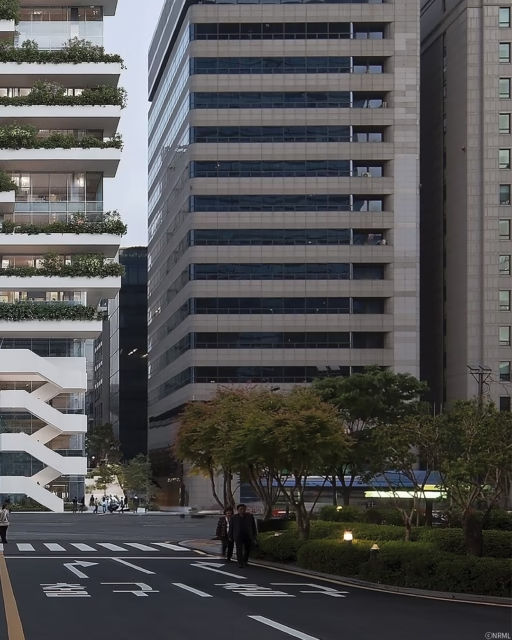
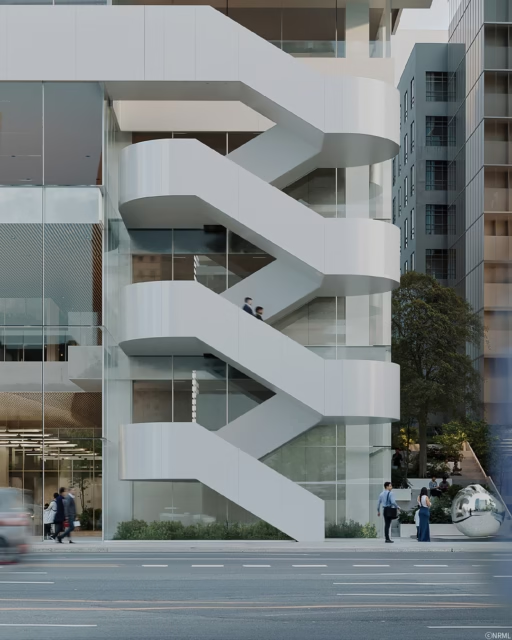
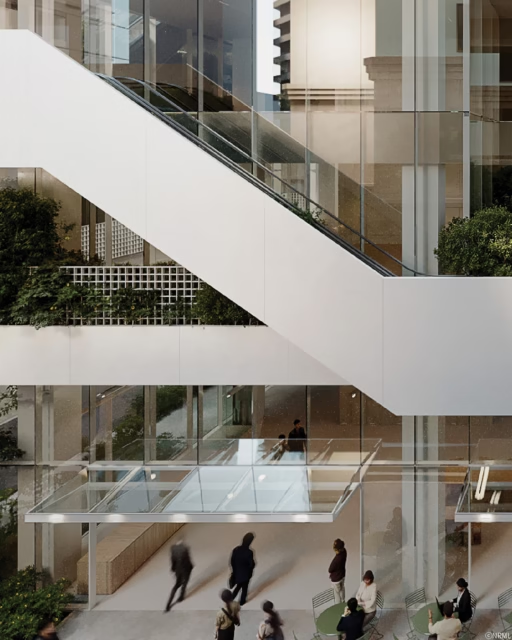
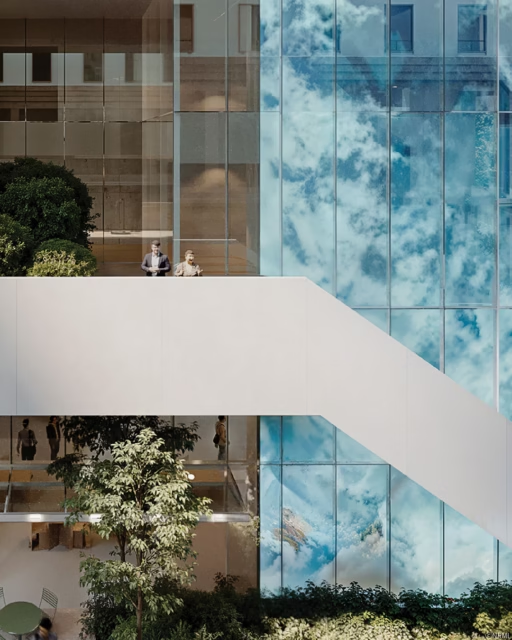
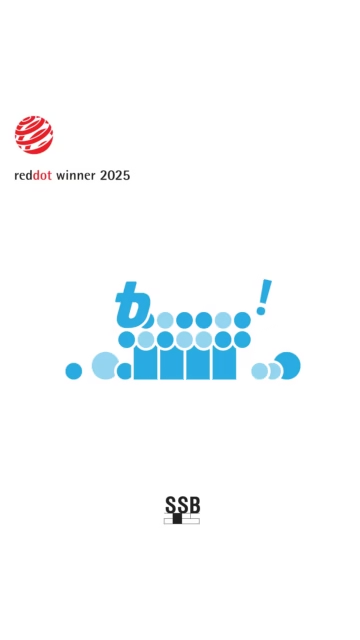
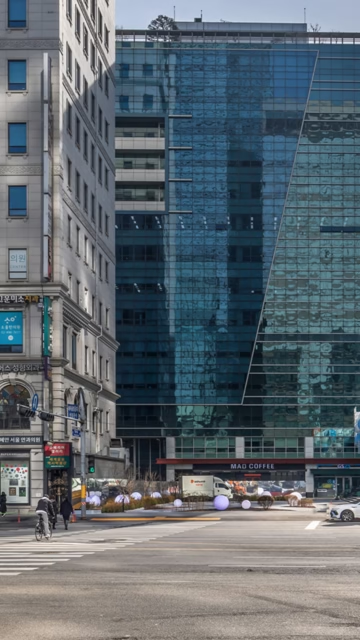
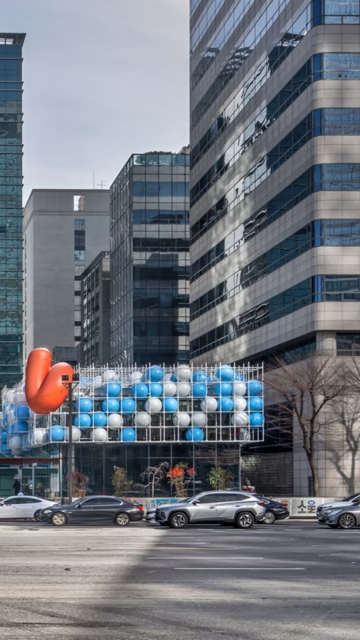
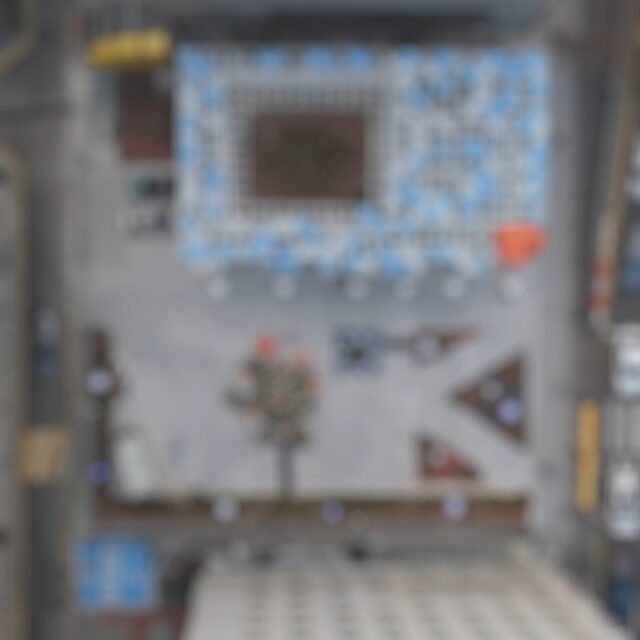
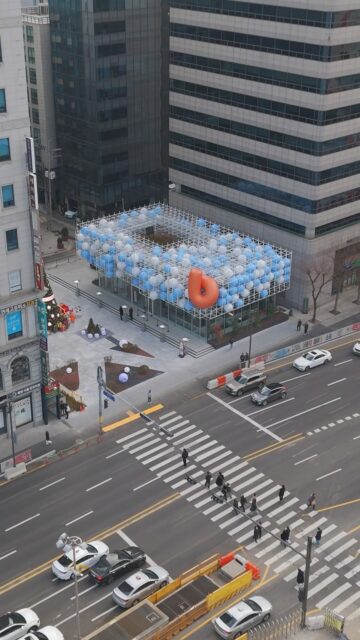
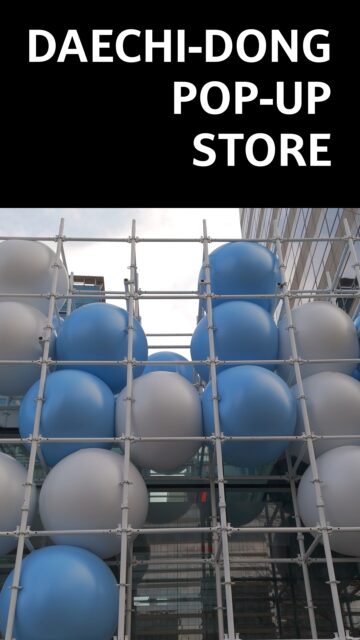


























!['Blooming Clouds' 유튜브 소개 영상
'Blooming Clouds' YouTube introduction video
[플레이스 매거진] 테헤란로 보행자를 위한 오아시스 | 건축가가 설계한 빗썸 라운지 삼성점
[Place Magazine] An Oasis for Pedestrians on Teheran-ro | Bithumb Lounge Samsung Branch by Architecture
테헤란로 보행자를 위한 오아시스 'Blooming Clouds'가 플레이스인사이트 유튜브 채널에서 다뤄졌습니다.
"The pedestrian oasis on Teheran-ro, 'Blooming Clouds,' was featured on the Place Insight YouTube channel."
테헤란로 중심부에 위치한 1,300제곱피트(약 30평) 부지에 지어진 빗썸 라운지 삼성점.
클라이언트와 건축가는 암호화폐 거래소의 무형적 이미지를 구현하는 건물을 세심하게 설계했습니다.
그 결과 도심 속 "사막의 오아시스"처럼 휴식과 사색의 공간이 탄생했습니다.
도시에서는 보기 드문 절벽을 연상시키는 인공 벽부터, 반은 건물이고 반은 조경인 외부 공간,
그리고 도시를 생각하게 하는 여유로운 입구까지. 북적이는 테헤란로 속에서도 자연의 여유로움을 느낄 수 있는 빗썸 라운지 삼성점을 경험해 보세요!
(일부 발췌)
Built on a 1,300-square-foot site in the heart of TeheranRo, Bithumb Lounge Samsung Branch
The client and architect meticulously crafted a building that embodies the intangible image of a cryptocurrency exchange.
This resulted in a space of relaxation and contemplation, like an "oasis in the desert," within the heart of the city.
From the artificial wall reminiscent of a cliff, a rare sight in the city,
to the exterior space, half building, half landscaping,
and the leisurely entrance that invites contemplation of the city.
Experience Bithumb Lounge Samsung Branch, where you can experience the leisurely pace of nature even in the midst of the bustling TeheranRo!
(Excerpt)
자세한 내용은 플레이스인사이트에서 확인하실 수 있습니다.
For more details, please visit PlaceInsight.
출처: 플레이스인사이트 PLACE INSIGHT
https://www.youtube.com/watch?v=5RX7dYqTk2U
📍 서울특별시 강남구 대치동 945-2, 3, 4 필지
📍 945-2, 3, 4 Daechi-dong, Gangnam-gu, Seoul, South Korea
Youtube: 플레이스인사이트 PLACE INSIGHT
@place_zine @clark____03 @ms_ar_h
#SSP #SeoulArchitecture #Youngarchitect #Architecture #UrbanDesign #PlaceInsight #PublicSpace #Gangnam #Seoul #Oasis #SustainableDesign #ArchitectureLovers #DesignStudio #Cityscape #UrbanOasis #에스에스피건축사사무소 #박성기 #건축가 #건축 #젊은건축가 #플레이스인사이트 #강남 #삼성역 #디자인 #공공건축 #오아시스 #비썸라운지삼성점](https://scontent-bos5-1.cdninstagram.com/v/t51.82787-15/536676010_18413794948129907_7624276764730822351_n.jpg?stp=dst-jpg_e35_tt6&_nc_cat=106&ccb=7-5&_nc_sid=18de74&efg=eyJlZmdfdGFnIjoiQ0FST1VTRUxfSVRFTS5iZXN0X2ltYWdlX3VybGdlbi5DMyJ9&_nc_ohc=5OR8cxS3Re0Q7kNvwFnP0Z7&_nc_oc=Adm50u55LLc15xREJByePNXSxQW8ci4OjRzpTYqzTz_nn-gk1rUY7kKQfQIWv2HnrPh2upjXT9nvNdxUN08r2MUt&_nc_zt=23&_nc_ht=scontent-bos5-1.cdninstagram.com&edm=AM6HXa8EAAAA&_nc_gid=aGIkZmdVIjjURJapiEb9TA&oh=00_AfnXJTXNw7oThrSdo4JWnxswYlp-eilVFaY_AW9Czt06Ng&oe=693476CE)
!['Blooming Clouds' 유튜브 소개 영상
'Blooming Clouds' YouTube introduction video
[플레이스 매거진] 테헤란로 보행자를 위한 오아시스 | 건축가가 설계한 빗썸 라운지 삼성점
[Place Magazine] An Oasis for Pedestrians on Teheran-ro | Bithumb Lounge Samsung Branch by Architecture
테헤란로 보행자를 위한 오아시스 'Blooming Clouds'가 플레이스인사이트 유튜브 채널에서 다뤄졌습니다.
"The pedestrian oasis on Teheran-ro, 'Blooming Clouds,' was featured on the Place Insight YouTube channel."
테헤란로 중심부에 위치한 1,300제곱피트(약 30평) 부지에 지어진 빗썸 라운지 삼성점.
클라이언트와 건축가는 암호화폐 거래소의 무형적 이미지를 구현하는 건물을 세심하게 설계했습니다.
그 결과 도심 속 "사막의 오아시스"처럼 휴식과 사색의 공간이 탄생했습니다.
도시에서는 보기 드문 절벽을 연상시키는 인공 벽부터, 반은 건물이고 반은 조경인 외부 공간,
그리고 도시를 생각하게 하는 여유로운 입구까지. 북적이는 테헤란로 속에서도 자연의 여유로움을 느낄 수 있는 빗썸 라운지 삼성점을 경험해 보세요!
(일부 발췌)
Built on a 1,300-square-foot site in the heart of TeheranRo, Bithumb Lounge Samsung Branch
The client and architect meticulously crafted a building that embodies the intangible image of a cryptocurrency exchange.
This resulted in a space of relaxation and contemplation, like an "oasis in the desert," within the heart of the city.
From the artificial wall reminiscent of a cliff, a rare sight in the city,
to the exterior space, half building, half landscaping,
and the leisurely entrance that invites contemplation of the city.
Experience Bithumb Lounge Samsung Branch, where you can experience the leisurely pace of nature even in the midst of the bustling TeheranRo!
(Excerpt)
자세한 내용은 플레이스인사이트에서 확인하실 수 있습니다.
For more details, please visit PlaceInsight.
출처: 플레이스인사이트 PLACE INSIGHT
https://www.youtube.com/watch?v=5RX7dYqTk2U
📍 서울특별시 강남구 대치동 945-2, 3, 4 필지
📍 945-2, 3, 4 Daechi-dong, Gangnam-gu, Seoul, South Korea
Youtube: 플레이스인사이트 PLACE INSIGHT
@place_zine @clark____03 @ms_ar_h
#SSP #SeoulArchitecture #Youngarchitect #Architecture #UrbanDesign #PlaceInsight #PublicSpace #Gangnam #Seoul #Oasis #SustainableDesign #ArchitectureLovers #DesignStudio #Cityscape #UrbanOasis #에스에스피건축사사무소 #박성기 #건축가 #건축 #젊은건축가 #플레이스인사이트 #강남 #삼성역 #디자인 #공공건축 #오아시스 #비썸라운지삼성점](https://scontent-bos5-1.cdninstagram.com/v/t51.82787-15/534308486_18413794951129907_2762444864019005460_n.jpg?stp=dst-jpg_e35_tt6&_nc_cat=105&ccb=7-5&_nc_sid=18de74&efg=eyJlZmdfdGFnIjoiQ0FST1VTRUxfSVRFTS5iZXN0X2ltYWdlX3VybGdlbi5DMyJ9&_nc_ohc=swwaf34nUL8Q7kNvwFlf--o&_nc_oc=AdlPBi7jDq70QTBt-zUWL-YaYd2QTpKUaLnn28wExF2bAm671ai__VIfrwLbAaEfQ84aZzT_q8iiFskSsnJrqruZ&_nc_zt=23&_nc_ht=scontent-bos5-1.cdninstagram.com&edm=AM6HXa8EAAAA&_nc_gid=aGIkZmdVIjjURJapiEb9TA&oh=00_AfkfequtV5YknwzDbJb188q-fQJ-fj9-j4Nqfxra94COQA&oe=693495F8)
!['Blooming Clouds' 유튜브 소개 영상
'Blooming Clouds' YouTube introduction video
[플레이스 매거진] 테헤란로 보행자를 위한 오아시스 | 건축가가 설계한 빗썸 라운지 삼성점
[Place Magazine] An Oasis for Pedestrians on Teheran-ro | Bithumb Lounge Samsung Branch by Architecture
테헤란로 보행자를 위한 오아시스 'Blooming Clouds'가 플레이스인사이트 유튜브 채널에서 다뤄졌습니다.
"The pedestrian oasis on Teheran-ro, 'Blooming Clouds,' was featured on the Place Insight YouTube channel."
테헤란로 중심부에 위치한 1,300제곱피트(약 30평) 부지에 지어진 빗썸 라운지 삼성점.
클라이언트와 건축가는 암호화폐 거래소의 무형적 이미지를 구현하는 건물을 세심하게 설계했습니다.
그 결과 도심 속 "사막의 오아시스"처럼 휴식과 사색의 공간이 탄생했습니다.
도시에서는 보기 드문 절벽을 연상시키는 인공 벽부터, 반은 건물이고 반은 조경인 외부 공간,
그리고 도시를 생각하게 하는 여유로운 입구까지. 북적이는 테헤란로 속에서도 자연의 여유로움을 느낄 수 있는 빗썸 라운지 삼성점을 경험해 보세요!
(일부 발췌)
Built on a 1,300-square-foot site in the heart of TeheranRo, Bithumb Lounge Samsung Branch
The client and architect meticulously crafted a building that embodies the intangible image of a cryptocurrency exchange.
This resulted in a space of relaxation and contemplation, like an "oasis in the desert," within the heart of the city.
From the artificial wall reminiscent of a cliff, a rare sight in the city,
to the exterior space, half building, half landscaping,
and the leisurely entrance that invites contemplation of the city.
Experience Bithumb Lounge Samsung Branch, where you can experience the leisurely pace of nature even in the midst of the bustling TeheranRo!
(Excerpt)
자세한 내용은 플레이스인사이트에서 확인하실 수 있습니다.
For more details, please visit PlaceInsight.
출처: 플레이스인사이트 PLACE INSIGHT
https://www.youtube.com/watch?v=5RX7dYqTk2U
📍 서울특별시 강남구 대치동 945-2, 3, 4 필지
📍 945-2, 3, 4 Daechi-dong, Gangnam-gu, Seoul, South Korea
Youtube: 플레이스인사이트 PLACE INSIGHT
@place_zine @clark____03 @ms_ar_h
#SSP #SeoulArchitecture #Youngarchitect #Architecture #UrbanDesign #PlaceInsight #PublicSpace #Gangnam #Seoul #Oasis #SustainableDesign #ArchitectureLovers #DesignStudio #Cityscape #UrbanOasis #에스에스피건축사사무소 #박성기 #건축가 #건축 #젊은건축가 #플레이스인사이트 #강남 #삼성역 #디자인 #공공건축 #오아시스 #비썸라운지삼성점](https://scontent-bos5-1.cdninstagram.com/v/t51.82787-15/534192927_18413794972129907_7678013006962494212_n.jpg?stp=dst-jpg_e35_tt6&_nc_cat=106&ccb=7-5&_nc_sid=18de74&efg=eyJlZmdfdGFnIjoiQ0FST1VTRUxfSVRFTS5iZXN0X2ltYWdlX3VybGdlbi5DMyJ9&_nc_ohc=hL_9N7qzcPkQ7kNvwEwRF4y&_nc_oc=AdkYuyoQqVa2hw-CYQjEU6RaQaRT8aq7H-R2kQr4cpkWva--qog0fBKj4Iu3Ub1EpL5CZbEUj1rwmC_T_nfWx2fX&_nc_zt=23&_nc_ht=scontent-bos5-1.cdninstagram.com&edm=AM6HXa8EAAAA&_nc_gid=aGIkZmdVIjjURJapiEb9TA&oh=00_AfnMATTxxOv-U4vK91s23QHWwm_7BoD21irb_0zas31zdQ&oe=69349130)
!['Blooming Clouds' 유튜브 소개 영상
'Blooming Clouds' YouTube introduction video
[플레이스 매거진] 테헤란로 보행자를 위한 오아시스 | 건축가가 설계한 빗썸 라운지 삼성점
[Place Magazine] An Oasis for Pedestrians on Teheran-ro | Bithumb Lounge Samsung Branch by Architecture
테헤란로 보행자를 위한 오아시스 'Blooming Clouds'가 플레이스인사이트 유튜브 채널에서 다뤄졌습니다.
"The pedestrian oasis on Teheran-ro, 'Blooming Clouds,' was featured on the Place Insight YouTube channel."
테헤란로 중심부에 위치한 1,300제곱피트(약 30평) 부지에 지어진 빗썸 라운지 삼성점.
클라이언트와 건축가는 암호화폐 거래소의 무형적 이미지를 구현하는 건물을 세심하게 설계했습니다.
그 결과 도심 속 "사막의 오아시스"처럼 휴식과 사색의 공간이 탄생했습니다.
도시에서는 보기 드문 절벽을 연상시키는 인공 벽부터, 반은 건물이고 반은 조경인 외부 공간,
그리고 도시를 생각하게 하는 여유로운 입구까지. 북적이는 테헤란로 속에서도 자연의 여유로움을 느낄 수 있는 빗썸 라운지 삼성점을 경험해 보세요!
(일부 발췌)
Built on a 1,300-square-foot site in the heart of TeheranRo, Bithumb Lounge Samsung Branch
The client and architect meticulously crafted a building that embodies the intangible image of a cryptocurrency exchange.
This resulted in a space of relaxation and contemplation, like an "oasis in the desert," within the heart of the city.
From the artificial wall reminiscent of a cliff, a rare sight in the city,
to the exterior space, half building, half landscaping,
and the leisurely entrance that invites contemplation of the city.
Experience Bithumb Lounge Samsung Branch, where you can experience the leisurely pace of nature even in the midst of the bustling TeheranRo!
(Excerpt)
자세한 내용은 플레이스인사이트에서 확인하실 수 있습니다.
For more details, please visit PlaceInsight.
출처: 플레이스인사이트 PLACE INSIGHT
https://www.youtube.com/watch?v=5RX7dYqTk2U
📍 서울특별시 강남구 대치동 945-2, 3, 4 필지
📍 945-2, 3, 4 Daechi-dong, Gangnam-gu, Seoul, South Korea
Youtube: 플레이스인사이트 PLACE INSIGHT
@place_zine @clark____03 @ms_ar_h
#SSP #SeoulArchitecture #Youngarchitect #Architecture #UrbanDesign #PlaceInsight #PublicSpace #Gangnam #Seoul #Oasis #SustainableDesign #ArchitectureLovers #DesignStudio #Cityscape #UrbanOasis #에스에스피건축사사무소 #박성기 #건축가 #건축 #젊은건축가 #플레이스인사이트 #강남 #삼성역 #디자인 #공공건축 #오아시스 #비썸라운지삼성점](https://scontent-bos5-1.cdninstagram.com/v/t51.82787-15/536530928_18413794978129907_8267967299635103278_n.jpg?stp=dst-jpg_e35_tt6&_nc_cat=109&ccb=7-5&_nc_sid=18de74&efg=eyJlZmdfdGFnIjoiQ0FST1VTRUxfSVRFTS5iZXN0X2ltYWdlX3VybGdlbi5DMyJ9&_nc_ohc=5YRQX_nC_8kQ7kNvwGj_alA&_nc_oc=AdkgBHlyKokE1JmeykzhcmfP3RV6ptT1NMZ6CF4Y18pQC14WgRlOM6dpLR30YLIu7fJtqc3mgSmHjHZ8SBEkhg2_&_nc_zt=23&_nc_ht=scontent-bos5-1.cdninstagram.com&edm=AM6HXa8EAAAA&_nc_gid=aGIkZmdVIjjURJapiEb9TA&oh=00_AfnGD-PvQEMegK-Ieomi0Ri4ei0I7rnuYDdBG12etCZyWg&oe=69349D15)
!['Blooming Clouds' 유튜브 소개 영상
'Blooming Clouds' YouTube introduction video
[플레이스 매거진] 테헤란로 보행자를 위한 오아시스 | 건축가가 설계한 빗썸 라운지 삼성점
[Place Magazine] An Oasis for Pedestrians on Teheran-ro | Bithumb Lounge Samsung Branch by Architecture
테헤란로 보행자를 위한 오아시스 'Blooming Clouds'가 플레이스인사이트 유튜브 채널에서 다뤄졌습니다.
"The pedestrian oasis on Teheran-ro, 'Blooming Clouds,' was featured on the Place Insight YouTube channel."
테헤란로 중심부에 위치한 1,300제곱피트(약 30평) 부지에 지어진 빗썸 라운지 삼성점.
클라이언트와 건축가는 암호화폐 거래소의 무형적 이미지를 구현하는 건물을 세심하게 설계했습니다.
그 결과 도심 속 "사막의 오아시스"처럼 휴식과 사색의 공간이 탄생했습니다.
도시에서는 보기 드문 절벽을 연상시키는 인공 벽부터, 반은 건물이고 반은 조경인 외부 공간,
그리고 도시를 생각하게 하는 여유로운 입구까지. 북적이는 테헤란로 속에서도 자연의 여유로움을 느낄 수 있는 빗썸 라운지 삼성점을 경험해 보세요!
(일부 발췌)
Built on a 1,300-square-foot site in the heart of TeheranRo, Bithumb Lounge Samsung Branch
The client and architect meticulously crafted a building that embodies the intangible image of a cryptocurrency exchange.
This resulted in a space of relaxation and contemplation, like an "oasis in the desert," within the heart of the city.
From the artificial wall reminiscent of a cliff, a rare sight in the city,
to the exterior space, half building, half landscaping,
and the leisurely entrance that invites contemplation of the city.
Experience Bithumb Lounge Samsung Branch, where you can experience the leisurely pace of nature even in the midst of the bustling TeheranRo!
(Excerpt)
자세한 내용은 플레이스인사이트에서 확인하실 수 있습니다.
For more details, please visit PlaceInsight.
출처: 플레이스인사이트 PLACE INSIGHT
https://www.youtube.com/watch?v=5RX7dYqTk2U
📍 서울특별시 강남구 대치동 945-2, 3, 4 필지
📍 945-2, 3, 4 Daechi-dong, Gangnam-gu, Seoul, South Korea
Youtube: 플레이스인사이트 PLACE INSIGHT
@place_zine @clark____03 @ms_ar_h
#SSP #SeoulArchitecture #Youngarchitect #Architecture #UrbanDesign #PlaceInsight #PublicSpace #Gangnam #Seoul #Oasis #SustainableDesign #ArchitectureLovers #DesignStudio #Cityscape #UrbanOasis #에스에스피건축사사무소 #박성기 #건축가 #건축 #젊은건축가 #플레이스인사이트 #강남 #삼성역 #디자인 #공공건축 #오아시스 #비썸라운지삼성점](https://scontent-bos5-1.cdninstagram.com/v/t51.82787-15/537416253_18413794945129907_7444538253893957633_n.jpg?stp=dst-jpg_e35_tt6&_nc_cat=107&ccb=7-5&_nc_sid=18de74&efg=eyJlZmdfdGFnIjoiQ0FST1VTRUxfSVRFTS5iZXN0X2ltYWdlX3VybGdlbi5DMyJ9&_nc_ohc=Z8nUxEmZAroQ7kNvwFldUag&_nc_oc=AdmhLIfG-Pa-4W8SEGmYj3_GYrICenpqmWJc4bfJFcoK_tiP3yJd3MtzETm0fb7ZjMz3j-JPj-PkCROwobDXPSqc&_nc_zt=23&_nc_ht=scontent-bos5-1.cdninstagram.com&edm=AM6HXa8EAAAA&_nc_gid=aGIkZmdVIjjURJapiEb9TA&oh=00_Afn1tNWh2OMkntWcQ8s8gVMj1ibfNhtGiqbNJ56bObdkOQ&oe=693484D5)
!['Blooming Clouds' 유튜브 소개 영상
'Blooming Clouds' YouTube introduction video
[플레이스 매거진] 테헤란로 보행자를 위한 오아시스 | 건축가가 설계한 빗썸 라운지 삼성점
[Place Magazine] An Oasis for Pedestrians on Teheran-ro | Bithumb Lounge Samsung Branch by Architecture
테헤란로 보행자를 위한 오아시스 'Blooming Clouds'가 플레이스인사이트 유튜브 채널에서 다뤄졌습니다.
"The pedestrian oasis on Teheran-ro, 'Blooming Clouds,' was featured on the Place Insight YouTube channel."
테헤란로 중심부에 위치한 1,300제곱피트(약 30평) 부지에 지어진 빗썸 라운지 삼성점.
클라이언트와 건축가는 암호화폐 거래소의 무형적 이미지를 구현하는 건물을 세심하게 설계했습니다.
그 결과 도심 속 "사막의 오아시스"처럼 휴식과 사색의 공간이 탄생했습니다.
도시에서는 보기 드문 절벽을 연상시키는 인공 벽부터, 반은 건물이고 반은 조경인 외부 공간,
그리고 도시를 생각하게 하는 여유로운 입구까지. 북적이는 테헤란로 속에서도 자연의 여유로움을 느낄 수 있는 빗썸 라운지 삼성점을 경험해 보세요!
(일부 발췌)
Built on a 1,300-square-foot site in the heart of TeheranRo, Bithumb Lounge Samsung Branch
The client and architect meticulously crafted a building that embodies the intangible image of a cryptocurrency exchange.
This resulted in a space of relaxation and contemplation, like an "oasis in the desert," within the heart of the city.
From the artificial wall reminiscent of a cliff, a rare sight in the city,
to the exterior space, half building, half landscaping,
and the leisurely entrance that invites contemplation of the city.
Experience Bithumb Lounge Samsung Branch, where you can experience the leisurely pace of nature even in the midst of the bustling TeheranRo!
(Excerpt)
자세한 내용은 플레이스인사이트에서 확인하실 수 있습니다.
For more details, please visit PlaceInsight.
출처: 플레이스인사이트 PLACE INSIGHT
https://www.youtube.com/watch?v=5RX7dYqTk2U
📍 서울특별시 강남구 대치동 945-2, 3, 4 필지
📍 945-2, 3, 4 Daechi-dong, Gangnam-gu, Seoul, South Korea
Youtube: 플레이스인사이트 PLACE INSIGHT
@place_zine @clark____03 @ms_ar_h
#SSP #SeoulArchitecture #Youngarchitect #Architecture #UrbanDesign #PlaceInsight #PublicSpace #Gangnam #Seoul #Oasis #SustainableDesign #ArchitectureLovers #DesignStudio #Cityscape #UrbanOasis #에스에스피건축사사무소 #박성기 #건축가 #건축 #젊은건축가 #플레이스인사이트 #강남 #삼성역 #디자인 #공공건축 #오아시스 #비썸라운지삼성점](https://scontent-bos5-1.cdninstagram.com/v/t51.82787-15/537362657_18413794924129907_6791771700342951723_n.jpg?stp=dst-jpg_e35_tt6&_nc_cat=103&ccb=7-5&_nc_sid=18de74&efg=eyJlZmdfdGFnIjoiQ0FST1VTRUxfSVRFTS5iZXN0X2ltYWdlX3VybGdlbi5DMyJ9&_nc_ohc=O6OMdci9_BAQ7kNvwGoY33g&_nc_oc=AdnSvKN1DesEFlugLYs2RD1_OCd-U1dR-eeTaRbfJGJAXwprRcAIlhGZoKu6PO2S1Khe9C6aMWSXqFu3d67Ue49g&_nc_zt=23&_nc_ht=scontent-bos5-1.cdninstagram.com&edm=AM6HXa8EAAAA&_nc_gid=aGIkZmdVIjjURJapiEb9TA&oh=00_AfmQ7iNs0pfY1wqfnfu5viOTGuTPUBZ5Rl44G_PU4jumhw&oe=69348637)
!['Blooming Clouds' 유튜브 소개 영상
'Blooming Clouds' YouTube introduction video
[플레이스 매거진] 테헤란로 보행자를 위한 오아시스 | 건축가가 설계한 빗썸 라운지 삼성점
[Place Magazine] An Oasis for Pedestrians on Teheran-ro | Bithumb Lounge Samsung Branch by Architecture
테헤란로 보행자를 위한 오아시스 'Blooming Clouds'가 플레이스인사이트 유튜브 채널에서 다뤄졌습니다.
"The pedestrian oasis on Teheran-ro, 'Blooming Clouds,' was featured on the Place Insight YouTube channel."
테헤란로 중심부에 위치한 1,300제곱피트(약 30평) 부지에 지어진 빗썸 라운지 삼성점.
클라이언트와 건축가는 암호화폐 거래소의 무형적 이미지를 구현하는 건물을 세심하게 설계했습니다.
그 결과 도심 속 "사막의 오아시스"처럼 휴식과 사색의 공간이 탄생했습니다.
도시에서는 보기 드문 절벽을 연상시키는 인공 벽부터, 반은 건물이고 반은 조경인 외부 공간,
그리고 도시를 생각하게 하는 여유로운 입구까지. 북적이는 테헤란로 속에서도 자연의 여유로움을 느낄 수 있는 빗썸 라운지 삼성점을 경험해 보세요!
(일부 발췌)
Built on a 1,300-square-foot site in the heart of TeheranRo, Bithumb Lounge Samsung Branch
The client and architect meticulously crafted a building that embodies the intangible image of a cryptocurrency exchange.
This resulted in a space of relaxation and contemplation, like an "oasis in the desert," within the heart of the city.
From the artificial wall reminiscent of a cliff, a rare sight in the city,
to the exterior space, half building, half landscaping,
and the leisurely entrance that invites contemplation of the city.
Experience Bithumb Lounge Samsung Branch, where you can experience the leisurely pace of nature even in the midst of the bustling TeheranRo!
(Excerpt)
자세한 내용은 플레이스인사이트에서 확인하실 수 있습니다.
For more details, please visit PlaceInsight.
출처: 플레이스인사이트 PLACE INSIGHT
https://www.youtube.com/watch?v=5RX7dYqTk2U
📍 서울특별시 강남구 대치동 945-2, 3, 4 필지
📍 945-2, 3, 4 Daechi-dong, Gangnam-gu, Seoul, South Korea
Youtube: 플레이스인사이트 PLACE INSIGHT
@place_zine @clark____03 @ms_ar_h
#SSP #SeoulArchitecture #Youngarchitect #Architecture #UrbanDesign #PlaceInsight #PublicSpace #Gangnam #Seoul #Oasis #SustainableDesign #ArchitectureLovers #DesignStudio #Cityscape #UrbanOasis #에스에스피건축사사무소 #박성기 #건축가 #건축 #젊은건축가 #플레이스인사이트 #강남 #삼성역 #디자인 #공공건축 #오아시스 #비썸라운지삼성점](https://scontent-bos5-1.cdninstagram.com/v/t51.82787-15/537672050_18413794903129907_4448229455879270874_n.jpg?stp=dst-jpg_e35_tt6&_nc_cat=107&ccb=7-5&_nc_sid=18de74&efg=eyJlZmdfdGFnIjoiQ0FST1VTRUxfSVRFTS5iZXN0X2ltYWdlX3VybGdlbi5DMyJ9&_nc_ohc=ooScwWlwDP0Q7kNvwG3RVx2&_nc_oc=AdmfoPQ2s0xoTrKAt_qwx-pPgxXXJ8jXZx7vwRJhZvpgXVJpfZP9U6O6ucq2H6cidqvACiv9edhOut50NBn5BxyP&_nc_zt=23&_nc_ht=scontent-bos5-1.cdninstagram.com&edm=AM6HXa8EAAAA&_nc_gid=aGIkZmdVIjjURJapiEb9TA&oh=00_AfnqBuDar_mu19tBcZ1fhcYeQBk2ktKf2LR_LyMZOtXH1g&oe=69347981)
!['Blooming Clouds' 유튜브 소개 영상
'Blooming Clouds' YouTube introduction video
[플레이스 매거진] 테헤란로 보행자를 위한 오아시스 | 건축가가 설계한 빗썸 라운지 삼성점
[Place Magazine] An Oasis for Pedestrians on Teheran-ro | Bithumb Lounge Samsung Branch by Architecture
테헤란로 보행자를 위한 오아시스 'Blooming Clouds'가 플레이스인사이트 유튜브 채널에서 다뤄졌습니다.
"The pedestrian oasis on Teheran-ro, 'Blooming Clouds,' was featured on the Place Insight YouTube channel."
테헤란로 중심부에 위치한 1,300제곱피트(약 30평) 부지에 지어진 빗썸 라운지 삼성점.
클라이언트와 건축가는 암호화폐 거래소의 무형적 이미지를 구현하는 건물을 세심하게 설계했습니다.
그 결과 도심 속 "사막의 오아시스"처럼 휴식과 사색의 공간이 탄생했습니다.
도시에서는 보기 드문 절벽을 연상시키는 인공 벽부터, 반은 건물이고 반은 조경인 외부 공간,
그리고 도시를 생각하게 하는 여유로운 입구까지. 북적이는 테헤란로 속에서도 자연의 여유로움을 느낄 수 있는 빗썸 라운지 삼성점을 경험해 보세요!
(일부 발췌)
Built on a 1,300-square-foot site in the heart of TeheranRo, Bithumb Lounge Samsung Branch
The client and architect meticulously crafted a building that embodies the intangible image of a cryptocurrency exchange.
This resulted in a space of relaxation and contemplation, like an "oasis in the desert," within the heart of the city.
From the artificial wall reminiscent of a cliff, a rare sight in the city,
to the exterior space, half building, half landscaping,
and the leisurely entrance that invites contemplation of the city.
Experience Bithumb Lounge Samsung Branch, where you can experience the leisurely pace of nature even in the midst of the bustling TeheranRo!
(Excerpt)
자세한 내용은 플레이스인사이트에서 확인하실 수 있습니다.
For more details, please visit PlaceInsight.
출처: 플레이스인사이트 PLACE INSIGHT
https://www.youtube.com/watch?v=5RX7dYqTk2U
📍 서울특별시 강남구 대치동 945-2, 3, 4 필지
📍 945-2, 3, 4 Daechi-dong, Gangnam-gu, Seoul, South Korea
Youtube: 플레이스인사이트 PLACE INSIGHT
@place_zine @clark____03 @ms_ar_h
#SSP #SeoulArchitecture #Youngarchitect #Architecture #UrbanDesign #PlaceInsight #PublicSpace #Gangnam #Seoul #Oasis #SustainableDesign #ArchitectureLovers #DesignStudio #Cityscape #UrbanOasis #에스에스피건축사사무소 #박성기 #건축가 #건축 #젊은건축가 #플레이스인사이트 #강남 #삼성역 #디자인 #공공건축 #오아시스 #비썸라운지삼성점](https://scontent-bos5-1.cdninstagram.com/v/t51.82787-15/536609875_18413794975129907_6650646615230751913_n.jpg?stp=dst-jpg_e35_tt6&_nc_cat=103&ccb=7-5&_nc_sid=18de74&efg=eyJlZmdfdGFnIjoiQ0FST1VTRUxfSVRFTS5iZXN0X2ltYWdlX3VybGdlbi5DMyJ9&_nc_ohc=PuXrr5CVmjkQ7kNvwFFMkty&_nc_oc=AdnBl7wvcsB6TcIqu5G_ZN_ueOtw-ijoencqbP2Z9G-KIExBFa1wG3QaVa0mdPYtei_IMtCwwd-p3OvWSXBa6Ovr&_nc_zt=23&_nc_ht=scontent-bos5-1.cdninstagram.com&edm=AM6HXa8EAAAA&_nc_gid=aGIkZmdVIjjURJapiEb9TA&oh=00_Afl_YqmpAZ2LT79Ckj6Anf00eqJba8iBtXE_rMSoOXU1sw&oe=6934745D)
!['Blooming Clouds' 유튜브 소개 영상
'Blooming Clouds' YouTube introduction video
[플레이스 매거진] 테헤란로 보행자를 위한 오아시스 | 건축가가 설계한 빗썸 라운지 삼성점
[Place Magazine] An Oasis for Pedestrians on Teheran-ro | Bithumb Lounge Samsung Branch by Architecture
테헤란로 보행자를 위한 오아시스 'Blooming Clouds'가 플레이스인사이트 유튜브 채널에서 다뤄졌습니다.
"The pedestrian oasis on Teheran-ro, 'Blooming Clouds,' was featured on the Place Insight YouTube channel."
테헤란로 중심부에 위치한 1,300제곱피트(약 30평) 부지에 지어진 빗썸 라운지 삼성점.
클라이언트와 건축가는 암호화폐 거래소의 무형적 이미지를 구현하는 건물을 세심하게 설계했습니다.
그 결과 도심 속 "사막의 오아시스"처럼 휴식과 사색의 공간이 탄생했습니다.
도시에서는 보기 드문 절벽을 연상시키는 인공 벽부터, 반은 건물이고 반은 조경인 외부 공간,
그리고 도시를 생각하게 하는 여유로운 입구까지. 북적이는 테헤란로 속에서도 자연의 여유로움을 느낄 수 있는 빗썸 라운지 삼성점을 경험해 보세요!
(일부 발췌)
Built on a 1,300-square-foot site in the heart of TeheranRo, Bithumb Lounge Samsung Branch
The client and architect meticulously crafted a building that embodies the intangible image of a cryptocurrency exchange.
This resulted in a space of relaxation and contemplation, like an "oasis in the desert," within the heart of the city.
From the artificial wall reminiscent of a cliff, a rare sight in the city,
to the exterior space, half building, half landscaping,
and the leisurely entrance that invites contemplation of the city.
Experience Bithumb Lounge Samsung Branch, where you can experience the leisurely pace of nature even in the midst of the bustling TeheranRo!
(Excerpt)
자세한 내용은 플레이스인사이트에서 확인하실 수 있습니다.
For more details, please visit PlaceInsight.
출처: 플레이스인사이트 PLACE INSIGHT
https://www.youtube.com/watch?v=5RX7dYqTk2U
📍 서울특별시 강남구 대치동 945-2, 3, 4 필지
📍 945-2, 3, 4 Daechi-dong, Gangnam-gu, Seoul, South Korea
Youtube: 플레이스인사이트 PLACE INSIGHT
@place_zine @clark____03 @ms_ar_h
#SSP #SeoulArchitecture #Youngarchitect #Architecture #UrbanDesign #PlaceInsight #PublicSpace #Gangnam #Seoul #Oasis #SustainableDesign #ArchitectureLovers #DesignStudio #Cityscape #UrbanOasis #에스에스피건축사사무소 #박성기 #건축가 #건축 #젊은건축가 #플레이스인사이트 #강남 #삼성역 #디자인 #공공건축 #오아시스 #비썸라운지삼성점](https://scontent-bos5-1.cdninstagram.com/v/t51.82787-15/536505554_18413794921129907_8200541927103348424_n.jpg?stp=dst-jpg_e35_tt6&_nc_cat=109&ccb=7-5&_nc_sid=18de74&efg=eyJlZmdfdGFnIjoiQ0FST1VTRUxfSVRFTS5iZXN0X2ltYWdlX3VybGdlbi5DMyJ9&_nc_ohc=u9huNZuCcXoQ7kNvwGAFy1M&_nc_oc=AdlgHyiY2IA37lFaI6KAKw3emyZZ2ltulAKz_P4XQ01M7THofnkZQRZ4KmWCW6PqTX6gbXXZtXdtXnQ7Zz9Jzcqh&_nc_zt=23&_nc_ht=scontent-bos5-1.cdninstagram.com&edm=AM6HXa8EAAAA&_nc_gid=aGIkZmdVIjjURJapiEb9TA&oh=00_AfkeneZZD_K5Dx3h0NhkQPKJprT9PrnxON3zmimdEVTrhw&oe=69346F81)
!['Blooming Clouds' 유튜브 소개 영상
'Blooming Clouds' YouTube introduction video
[플레이스 매거진] 테헤란로 보행자를 위한 오아시스 | 건축가가 설계한 빗썸 라운지 삼성점
[Place Magazine] An Oasis for Pedestrians on Teheran-ro | Bithumb Lounge Samsung Branch by Architecture
테헤란로 보행자를 위한 오아시스 'Blooming Clouds'가 플레이스인사이트 유튜브 채널에서 다뤄졌습니다.
"The pedestrian oasis on Teheran-ro, 'Blooming Clouds,' was featured on the Place Insight YouTube channel."
테헤란로 중심부에 위치한 1,300제곱피트(약 30평) 부지에 지어진 빗썸 라운지 삼성점.
클라이언트와 건축가는 암호화폐 거래소의 무형적 이미지를 구현하는 건물을 세심하게 설계했습니다.
그 결과 도심 속 "사막의 오아시스"처럼 휴식과 사색의 공간이 탄생했습니다.
도시에서는 보기 드문 절벽을 연상시키는 인공 벽부터, 반은 건물이고 반은 조경인 외부 공간,
그리고 도시를 생각하게 하는 여유로운 입구까지. 북적이는 테헤란로 속에서도 자연의 여유로움을 느낄 수 있는 빗썸 라운지 삼성점을 경험해 보세요!
(일부 발췌)
Built on a 1,300-square-foot site in the heart of TeheranRo, Bithumb Lounge Samsung Branch
The client and architect meticulously crafted a building that embodies the intangible image of a cryptocurrency exchange.
This resulted in a space of relaxation and contemplation, like an "oasis in the desert," within the heart of the city.
From the artificial wall reminiscent of a cliff, a rare sight in the city,
to the exterior space, half building, half landscaping,
and the leisurely entrance that invites contemplation of the city.
Experience Bithumb Lounge Samsung Branch, where you can experience the leisurely pace of nature even in the midst of the bustling TeheranRo!
(Excerpt)
자세한 내용은 플레이스인사이트에서 확인하실 수 있습니다.
For more details, please visit PlaceInsight.
출처: 플레이스인사이트 PLACE INSIGHT
https://www.youtube.com/watch?v=5RX7dYqTk2U
📍 서울특별시 강남구 대치동 945-2, 3, 4 필지
📍 945-2, 3, 4 Daechi-dong, Gangnam-gu, Seoul, South Korea
Youtube: 플레이스인사이트 PLACE INSIGHT
@place_zine @clark____03 @ms_ar_h
#SSP #SeoulArchitecture #Youngarchitect #Architecture #UrbanDesign #PlaceInsight #PublicSpace #Gangnam #Seoul #Oasis #SustainableDesign #ArchitectureLovers #DesignStudio #Cityscape #UrbanOasis #에스에스피건축사사무소 #박성기 #건축가 #건축 #젊은건축가 #플레이스인사이트 #강남 #삼성역 #디자인 #공공건축 #오아시스 #비썸라운지삼성점](https://scontent-bos5-1.cdninstagram.com/v/t51.82787-15/537888623_18413794657129907_4118789334514777971_n.jpg?stp=dst-jpg_e35_tt6&_nc_cat=106&ccb=7-5&_nc_sid=18de74&efg=eyJlZmdfdGFnIjoiQ0FST1VTRUxfSVRFTS5iZXN0X2ltYWdlX3VybGdlbi5DMyJ9&_nc_ohc=WvLzwzAti_gQ7kNvwFxrWYm&_nc_oc=AdkOyAlwhitx_MC_BcdiXLH2pE9cWELqpXai5ZGZ3UmnQU6B3cu_nvq6YInHpZPQokViTsjtNk0vDDZkf2uECa4v&_nc_zt=23&_nc_ht=scontent-bos5-1.cdninstagram.com&edm=AM6HXa8EAAAA&_nc_gid=aGIkZmdVIjjURJapiEb9TA&oh=00_Aflu269p6V65uTC_JHIGUmjB35g39hXcF23aXgUytPKCbA&oe=69348FA9)
!['Blooming Clouds' 유튜브 소개 영상
'Blooming Clouds' YouTube introduction video
[플레이스 매거진] 테헤란로 보행자를 위한 오아시스 | 건축가가 설계한 빗썸 라운지 삼성점
[Place Magazine] An Oasis for Pedestrians on Teheran-ro | Bithumb Lounge Samsung Branch by Architecture
테헤란로 보행자를 위한 오아시스 'Blooming Clouds'가 플레이스인사이트 유튜브 채널에서 다뤄졌습니다.
"The pedestrian oasis on Teheran-ro, 'Blooming Clouds,' was featured on the Place Insight YouTube channel."
테헤란로 중심부에 위치한 1,300제곱피트(약 30평) 부지에 지어진 빗썸 라운지 삼성점.
클라이언트와 건축가는 암호화폐 거래소의 무형적 이미지를 구현하는 건물을 세심하게 설계했습니다.
그 결과 도심 속 "사막의 오아시스"처럼 휴식과 사색의 공간이 탄생했습니다.
도시에서는 보기 드문 절벽을 연상시키는 인공 벽부터, 반은 건물이고 반은 조경인 외부 공간,
그리고 도시를 생각하게 하는 여유로운 입구까지. 북적이는 테헤란로 속에서도 자연의 여유로움을 느낄 수 있는 빗썸 라운지 삼성점을 경험해 보세요!
(일부 발췌)
Built on a 1,300-square-foot site in the heart of TeheranRo, Bithumb Lounge Samsung Branch
The client and architect meticulously crafted a building that embodies the intangible image of a cryptocurrency exchange.
This resulted in a space of relaxation and contemplation, like an "oasis in the desert," within the heart of the city.
From the artificial wall reminiscent of a cliff, a rare sight in the city,
to the exterior space, half building, half landscaping,
and the leisurely entrance that invites contemplation of the city.
Experience Bithumb Lounge Samsung Branch, where you can experience the leisurely pace of nature even in the midst of the bustling TeheranRo!
(Excerpt)
자세한 내용은 플레이스인사이트에서 확인하실 수 있습니다.
For more details, please visit PlaceInsight.
출처: 플레이스인사이트 PLACE INSIGHT
https://www.youtube.com/watch?v=5RX7dYqTk2U
📍 서울특별시 강남구 대치동 945-2, 3, 4 필지
📍 945-2, 3, 4 Daechi-dong, Gangnam-gu, Seoul, South Korea
Youtube: 플레이스인사이트 PLACE INSIGHT
@place_zine @clark____03 @ms_ar_h
#SSP #SeoulArchitecture #Youngarchitect #Architecture #UrbanDesign #PlaceInsight #PublicSpace #Gangnam #Seoul #Oasis #SustainableDesign #ArchitectureLovers #DesignStudio #Cityscape #UrbanOasis #에스에스피건축사사무소 #박성기 #건축가 #건축 #젊은건축가 #플레이스인사이트 #강남 #삼성역 #디자인 #공공건축 #오아시스 #비썸라운지삼성점](https://scontent-bos5-1.cdninstagram.com/v/t51.82787-15/538267018_18413794669129907_6118407382590642657_n.jpg?stp=dst-jpg_e35_tt6&_nc_cat=108&ccb=7-5&_nc_sid=18de74&efg=eyJlZmdfdGFnIjoiQ0FST1VTRUxfSVRFTS5iZXN0X2ltYWdlX3VybGdlbi5DMyJ9&_nc_ohc=HcYy9zf2SuUQ7kNvwFSzl35&_nc_oc=AdkBb24B7r_VSqAVGavMY1NuYy15PKtshYvmPt1QzQWGu_lVQidFaTcVI4ZBouCCzF8JJIbFOzDpF8AjYLH3tdpc&_nc_zt=23&_nc_ht=scontent-bos5-1.cdninstagram.com&edm=AM6HXa8EAAAA&_nc_gid=aGIkZmdVIjjURJapiEb9TA&oh=00_AfmCfqFfEzZWDTM1YeFsxV03fqtDAmFRPBLnhKWsLcBZwg&oe=69349069)
!['Blooming Clouds' 유튜브 소개 영상
'Blooming Clouds' YouTube introduction video
[플레이스 매거진] 테헤란로 보행자를 위한 오아시스 | 건축가가 설계한 빗썸 라운지 삼성점
[Place Magazine] An Oasis for Pedestrians on Teheran-ro | Bithumb Lounge Samsung Branch by Architecture
테헤란로 보행자를 위한 오아시스 'Blooming Clouds'가 플레이스인사이트 유튜브 채널에서 다뤄졌습니다.
"The pedestrian oasis on Teheran-ro, 'Blooming Clouds,' was featured on the Place Insight YouTube channel."
테헤란로 중심부에 위치한 1,300제곱피트(약 30평) 부지에 지어진 빗썸 라운지 삼성점.
클라이언트와 건축가는 암호화폐 거래소의 무형적 이미지를 구현하는 건물을 세심하게 설계했습니다.
그 결과 도심 속 "사막의 오아시스"처럼 휴식과 사색의 공간이 탄생했습니다.
도시에서는 보기 드문 절벽을 연상시키는 인공 벽부터, 반은 건물이고 반은 조경인 외부 공간,
그리고 도시를 생각하게 하는 여유로운 입구까지. 북적이는 테헤란로 속에서도 자연의 여유로움을 느낄 수 있는 빗썸 라운지 삼성점을 경험해 보세요!
(일부 발췌)
Built on a 1,300-square-foot site in the heart of TeheranRo, Bithumb Lounge Samsung Branch
The client and architect meticulously crafted a building that embodies the intangible image of a cryptocurrency exchange.
This resulted in a space of relaxation and contemplation, like an "oasis in the desert," within the heart of the city.
From the artificial wall reminiscent of a cliff, a rare sight in the city,
to the exterior space, half building, half landscaping,
and the leisurely entrance that invites contemplation of the city.
Experience Bithumb Lounge Samsung Branch, where you can experience the leisurely pace of nature even in the midst of the bustling TeheranRo!
(Excerpt)
자세한 내용은 플레이스인사이트에서 확인하실 수 있습니다.
For more details, please visit PlaceInsight.
출처: 플레이스인사이트 PLACE INSIGHT
https://www.youtube.com/watch?v=5RX7dYqTk2U
📍 서울특별시 강남구 대치동 945-2, 3, 4 필지
📍 945-2, 3, 4 Daechi-dong, Gangnam-gu, Seoul, South Korea
Youtube: 플레이스인사이트 PLACE INSIGHT
@place_zine @clark____03 @ms_ar_h
#SSP #SeoulArchitecture #Youngarchitect #Architecture #UrbanDesign #PlaceInsight #PublicSpace #Gangnam #Seoul #Oasis #SustainableDesign #ArchitectureLovers #DesignStudio #Cityscape #UrbanOasis #에스에스피건축사사무소 #박성기 #건축가 #건축 #젊은건축가 #플레이스인사이트 #강남 #삼성역 #디자인 #공공건축 #오아시스 #비썸라운지삼성점](https://scontent-bos5-1.cdninstagram.com/v/t51.82787-15/536736928_18413794594129907_1044544698474474219_n.jpg?stp=dst-jpg_e35_tt6&_nc_cat=101&ccb=7-5&_nc_sid=18de74&efg=eyJlZmdfdGFnIjoiQ0FST1VTRUxfSVRFTS5iZXN0X2ltYWdlX3VybGdlbi5DMyJ9&_nc_ohc=m_uhXAE-zOYQ7kNvwEoXHc2&_nc_oc=Admb9VOu09kcnd0WWuEzvG2A1qtFHazmLQ8uvciNEZvhgcm2X8TudXJwgmxbYyey3JwgPnuDim9BidA2ymJ3AtPq&_nc_zt=23&_nc_ht=scontent-bos5-1.cdninstagram.com&edm=AM6HXa8EAAAA&_nc_gid=aGIkZmdVIjjURJapiEb9TA&oh=00_Afk38yC6p9KaX3yhZEKSqy1iftoO65I5XG0SNw7hmCv6Kg&oe=69349BBF)
!['Blooming Clouds' 유튜브 소개 영상
'Blooming Clouds' YouTube introduction video
[플레이스 매거진] 테헤란로 보행자를 위한 오아시스 | 건축가가 설계한 빗썸 라운지 삼성점
[Place Magazine] An Oasis for Pedestrians on Teheran-ro | Bithumb Lounge Samsung Branch by Architecture
테헤란로 보행자를 위한 오아시스 'Blooming Clouds'가 플레이스인사이트 유튜브 채널에서 다뤄졌습니다.
"The pedestrian oasis on Teheran-ro, 'Blooming Clouds,' was featured on the Place Insight YouTube channel."
테헤란로 중심부에 위치한 1,300제곱피트(약 30평) 부지에 지어진 빗썸 라운지 삼성점.
클라이언트와 건축가는 암호화폐 거래소의 무형적 이미지를 구현하는 건물을 세심하게 설계했습니다.
그 결과 도심 속 "사막의 오아시스"처럼 휴식과 사색의 공간이 탄생했습니다.
도시에서는 보기 드문 절벽을 연상시키는 인공 벽부터, 반은 건물이고 반은 조경인 외부 공간,
그리고 도시를 생각하게 하는 여유로운 입구까지. 북적이는 테헤란로 속에서도 자연의 여유로움을 느낄 수 있는 빗썸 라운지 삼성점을 경험해 보세요!
(일부 발췌)
Built on a 1,300-square-foot site in the heart of TeheranRo, Bithumb Lounge Samsung Branch
The client and architect meticulously crafted a building that embodies the intangible image of a cryptocurrency exchange.
This resulted in a space of relaxation and contemplation, like an "oasis in the desert," within the heart of the city.
From the artificial wall reminiscent of a cliff, a rare sight in the city,
to the exterior space, half building, half landscaping,
and the leisurely entrance that invites contemplation of the city.
Experience Bithumb Lounge Samsung Branch, where you can experience the leisurely pace of nature even in the midst of the bustling TeheranRo!
(Excerpt)
자세한 내용은 플레이스인사이트에서 확인하실 수 있습니다.
For more details, please visit PlaceInsight.
출처: 플레이스인사이트 PLACE INSIGHT
https://www.youtube.com/watch?v=5RX7dYqTk2U
📍 서울특별시 강남구 대치동 945-2, 3, 4 필지
📍 945-2, 3, 4 Daechi-dong, Gangnam-gu, Seoul, South Korea
Youtube: 플레이스인사이트 PLACE INSIGHT
@place_zine @clark____03 @ms_ar_h
#SSP #SeoulArchitecture #Youngarchitect #Architecture #UrbanDesign #PlaceInsight #PublicSpace #Gangnam #Seoul #Oasis #SustainableDesign #ArchitectureLovers #DesignStudio #Cityscape #UrbanOasis #에스에스피건축사사무소 #박성기 #건축가 #건축 #젊은건축가 #플레이스인사이트 #강남 #삼성역 #디자인 #공공건축 #오아시스 #비썸라운지삼성점](https://scontent-bos5-1.cdninstagram.com/v/t51.82787-15/535029882_18413794654129907_4408593902598431671_n.jpg?stp=dst-jpg_e35_tt6&_nc_cat=101&ccb=7-5&_nc_sid=18de74&efg=eyJlZmdfdGFnIjoiQ0FST1VTRUxfSVRFTS5iZXN0X2ltYWdlX3VybGdlbi5DMyJ9&_nc_ohc=OqEp9NNPvTAQ7kNvwF_D9Ty&_nc_oc=AdmPb6efLzyVyWgT-QAPVXVAM4_6Lje0G_5ute_KSe4i4DqxB6BPnUNE47FJtVj_OKflvtgyx2hz7S47BUywiOvs&_nc_zt=23&_nc_ht=scontent-bos5-1.cdninstagram.com&edm=AM6HXa8EAAAA&_nc_gid=aGIkZmdVIjjURJapiEb9TA&oh=00_Afkk45qQCDTV_jhkFa0KjhDhUREc5whxGTD5jAyOmQwjcg&oe=6934A492)
!['Blooming Clouds' 유튜브 소개 영상
'Blooming Clouds' YouTube introduction video
[플레이스 매거진] 테헤란로 보행자를 위한 오아시스 | 건축가가 설계한 빗썸 라운지 삼성점
[Place Magazine] An Oasis for Pedestrians on Teheran-ro | Bithumb Lounge Samsung Branch by Architecture
테헤란로 보행자를 위한 오아시스 'Blooming Clouds'가 플레이스인사이트 유튜브 채널에서 다뤄졌습니다.
"The pedestrian oasis on Teheran-ro, 'Blooming Clouds,' was featured on the Place Insight YouTube channel."
테헤란로 중심부에 위치한 1,300제곱피트(약 30평) 부지에 지어진 빗썸 라운지 삼성점.
클라이언트와 건축가는 암호화폐 거래소의 무형적 이미지를 구현하는 건물을 세심하게 설계했습니다.
그 결과 도심 속 "사막의 오아시스"처럼 휴식과 사색의 공간이 탄생했습니다.
도시에서는 보기 드문 절벽을 연상시키는 인공 벽부터, 반은 건물이고 반은 조경인 외부 공간,
그리고 도시를 생각하게 하는 여유로운 입구까지. 북적이는 테헤란로 속에서도 자연의 여유로움을 느낄 수 있는 빗썸 라운지 삼성점을 경험해 보세요!
(일부 발췌)
Built on a 1,300-square-foot site in the heart of TeheranRo, Bithumb Lounge Samsung Branch
The client and architect meticulously crafted a building that embodies the intangible image of a cryptocurrency exchange.
This resulted in a space of relaxation and contemplation, like an "oasis in the desert," within the heart of the city.
From the artificial wall reminiscent of a cliff, a rare sight in the city,
to the exterior space, half building, half landscaping,
and the leisurely entrance that invites contemplation of the city.
Experience Bithumb Lounge Samsung Branch, where you can experience the leisurely pace of nature even in the midst of the bustling TeheranRo!
(Excerpt)
자세한 내용은 플레이스인사이트에서 확인하실 수 있습니다.
For more details, please visit PlaceInsight.
출처: 플레이스인사이트 PLACE INSIGHT
https://www.youtube.com/watch?v=5RX7dYqTk2U
📍 서울특별시 강남구 대치동 945-2, 3, 4 필지
📍 945-2, 3, 4 Daechi-dong, Gangnam-gu, Seoul, South Korea
Youtube: 플레이스인사이트 PLACE INSIGHT
@place_zine @clark____03 @ms_ar_h
#SSP #SeoulArchitecture #Youngarchitect #Architecture #UrbanDesign #PlaceInsight #PublicSpace #Gangnam #Seoul #Oasis #SustainableDesign #ArchitectureLovers #DesignStudio #Cityscape #UrbanOasis #에스에스피건축사사무소 #박성기 #건축가 #건축 #젊은건축가 #플레이스인사이트 #강남 #삼성역 #디자인 #공공건축 #오아시스 #비썸라운지삼성점](https://scontent-bos5-1.cdninstagram.com/v/t51.82787-15/536495407_18413794651129907_5872434524352144168_n.jpg?stp=dst-jpg_e35_tt6&_nc_cat=102&ccb=7-5&_nc_sid=18de74&efg=eyJlZmdfdGFnIjoiQ0FST1VTRUxfSVRFTS5iZXN0X2ltYWdlX3VybGdlbi5DMyJ9&_nc_ohc=O6uiPO1heNQQ7kNvwFgdLLM&_nc_oc=Adn6VPxDZ9R0AfiJCFM3wHss2ijsbCQjQcY5rZKCt7ZwGaecXYAJAKNcEasLNaahHMjz_RvigYTFTazzyKCholkR&_nc_zt=23&_nc_ht=scontent-bos5-1.cdninstagram.com&edm=AM6HXa8EAAAA&_nc_gid=aGIkZmdVIjjURJapiEb9TA&oh=00_Afk08ZfhRIYgmfjTsSGQ3coZJXo8P8JOzn1tUgPvAIuSfQ&oe=6934A3D6)
!['Blooming Clouds' 유튜브 소개 영상
'Blooming Clouds' YouTube introduction video
[플레이스 매거진] 테헤란로 보행자를 위한 오아시스 | 건축가가 설계한 빗썸 라운지 삼성점
[Place Magazine] An Oasis for Pedestrians on Teheran-ro | Bithumb Lounge Samsung Branch by Architecture
테헤란로 보행자를 위한 오아시스 'Blooming Clouds'가 플레이스인사이트 유튜브 채널에서 다뤄졌습니다.
"The pedestrian oasis on Teheran-ro, 'Blooming Clouds,' was featured on the Place Insight YouTube channel."
테헤란로 중심부에 위치한 1,300제곱피트(약 30평) 부지에 지어진 빗썸 라운지 삼성점.
클라이언트와 건축가는 암호화폐 거래소의 무형적 이미지를 구현하는 건물을 세심하게 설계했습니다.
그 결과 도심 속 "사막의 오아시스"처럼 휴식과 사색의 공간이 탄생했습니다.
도시에서는 보기 드문 절벽을 연상시키는 인공 벽부터, 반은 건물이고 반은 조경인 외부 공간,
그리고 도시를 생각하게 하는 여유로운 입구까지. 북적이는 테헤란로 속에서도 자연의 여유로움을 느낄 수 있는 빗썸 라운지 삼성점을 경험해 보세요!
(일부 발췌)
Built on a 1,300-square-foot site in the heart of TeheranRo, Bithumb Lounge Samsung Branch
The client and architect meticulously crafted a building that embodies the intangible image of a cryptocurrency exchange.
This resulted in a space of relaxation and contemplation, like an "oasis in the desert," within the heart of the city.
From the artificial wall reminiscent of a cliff, a rare sight in the city,
to the exterior space, half building, half landscaping,
and the leisurely entrance that invites contemplation of the city.
Experience Bithumb Lounge Samsung Branch, where you can experience the leisurely pace of nature even in the midst of the bustling TeheranRo!
(Excerpt)
자세한 내용은 플레이스인사이트에서 확인하실 수 있습니다.
For more details, please visit PlaceInsight.
출처: 플레이스인사이트 PLACE INSIGHT
https://www.youtube.com/watch?v=5RX7dYqTk2U
📍 서울특별시 강남구 대치동 945-2, 3, 4 필지
📍 945-2, 3, 4 Daechi-dong, Gangnam-gu, Seoul, South Korea
Youtube: 플레이스인사이트 PLACE INSIGHT
@place_zine @clark____03 @ms_ar_h
#SSP #SeoulArchitecture #Youngarchitect #Architecture #UrbanDesign #PlaceInsight #PublicSpace #Gangnam #Seoul #Oasis #SustainableDesign #ArchitectureLovers #DesignStudio #Cityscape #UrbanOasis #에스에스피건축사사무소 #박성기 #건축가 #건축 #젊은건축가 #플레이스인사이트 #강남 #삼성역 #디자인 #공공건축 #오아시스 #비썸라운지삼성점](https://scontent-bos5-1.cdninstagram.com/v/t51.82787-15/537420575_18413794636129907_819316124261198407_n.jpg?stp=dst-jpg_e35_tt6&_nc_cat=101&ccb=7-5&_nc_sid=18de74&efg=eyJlZmdfdGFnIjoiQ0FST1VTRUxfSVRFTS5iZXN0X2ltYWdlX3VybGdlbi5DMyJ9&_nc_ohc=WEC90sW6srUQ7kNvwGSQiuk&_nc_oc=AdkcKs58GI7N1r46Fy2XMyz8GC3nsxYweFnVHnVVyR4f1J6GLqAjRSqTBMlUekHRf4k2QDAQw7qj6qkgP3d7PFnF&_nc_zt=23&_nc_ht=scontent-bos5-1.cdninstagram.com&edm=AM6HXa8EAAAA&_nc_gid=aGIkZmdVIjjURJapiEb9TA&oh=00_Afmjbj6ZPsBXcBCuSPQwqmOT_5gB_liYS6E9SJYu4_Hy5w&oe=6934773C)
!['Blooming Clouds' 유튜브 소개 영상
'Blooming Clouds' YouTube introduction video
[플레이스 매거진] 테헤란로 보행자를 위한 오아시스 | 건축가가 설계한 빗썸 라운지 삼성점
[Place Magazine] An Oasis for Pedestrians on Teheran-ro | Bithumb Lounge Samsung Branch by Architecture
테헤란로 보행자를 위한 오아시스 'Blooming Clouds'가 플레이스인사이트 유튜브 채널에서 다뤄졌습니다.
"The pedestrian oasis on Teheran-ro, 'Blooming Clouds,' was featured on the Place Insight YouTube channel."
테헤란로 중심부에 위치한 1,300제곱피트(약 30평) 부지에 지어진 빗썸 라운지 삼성점.
클라이언트와 건축가는 암호화폐 거래소의 무형적 이미지를 구현하는 건물을 세심하게 설계했습니다.
그 결과 도심 속 "사막의 오아시스"처럼 휴식과 사색의 공간이 탄생했습니다.
도시에서는 보기 드문 절벽을 연상시키는 인공 벽부터, 반은 건물이고 반은 조경인 외부 공간,
그리고 도시를 생각하게 하는 여유로운 입구까지. 북적이는 테헤란로 속에서도 자연의 여유로움을 느낄 수 있는 빗썸 라운지 삼성점을 경험해 보세요!
(일부 발췌)
Built on a 1,300-square-foot site in the heart of TeheranRo, Bithumb Lounge Samsung Branch
The client and architect meticulously crafted a building that embodies the intangible image of a cryptocurrency exchange.
This resulted in a space of relaxation and contemplation, like an "oasis in the desert," within the heart of the city.
From the artificial wall reminiscent of a cliff, a rare sight in the city,
to the exterior space, half building, half landscaping,
and the leisurely entrance that invites contemplation of the city.
Experience Bithumb Lounge Samsung Branch, where you can experience the leisurely pace of nature even in the midst of the bustling TeheranRo!
(Excerpt)
자세한 내용은 플레이스인사이트에서 확인하실 수 있습니다.
For more details, please visit PlaceInsight.
출처: 플레이스인사이트 PLACE INSIGHT
https://www.youtube.com/watch?v=5RX7dYqTk2U
📍 서울특별시 강남구 대치동 945-2, 3, 4 필지
📍 945-2, 3, 4 Daechi-dong, Gangnam-gu, Seoul, South Korea
Youtube: 플레이스인사이트 PLACE INSIGHT
@place_zine @clark____03 @ms_ar_h
#SSP #SeoulArchitecture #Youngarchitect #Architecture #UrbanDesign #PlaceInsight #PublicSpace #Gangnam #Seoul #Oasis #SustainableDesign #ArchitectureLovers #DesignStudio #Cityscape #UrbanOasis #에스에스피건축사사무소 #박성기 #건축가 #건축 #젊은건축가 #플레이스인사이트 #강남 #삼성역 #디자인 #공공건축 #오아시스 #비썸라운지삼성점](https://scontent-bos5-1.cdninstagram.com/v/t51.82787-15/536278280_18413794660129907_1092274426403908229_n.jpg?stp=dst-jpg_e35_tt6&_nc_cat=107&ccb=7-5&_nc_sid=18de74&efg=eyJlZmdfdGFnIjoiQ0FST1VTRUxfSVRFTS5iZXN0X2ltYWdlX3VybGdlbi5DMyJ9&_nc_ohc=rH9KyoVrvJoQ7kNvwHkdbut&_nc_oc=AdnPhve2N9Axd3Ikfwn2xXUkMDK4uypdGLqjIiz3JvVRxnSo5IvZ1dSEiXGDt7se4wSJT0SoxK9cyXfwkYfxdkrp&_nc_zt=23&_nc_ht=scontent-bos5-1.cdninstagram.com&edm=AM6HXa8EAAAA&_nc_gid=aGIkZmdVIjjURJapiEb9TA&oh=00_AfmEHTi4yaMctlvCu2uFS6yk7lJX3a-M4D39cJvFPbsy6A&oe=69348A90)
!['Blooming Clouds' 유튜브 소개 영상
'Blooming Clouds' YouTube introduction video
[플레이스 매거진] 테헤란로 보행자를 위한 오아시스 | 건축가가 설계한 빗썸 라운지 삼성점
[Place Magazine] An Oasis for Pedestrians on Teheran-ro | Bithumb Lounge Samsung Branch by Architecture
테헤란로 보행자를 위한 오아시스 'Blooming Clouds'가 플레이스인사이트 유튜브 채널에서 다뤄졌습니다.
"The pedestrian oasis on Teheran-ro, 'Blooming Clouds,' was featured on the Place Insight YouTube channel."
테헤란로 중심부에 위치한 1,300제곱피트(약 30평) 부지에 지어진 빗썸 라운지 삼성점.
클라이언트와 건축가는 암호화폐 거래소의 무형적 이미지를 구현하는 건물을 세심하게 설계했습니다.
그 결과 도심 속 "사막의 오아시스"처럼 휴식과 사색의 공간이 탄생했습니다.
도시에서는 보기 드문 절벽을 연상시키는 인공 벽부터, 반은 건물이고 반은 조경인 외부 공간,
그리고 도시를 생각하게 하는 여유로운 입구까지. 북적이는 테헤란로 속에서도 자연의 여유로움을 느낄 수 있는 빗썸 라운지 삼성점을 경험해 보세요!
(일부 발췌)
Built on a 1,300-square-foot site in the heart of TeheranRo, Bithumb Lounge Samsung Branch
The client and architect meticulously crafted a building that embodies the intangible image of a cryptocurrency exchange.
This resulted in a space of relaxation and contemplation, like an "oasis in the desert," within the heart of the city.
From the artificial wall reminiscent of a cliff, a rare sight in the city,
to the exterior space, half building, half landscaping,
and the leisurely entrance that invites contemplation of the city.
Experience Bithumb Lounge Samsung Branch, where you can experience the leisurely pace of nature even in the midst of the bustling TeheranRo!
(Excerpt)
자세한 내용은 플레이스인사이트에서 확인하실 수 있습니다.
For more details, please visit PlaceInsight.
출처: 플레이스인사이트 PLACE INSIGHT
https://www.youtube.com/watch?v=5RX7dYqTk2U
📍 서울특별시 강남구 대치동 945-2, 3, 4 필지
📍 945-2, 3, 4 Daechi-dong, Gangnam-gu, Seoul, South Korea
Youtube: 플레이스인사이트 PLACE INSIGHT
@place_zine @clark____03 @ms_ar_h
#SSP #SeoulArchitecture #Youngarchitect #Architecture #UrbanDesign #PlaceInsight #PublicSpace #Gangnam #Seoul #Oasis #SustainableDesign #ArchitectureLovers #DesignStudio #Cityscape #UrbanOasis #에스에스피건축사사무소 #박성기 #건축가 #건축 #젊은건축가 #플레이스인사이트 #강남 #삼성역 #디자인 #공공건축 #오아시스 #비썸라운지삼성점](https://scontent-bos5-1.cdninstagram.com/v/t51.82787-15/536687008_18413794612129907_8006681327416404193_n.jpg?stp=dst-jpg_e35_tt6&_nc_cat=101&ccb=7-5&_nc_sid=18de74&efg=eyJlZmdfdGFnIjoiQ0FST1VTRUxfSVRFTS5iZXN0X2ltYWdlX3VybGdlbi5DMyJ9&_nc_ohc=Mz2TGT65KbsQ7kNvwFtSljq&_nc_oc=Adn36aEzilqgYookSM9P93OK3jGpQdHOkwFBLpqw7Mc2qwr1b9hZOFYIdQieKRw96U0jwNXAQUG-stcy5TNAss_2&_nc_zt=23&_nc_ht=scontent-bos5-1.cdninstagram.com&edm=AM6HXa8EAAAA&_nc_gid=aGIkZmdVIjjURJapiEb9TA&oh=00_AfmqyFOMFIn1vkvsIVqwW7t6FXLQc7kIO_4cPJRftEn9xA&oe=69349A8E)
!['Blooming Clouds' 유튜브 소개 영상
'Blooming Clouds' YouTube introduction video
[플레이스 매거진] 테헤란로 보행자를 위한 오아시스 | 건축가가 설계한 빗썸 라운지 삼성점
[Place Magazine] An Oasis for Pedestrians on Teheran-ro | Bithumb Lounge Samsung Branch by Architecture
테헤란로 보행자를 위한 오아시스 'Blooming Clouds'가 플레이스인사이트 유튜브 채널에서 다뤄졌습니다.
"The pedestrian oasis on Teheran-ro, 'Blooming Clouds,' was featured on the Place Insight YouTube channel."
테헤란로 중심부에 위치한 1,300제곱피트(약 30평) 부지에 지어진 빗썸 라운지 삼성점.
클라이언트와 건축가는 암호화폐 거래소의 무형적 이미지를 구현하는 건물을 세심하게 설계했습니다.
그 결과 도심 속 "사막의 오아시스"처럼 휴식과 사색의 공간이 탄생했습니다.
도시에서는 보기 드문 절벽을 연상시키는 인공 벽부터, 반은 건물이고 반은 조경인 외부 공간,
그리고 도시를 생각하게 하는 여유로운 입구까지. 북적이는 테헤란로 속에서도 자연의 여유로움을 느낄 수 있는 빗썸 라운지 삼성점을 경험해 보세요!
(일부 발췌)
Built on a 1,300-square-foot site in the heart of TeheranRo, Bithumb Lounge Samsung Branch
The client and architect meticulously crafted a building that embodies the intangible image of a cryptocurrency exchange.
This resulted in a space of relaxation and contemplation, like an "oasis in the desert," within the heart of the city.
From the artificial wall reminiscent of a cliff, a rare sight in the city,
to the exterior space, half building, half landscaping,
and the leisurely entrance that invites contemplation of the city.
Experience Bithumb Lounge Samsung Branch, where you can experience the leisurely pace of nature even in the midst of the bustling TeheranRo!
(Excerpt)
자세한 내용은 플레이스인사이트에서 확인하실 수 있습니다.
For more details, please visit PlaceInsight.
출처: 플레이스인사이트 PLACE INSIGHT
https://www.youtube.com/watch?v=5RX7dYqTk2U
📍 서울특별시 강남구 대치동 945-2, 3, 4 필지
📍 945-2, 3, 4 Daechi-dong, Gangnam-gu, Seoul, South Korea
Youtube: 플레이스인사이트 PLACE INSIGHT
@place_zine @clark____03 @ms_ar_h
#SSP #SeoulArchitecture #Youngarchitect #Architecture #UrbanDesign #PlaceInsight #PublicSpace #Gangnam #Seoul #Oasis #SustainableDesign #ArchitectureLovers #DesignStudio #Cityscape #UrbanOasis #에스에스피건축사사무소 #박성기 #건축가 #건축 #젊은건축가 #플레이스인사이트 #강남 #삼성역 #디자인 #공공건축 #오아시스 #비썸라운지삼성점](https://scontent-bos5-1.cdninstagram.com/v/t51.82787-15/535889680_18413794597129907_2046817891692722517_n.jpg?stp=dst-jpg_e35_tt6&_nc_cat=105&ccb=7-5&_nc_sid=18de74&efg=eyJlZmdfdGFnIjoiQ0FST1VTRUxfSVRFTS5iZXN0X2ltYWdlX3VybGdlbi5DMyJ9&_nc_ohc=t-1czRP0rVQQ7kNvwFJZPqh&_nc_oc=AdmLUaOFpjc8C9AhQy3N3DzP5ZRGolL6wbwiUjlU8XLN_rpOSNXpHuLol7aeErOefCyXwoBmZ09ghjT7Z72rgBxj&_nc_zt=23&_nc_ht=scontent-bos5-1.cdninstagram.com&edm=AM6HXa8EAAAA&_nc_gid=aGIkZmdVIjjURJapiEb9TA&oh=00_AfkgCtRF_45z1eD3fxsngmW2hWl_SFVUlGTvtz-0fbqncQ&oe=69346E1D)
!['Blooming Clouds' 유튜브 소개 영상
'Blooming Clouds' YouTube introduction video
[플레이스 매거진] 테헤란로 보행자를 위한 오아시스 | 건축가가 설계한 빗썸 라운지 삼성점
[Place Magazine] An Oasis for Pedestrians on Teheran-ro | Bithumb Lounge Samsung Branch by Architecture
테헤란로 보행자를 위한 오아시스 'Blooming Clouds'가 플레이스인사이트 유튜브 채널에서 다뤄졌습니다.
"The pedestrian oasis on Teheran-ro, 'Blooming Clouds,' was featured on the Place Insight YouTube channel."
테헤란로 중심부에 위치한 1,300제곱피트(약 30평) 부지에 지어진 빗썸 라운지 삼성점.
클라이언트와 건축가는 암호화폐 거래소의 무형적 이미지를 구현하는 건물을 세심하게 설계했습니다.
그 결과 도심 속 "사막의 오아시스"처럼 휴식과 사색의 공간이 탄생했습니다.
도시에서는 보기 드문 절벽을 연상시키는 인공 벽부터, 반은 건물이고 반은 조경인 외부 공간,
그리고 도시를 생각하게 하는 여유로운 입구까지. 북적이는 테헤란로 속에서도 자연의 여유로움을 느낄 수 있는 빗썸 라운지 삼성점을 경험해 보세요!
(일부 발췌)
Built on a 1,300-square-foot site in the heart of TeheranRo, Bithumb Lounge Samsung Branch
The client and architect meticulously crafted a building that embodies the intangible image of a cryptocurrency exchange.
This resulted in a space of relaxation and contemplation, like an "oasis in the desert," within the heart of the city.
From the artificial wall reminiscent of a cliff, a rare sight in the city,
to the exterior space, half building, half landscaping,
and the leisurely entrance that invites contemplation of the city.
Experience Bithumb Lounge Samsung Branch, where you can experience the leisurely pace of nature even in the midst of the bustling TeheranRo!
(Excerpt)
자세한 내용은 플레이스인사이트에서 확인하실 수 있습니다.
For more details, please visit PlaceInsight.
출처: 플레이스인사이트 PLACE INSIGHT
https://www.youtube.com/watch?v=5RX7dYqTk2U
📍 서울특별시 강남구 대치동 945-2, 3, 4 필지
📍 945-2, 3, 4 Daechi-dong, Gangnam-gu, Seoul, South Korea
Youtube: 플레이스인사이트 PLACE INSIGHT
@place_zine @clark____03 @ms_ar_h
#SSP #SeoulArchitecture #Youngarchitect #Architecture #UrbanDesign #PlaceInsight #PublicSpace #Gangnam #Seoul #Oasis #SustainableDesign #ArchitectureLovers #DesignStudio #Cityscape #UrbanOasis #에스에스피건축사사무소 #박성기 #건축가 #건축 #젊은건축가 #플레이스인사이트 #강남 #삼성역 #디자인 #공공건축 #오아시스 #비썸라운지삼성점](https://scontent-bos5-1.cdninstagram.com/v/t51.82787-15/534308872_18413794615129907_4452406255732358202_n.jpg?stp=dst-jpg_e35_tt6&_nc_cat=104&ccb=7-5&_nc_sid=18de74&efg=eyJlZmdfdGFnIjoiQ0FST1VTRUxfSVRFTS5iZXN0X2ltYWdlX3VybGdlbi5DMyJ9&_nc_ohc=iQK87N5CM_0Q7kNvwE-DuyM&_nc_oc=Adnakgx9GlRKWUYxvJH-DXBu3cuosOSF85MI4UfnpybuaZbSmZPM4Z-OQJaynUZGgmA0FJVM3rwJA3PLaPyonbyU&_nc_zt=23&_nc_ht=scontent-bos5-1.cdninstagram.com&edm=AM6HXa8EAAAA&_nc_gid=aGIkZmdVIjjURJapiEb9TA&oh=00_AfnLj7i_9SxM1s8Fd5RNaq1KaqxArBZNUiQA_hbtMe8j7A&oe=69347B41)
!['Blooming Clouds' 유튜브 소개 영상
'Blooming Clouds' YouTube introduction video
[플레이스 매거진] 테헤란로 보행자를 위한 오아시스 | 건축가가 설계한 빗썸 라운지 삼성점
[Place Magazine] An Oasis for Pedestrians on Teheran-ro | Bithumb Lounge Samsung Branch by Architecture
테헤란로 보행자를 위한 오아시스 'Blooming Clouds'가 플레이스인사이트 유튜브 채널에서 다뤄졌습니다.
"The pedestrian oasis on Teheran-ro, 'Blooming Clouds,' was featured on the Place Insight YouTube channel."
테헤란로 중심부에 위치한 1,300제곱피트(약 30평) 부지에 지어진 빗썸 라운지 삼성점.
클라이언트와 건축가는 암호화폐 거래소의 무형적 이미지를 구현하는 건물을 세심하게 설계했습니다.
그 결과 도심 속 "사막의 오아시스"처럼 휴식과 사색의 공간이 탄생했습니다.
도시에서는 보기 드문 절벽을 연상시키는 인공 벽부터, 반은 건물이고 반은 조경인 외부 공간,
그리고 도시를 생각하게 하는 여유로운 입구까지. 북적이는 테헤란로 속에서도 자연의 여유로움을 느낄 수 있는 빗썸 라운지 삼성점을 경험해 보세요!
(일부 발췌)
Built on a 1,300-square-foot site in the heart of TeheranRo, Bithumb Lounge Samsung Branch
The client and architect meticulously crafted a building that embodies the intangible image of a cryptocurrency exchange.
This resulted in a space of relaxation and contemplation, like an "oasis in the desert," within the heart of the city.
From the artificial wall reminiscent of a cliff, a rare sight in the city,
to the exterior space, half building, half landscaping,
and the leisurely entrance that invites contemplation of the city.
Experience Bithumb Lounge Samsung Branch, where you can experience the leisurely pace of nature even in the midst of the bustling TeheranRo!
(Excerpt)
자세한 내용은 플레이스인사이트에서 확인하실 수 있습니다.
For more details, please visit PlaceInsight.
출처: 플레이스인사이트 PLACE INSIGHT
https://www.youtube.com/watch?v=5RX7dYqTk2U
📍 서울특별시 강남구 대치동 945-2, 3, 4 필지
📍 945-2, 3, 4 Daechi-dong, Gangnam-gu, Seoul, South Korea
Youtube: 플레이스인사이트 PLACE INSIGHT
@place_zine @clark____03 @ms_ar_h
#SSP #SeoulArchitecture #Youngarchitect #Architecture #UrbanDesign #PlaceInsight #PublicSpace #Gangnam #Seoul #Oasis #SustainableDesign #ArchitectureLovers #DesignStudio #Cityscape #UrbanOasis #에스에스피건축사사무소 #박성기 #건축가 #건축 #젊은건축가 #플레이스인사이트 #강남 #삼성역 #디자인 #공공건축 #오아시스 #비썸라운지삼성점](https://scontent-bos5-1.cdninstagram.com/v/t51.82787-15/537534093_18413794477129907_7136120570704363036_n.jpg?stp=dst-jpg_e35_tt6&_nc_cat=101&ccb=7-5&_nc_sid=18de74&efg=eyJlZmdfdGFnIjoiQ0FST1VTRUxfSVRFTS5iZXN0X2ltYWdlX3VybGdlbi5DMyJ9&_nc_ohc=-vYRGIWlQCAQ7kNvwEX5RF1&_nc_oc=AdlDuWA6sUWDDIJnztJHSrsL9Tub6NnIO2yEZxDmQp71pobmYe5k2_JNw-c66Q9niphAf8GIAppjVMkCN_sYxlsC&_nc_zt=23&_nc_ht=scontent-bos5-1.cdninstagram.com&edm=AM6HXa8EAAAA&_nc_gid=aGIkZmdVIjjURJapiEb9TA&oh=00_Afl1u_lz9z6-FrMkX8rXC1sE0fcQy479OdyXYvy6mIQhvQ&oe=6934723A)
!['Blooming Clouds' 유튜브 소개 영상
'Blooming Clouds' YouTube introduction video
[플레이스 매거진] 테헤란로 보행자를 위한 오아시스 | 건축가가 설계한 빗썸 라운지 삼성점
[Place Magazine] An Oasis for Pedestrians on Teheran-ro | Bithumb Lounge Samsung Branch by Architecture
테헤란로 보행자를 위한 오아시스 'Blooming Clouds'가 플레이스인사이트 유튜브 채널에서 다뤄졌습니다.
"The pedestrian oasis on Teheran-ro, 'Blooming Clouds,' was featured on the Place Insight YouTube channel."
테헤란로 중심부에 위치한 1,300제곱피트(약 30평) 부지에 지어진 빗썸 라운지 삼성점.
클라이언트와 건축가는 암호화폐 거래소의 무형적 이미지를 구현하는 건물을 세심하게 설계했습니다.
그 결과 도심 속 "사막의 오아시스"처럼 휴식과 사색의 공간이 탄생했습니다.
도시에서는 보기 드문 절벽을 연상시키는 인공 벽부터, 반은 건물이고 반은 조경인 외부 공간,
그리고 도시를 생각하게 하는 여유로운 입구까지. 북적이는 테헤란로 속에서도 자연의 여유로움을 느낄 수 있는 빗썸 라운지 삼성점을 경험해 보세요!
(일부 발췌)
Built on a 1,300-square-foot site in the heart of TeheranRo, Bithumb Lounge Samsung Branch
The client and architect meticulously crafted a building that embodies the intangible image of a cryptocurrency exchange.
This resulted in a space of relaxation and contemplation, like an "oasis in the desert," within the heart of the city.
From the artificial wall reminiscent of a cliff, a rare sight in the city,
to the exterior space, half building, half landscaping,
and the leisurely entrance that invites contemplation of the city.
Experience Bithumb Lounge Samsung Branch, where you can experience the leisurely pace of nature even in the midst of the bustling TeheranRo!
(Excerpt)
자세한 내용은 플레이스인사이트에서 확인하실 수 있습니다.
For more details, please visit PlaceInsight.
출처: 플레이스인사이트 PLACE INSIGHT
https://www.youtube.com/watch?v=5RX7dYqTk2U
📍 서울특별시 강남구 대치동 945-2, 3, 4 필지
📍 945-2, 3, 4 Daechi-dong, Gangnam-gu, Seoul, South Korea
Youtube: 플레이스인사이트 PLACE INSIGHT
@place_zine @clark____03 @ms_ar_h
#SSP #SeoulArchitecture #Youngarchitect #Architecture #UrbanDesign #PlaceInsight #PublicSpace #Gangnam #Seoul #Oasis #SustainableDesign #ArchitectureLovers #DesignStudio #Cityscape #UrbanOasis #에스에스피건축사사무소 #박성기 #건축가 #건축 #젊은건축가 #플레이스인사이트 #강남 #삼성역 #디자인 #공공건축 #오아시스 #비썸라운지삼성점](https://scontent-bos5-1.cdninstagram.com/v/t51.82787-15/538115040_18413794483129907_4893632645121154059_n.jpg?stp=dst-jpg_e35_tt6&_nc_cat=107&ccb=7-5&_nc_sid=18de74&efg=eyJlZmdfdGFnIjoiQ0FST1VTRUxfSVRFTS5iZXN0X2ltYWdlX3VybGdlbi5DMyJ9&_nc_ohc=yVF35RrcypgQ7kNvwHd_Jna&_nc_oc=AdnU10_Po158bYXvG0VrMYMQzkIH1OkbqeKFUgXCGz6RV3DhCm4EhUgi1HR563rWm6iVcYENAxU4et4A36J5g8vx&_nc_zt=23&_nc_ht=scontent-bos5-1.cdninstagram.com&edm=AM6HXa8EAAAA&_nc_gid=aGIkZmdVIjjURJapiEb9TA&oh=00_AfmOt2aa6ZkhHKGg2vTl5FD0IJS-ejakZyrFvg0QbQskaQ&oe=6934A094)
!['Blooming Clouds' 유튜브 소개 영상
'Blooming Clouds' YouTube introduction video
[플레이스 매거진] 테헤란로 보행자를 위한 오아시스 | 건축가가 설계한 빗썸 라운지 삼성점
[Place Magazine] An Oasis for Pedestrians on Teheran-ro | Bithumb Lounge Samsung Branch by Architecture
테헤란로 보행자를 위한 오아시스 'Blooming Clouds'가 플레이스인사이트 유튜브 채널에서 다뤄졌습니다.
"The pedestrian oasis on Teheran-ro, 'Blooming Clouds,' was featured on the Place Insight YouTube channel."
테헤란로 중심부에 위치한 1,300제곱피트(약 30평) 부지에 지어진 빗썸 라운지 삼성점.
클라이언트와 건축가는 암호화폐 거래소의 무형적 이미지를 구현하는 건물을 세심하게 설계했습니다.
그 결과 도심 속 "사막의 오아시스"처럼 휴식과 사색의 공간이 탄생했습니다.
도시에서는 보기 드문 절벽을 연상시키는 인공 벽부터, 반은 건물이고 반은 조경인 외부 공간,
그리고 도시를 생각하게 하는 여유로운 입구까지. 북적이는 테헤란로 속에서도 자연의 여유로움을 느낄 수 있는 빗썸 라운지 삼성점을 경험해 보세요!
(일부 발췌)
Built on a 1,300-square-foot site in the heart of TeheranRo, Bithumb Lounge Samsung Branch
The client and architect meticulously crafted a building that embodies the intangible image of a cryptocurrency exchange.
This resulted in a space of relaxation and contemplation, like an "oasis in the desert," within the heart of the city.
From the artificial wall reminiscent of a cliff, a rare sight in the city,
to the exterior space, half building, half landscaping,
and the leisurely entrance that invites contemplation of the city.
Experience Bithumb Lounge Samsung Branch, where you can experience the leisurely pace of nature even in the midst of the bustling TeheranRo!
(Excerpt)
자세한 내용은 플레이스인사이트에서 확인하실 수 있습니다.
For more details, please visit PlaceInsight.
출처: 플레이스인사이트 PLACE INSIGHT
https://www.youtube.com/watch?v=5RX7dYqTk2U
📍 서울특별시 강남구 대치동 945-2, 3, 4 필지
📍 945-2, 3, 4 Daechi-dong, Gangnam-gu, Seoul, South Korea
Youtube: 플레이스인사이트 PLACE INSIGHT
@place_zine @clark____03 @ms_ar_h
#SSP #SeoulArchitecture #Youngarchitect #Architecture #UrbanDesign #PlaceInsight #PublicSpace #Gangnam #Seoul #Oasis #SustainableDesign #ArchitectureLovers #DesignStudio #Cityscape #UrbanOasis #에스에스피건축사사무소 #박성기 #건축가 #건축 #젊은건축가 #플레이스인사이트 #강남 #삼성역 #디자인 #공공건축 #오아시스 #비썸라운지삼성점](https://scontent-bos5-1.cdninstagram.com/v/t51.82787-15/537420575_18413794462129907_8511604068859939600_n.jpg?stp=dst-jpg_e35_tt6&_nc_cat=106&ccb=7-5&_nc_sid=18de74&efg=eyJlZmdfdGFnIjoiQ0FST1VTRUxfSVRFTS5iZXN0X2ltYWdlX3VybGdlbi5DMyJ9&_nc_ohc=Ihc-HK40sJgQ7kNvwEJSqtf&_nc_oc=Adml26eBOkFn1IhTpzMhrPvB_8-Y5V-UxauNkQ9s6Y3E8rGsyzOIDk0ui3IZq9vM6bt7lN5Lr2xUGLK4P0xbe3wX&_nc_zt=23&_nc_ht=scontent-bos5-1.cdninstagram.com&edm=AM6HXa8EAAAA&_nc_gid=aGIkZmdVIjjURJapiEb9TA&oh=00_AfkdxlQpjeQ2X5Ak4Ddyv0YpnFRmrEhofxStpJtnqJUuIw&oe=693473CB)
!['Blooming Clouds' 유튜브 소개 영상
'Blooming Clouds' YouTube introduction video
[플레이스 매거진] 테헤란로 보행자를 위한 오아시스 | 건축가가 설계한 빗썸 라운지 삼성점
[Place Magazine] An Oasis for Pedestrians on Teheran-ro | Bithumb Lounge Samsung Branch by Architecture
테헤란로 보행자를 위한 오아시스 'Blooming Clouds'가 플레이스인사이트 유튜브 채널에서 다뤄졌습니다.
"The pedestrian oasis on Teheran-ro, 'Blooming Clouds,' was featured on the Place Insight YouTube channel."
테헤란로 중심부에 위치한 1,300제곱피트(약 30평) 부지에 지어진 빗썸 라운지 삼성점.
클라이언트와 건축가는 암호화폐 거래소의 무형적 이미지를 구현하는 건물을 세심하게 설계했습니다.
그 결과 도심 속 "사막의 오아시스"처럼 휴식과 사색의 공간이 탄생했습니다.
도시에서는 보기 드문 절벽을 연상시키는 인공 벽부터, 반은 건물이고 반은 조경인 외부 공간,
그리고 도시를 생각하게 하는 여유로운 입구까지. 북적이는 테헤란로 속에서도 자연의 여유로움을 느낄 수 있는 빗썸 라운지 삼성점을 경험해 보세요!
(일부 발췌)
Built on a 1,300-square-foot site in the heart of TeheranRo, Bithumb Lounge Samsung Branch
The client and architect meticulously crafted a building that embodies the intangible image of a cryptocurrency exchange.
This resulted in a space of relaxation and contemplation, like an "oasis in the desert," within the heart of the city.
From the artificial wall reminiscent of a cliff, a rare sight in the city,
to the exterior space, half building, half landscaping,
and the leisurely entrance that invites contemplation of the city.
Experience Bithumb Lounge Samsung Branch, where you can experience the leisurely pace of nature even in the midst of the bustling TeheranRo!
(Excerpt)
자세한 내용은 플레이스인사이트에서 확인하실 수 있습니다.
For more details, please visit PlaceInsight.
출처: 플레이스인사이트 PLACE INSIGHT
https://www.youtube.com/watch?v=5RX7dYqTk2U
📍 서울특별시 강남구 대치동 945-2, 3, 4 필지
📍 945-2, 3, 4 Daechi-dong, Gangnam-gu, Seoul, South Korea
Youtube: 플레이스인사이트 PLACE INSIGHT
@place_zine @clark____03 @ms_ar_h
#SSP #SeoulArchitecture #Youngarchitect #Architecture #UrbanDesign #PlaceInsight #PublicSpace #Gangnam #Seoul #Oasis #SustainableDesign #ArchitectureLovers #DesignStudio #Cityscape #UrbanOasis #에스에스피건축사사무소 #박성기 #건축가 #건축 #젊은건축가 #플레이스인사이트 #강남 #삼성역 #디자인 #공공건축 #오아시스 #비썸라운지삼성점](https://scontent-bos5-1.cdninstagram.com/v/t51.82787-15/537498483_18413794429129907_309812100946467401_n.jpg?stp=dst-jpg_e35_tt6&_nc_cat=107&ccb=7-5&_nc_sid=18de74&efg=eyJlZmdfdGFnIjoiQ0FST1VTRUxfSVRFTS5iZXN0X2ltYWdlX3VybGdlbi5DMyJ9&_nc_ohc=CJxcimwRPp4Q7kNvwHrcOan&_nc_oc=AdnYidkYtYJL6DmCt6MLobP3g9_PAXtsPBhFhyHSYGVfPWR8YVs-AdJLFHZ5UIEY1_qemlPkfJFqVcmvHExi7PEX&_nc_zt=23&_nc_ht=scontent-bos5-1.cdninstagram.com&edm=AM6HXa8EAAAA&_nc_gid=aGIkZmdVIjjURJapiEb9TA&oh=00_Afn7eIYjhY5f2adBpANIb57ttdtNYzejjcXRqPEG58yRNQ&oe=6934858C)
!['Blooming Clouds' 유튜브 소개 영상
'Blooming Clouds' YouTube introduction video
[플레이스 매거진] 테헤란로 보행자를 위한 오아시스 | 건축가가 설계한 빗썸 라운지 삼성점
[Place Magazine] An Oasis for Pedestrians on Teheran-ro | Bithumb Lounge Samsung Branch by Architecture
테헤란로 보행자를 위한 오아시스 'Blooming Clouds'가 플레이스인사이트 유튜브 채널에서 다뤄졌습니다.
"The pedestrian oasis on Teheran-ro, 'Blooming Clouds,' was featured on the Place Insight YouTube channel."
테헤란로 중심부에 위치한 1,300제곱피트(약 30평) 부지에 지어진 빗썸 라운지 삼성점.
클라이언트와 건축가는 암호화폐 거래소의 무형적 이미지를 구현하는 건물을 세심하게 설계했습니다.
그 결과 도심 속 "사막의 오아시스"처럼 휴식과 사색의 공간이 탄생했습니다.
도시에서는 보기 드문 절벽을 연상시키는 인공 벽부터, 반은 건물이고 반은 조경인 외부 공간,
그리고 도시를 생각하게 하는 여유로운 입구까지. 북적이는 테헤란로 속에서도 자연의 여유로움을 느낄 수 있는 빗썸 라운지 삼성점을 경험해 보세요!
(일부 발췌)
Built on a 1,300-square-foot site in the heart of TeheranRo, Bithumb Lounge Samsung Branch
The client and architect meticulously crafted a building that embodies the intangible image of a cryptocurrency exchange.
This resulted in a space of relaxation and contemplation, like an "oasis in the desert," within the heart of the city.
From the artificial wall reminiscent of a cliff, a rare sight in the city,
to the exterior space, half building, half landscaping,
and the leisurely entrance that invites contemplation of the city.
Experience Bithumb Lounge Samsung Branch, where you can experience the leisurely pace of nature even in the midst of the bustling TeheranRo!
(Excerpt)
자세한 내용은 플레이스인사이트에서 확인하실 수 있습니다.
For more details, please visit PlaceInsight.
출처: 플레이스인사이트 PLACE INSIGHT
https://www.youtube.com/watch?v=5RX7dYqTk2U
📍 서울특별시 강남구 대치동 945-2, 3, 4 필지
📍 945-2, 3, 4 Daechi-dong, Gangnam-gu, Seoul, South Korea
Youtube: 플레이스인사이트 PLACE INSIGHT
@place_zine @clark____03 @ms_ar_h
#SSP #SeoulArchitecture #Youngarchitect #Architecture #UrbanDesign #PlaceInsight #PublicSpace #Gangnam #Seoul #Oasis #SustainableDesign #ArchitectureLovers #DesignStudio #Cityscape #UrbanOasis #에스에스피건축사사무소 #박성기 #건축가 #건축 #젊은건축가 #플레이스인사이트 #강남 #삼성역 #디자인 #공공건축 #오아시스 #비썸라운지삼성점](https://scontent-bos5-1.cdninstagram.com/v/t51.82787-15/536804044_18413794432129907_8945042936604946043_n.jpg?stp=dst-jpg_e35_tt6&_nc_cat=109&ccb=7-5&_nc_sid=18de74&efg=eyJlZmdfdGFnIjoiQ0FST1VTRUxfSVRFTS5iZXN0X2ltYWdlX3VybGdlbi5DMyJ9&_nc_ohc=RJEQ_AioqUAQ7kNvwFpl_fx&_nc_oc=AdlZ048fhLWdifFN9oieJO9j0A8ePWtRrkDlQhxdl9LTAS-278MfksEKQ79zc6P8Ncfw_y_Zp13XG_emWZRc1b2P&_nc_zt=23&_nc_ht=scontent-bos5-1.cdninstagram.com&edm=AM6HXa8EAAAA&_nc_gid=aGIkZmdVIjjURJapiEb9TA&oh=00_AfmG6Kze9M_pxcy_ymx0gTpL3zuJzXat9NSJAWMAPvnfVw&oe=6934A106)
!['Blooming Clouds' 유튜브 소개 영상
'Blooming Clouds' YouTube introduction video
[플레이스 매거진] 테헤란로 보행자를 위한 오아시스 | 건축가가 설계한 빗썸 라운지 삼성점
[Place Magazine] An Oasis for Pedestrians on Teheran-ro | Bithumb Lounge Samsung Branch by Architecture
테헤란로 보행자를 위한 오아시스 'Blooming Clouds'가 플레이스인사이트 유튜브 채널에서 다뤄졌습니다.
"The pedestrian oasis on Teheran-ro, 'Blooming Clouds,' was featured on the Place Insight YouTube channel."
테헤란로 중심부에 위치한 1,300제곱피트(약 30평) 부지에 지어진 빗썸 라운지 삼성점.
클라이언트와 건축가는 암호화폐 거래소의 무형적 이미지를 구현하는 건물을 세심하게 설계했습니다.
그 결과 도심 속 "사막의 오아시스"처럼 휴식과 사색의 공간이 탄생했습니다.
도시에서는 보기 드문 절벽을 연상시키는 인공 벽부터, 반은 건물이고 반은 조경인 외부 공간,
그리고 도시를 생각하게 하는 여유로운 입구까지. 북적이는 테헤란로 속에서도 자연의 여유로움을 느낄 수 있는 빗썸 라운지 삼성점을 경험해 보세요!
(일부 발췌)
Built on a 1,300-square-foot site in the heart of TeheranRo, Bithumb Lounge Samsung Branch
The client and architect meticulously crafted a building that embodies the intangible image of a cryptocurrency exchange.
This resulted in a space of relaxation and contemplation, like an "oasis in the desert," within the heart of the city.
From the artificial wall reminiscent of a cliff, a rare sight in the city,
to the exterior space, half building, half landscaping,
and the leisurely entrance that invites contemplation of the city.
Experience Bithumb Lounge Samsung Branch, where you can experience the leisurely pace of nature even in the midst of the bustling TeheranRo!
(Excerpt)
자세한 내용은 플레이스인사이트에서 확인하실 수 있습니다.
For more details, please visit PlaceInsight.
출처: 플레이스인사이트 PLACE INSIGHT
https://www.youtube.com/watch?v=5RX7dYqTk2U
📍 서울특별시 강남구 대치동 945-2, 3, 4 필지
📍 945-2, 3, 4 Daechi-dong, Gangnam-gu, Seoul, South Korea
Youtube: 플레이스인사이트 PLACE INSIGHT
@place_zine @clark____03 @ms_ar_h
#SSP #SeoulArchitecture #Youngarchitect #Architecture #UrbanDesign #PlaceInsight #PublicSpace #Gangnam #Seoul #Oasis #SustainableDesign #ArchitectureLovers #DesignStudio #Cityscape #UrbanOasis #에스에스피건축사사무소 #박성기 #건축가 #건축 #젊은건축가 #플레이스인사이트 #강남 #삼성역 #디자인 #공공건축 #오아시스 #비썸라운지삼성점](https://scontent-bos5-1.cdninstagram.com/v/t51.82787-15/536254180_18413794426129907_3431218240606663641_n.jpg?stp=dst-jpg_e35_tt6&_nc_cat=100&ccb=7-5&_nc_sid=18de74&efg=eyJlZmdfdGFnIjoiQ0FST1VTRUxfSVRFTS5iZXN0X2ltYWdlX3VybGdlbi5DMyJ9&_nc_ohc=puKt18I48oQQ7kNvwE8UR1C&_nc_oc=Adk5t-6xSYUaUNxPmJFzWSHUU1bPeTu6YZDFCMGI6yXcH9GwMui8jlDPFcTEBYjXpEyiNpjnWx8xHZ2hBKfWWxnY&_nc_zt=23&_nc_ht=scontent-bos5-1.cdninstagram.com&edm=AM6HXa8EAAAA&_nc_gid=aGIkZmdVIjjURJapiEb9TA&oh=00_AfkWAwCuGvYIxkkeRNkzgOrIWYM6oqsu824OJeuZ3Tj9dQ&oe=69348B89)
!['Blooming Clouds' 유튜브 소개 영상
'Blooming Clouds' YouTube introduction video
[플레이스 매거진] 테헤란로 보행자를 위한 오아시스 | 건축가가 설계한 빗썸 라운지 삼성점
[Place Magazine] An Oasis for Pedestrians on Teheran-ro | Bithumb Lounge Samsung Branch by Architecture
테헤란로 보행자를 위한 오아시스 'Blooming Clouds'가 플레이스인사이트 유튜브 채널에서 다뤄졌습니다.
"The pedestrian oasis on Teheran-ro, 'Blooming Clouds,' was featured on the Place Insight YouTube channel."
테헤란로 중심부에 위치한 1,300제곱피트(약 30평) 부지에 지어진 빗썸 라운지 삼성점.
클라이언트와 건축가는 암호화폐 거래소의 무형적 이미지를 구현하는 건물을 세심하게 설계했습니다.
그 결과 도심 속 "사막의 오아시스"처럼 휴식과 사색의 공간이 탄생했습니다.
도시에서는 보기 드문 절벽을 연상시키는 인공 벽부터, 반은 건물이고 반은 조경인 외부 공간,
그리고 도시를 생각하게 하는 여유로운 입구까지. 북적이는 테헤란로 속에서도 자연의 여유로움을 느낄 수 있는 빗썸 라운지 삼성점을 경험해 보세요!
(일부 발췌)
Built on a 1,300-square-foot site in the heart of TeheranRo, Bithumb Lounge Samsung Branch
The client and architect meticulously crafted a building that embodies the intangible image of a cryptocurrency exchange.
This resulted in a space of relaxation and contemplation, like an "oasis in the desert," within the heart of the city.
From the artificial wall reminiscent of a cliff, a rare sight in the city,
to the exterior space, half building, half landscaping,
and the leisurely entrance that invites contemplation of the city.
Experience Bithumb Lounge Samsung Branch, where you can experience the leisurely pace of nature even in the midst of the bustling TeheranRo!
(Excerpt)
자세한 내용은 플레이스인사이트에서 확인하실 수 있습니다.
For more details, please visit PlaceInsight.
출처: 플레이스인사이트 PLACE INSIGHT
https://www.youtube.com/watch?v=5RX7dYqTk2U
📍 서울특별시 강남구 대치동 945-2, 3, 4 필지
📍 945-2, 3, 4 Daechi-dong, Gangnam-gu, Seoul, South Korea
Youtube: 플레이스인사이트 PLACE INSIGHT
@place_zine @clark____03 @ms_ar_h
#SSP #SeoulArchitecture #Youngarchitect #Architecture #UrbanDesign #PlaceInsight #PublicSpace #Gangnam #Seoul #Oasis #SustainableDesign #ArchitectureLovers #DesignStudio #Cityscape #UrbanOasis #에스에스피건축사사무소 #박성기 #건축가 #건축 #젊은건축가 #플레이스인사이트 #강남 #삼성역 #디자인 #공공건축 #오아시스 #비썸라운지삼성점](https://scontent-bos5-1.cdninstagram.com/v/t51.82787-15/535884320_18413794495129907_8833081913072627030_n.jpg?stp=dst-jpg_e35_tt6&_nc_cat=101&ccb=7-5&_nc_sid=18de74&efg=eyJlZmdfdGFnIjoiQ0FST1VTRUxfSVRFTS5iZXN0X2ltYWdlX3VybGdlbi5DMyJ9&_nc_ohc=__BA_UOqZRoQ7kNvwEd4toJ&_nc_oc=AdnhK0ACQ84pykvntNRFciWcfF2ExJrll_U3adtRVYinXAOfaxuE-f6sSd__xj2TvdlLEHkWe4i4ecIqyCq6_tSm&_nc_zt=23&_nc_ht=scontent-bos5-1.cdninstagram.com&edm=AM6HXa8EAAAA&_nc_gid=aGIkZmdVIjjURJapiEb9TA&oh=00_AfkkAdAjyqaLPCGw9NOZ5MiSa-2I6f5ZpU1CZemcYT6Klg&oe=69348F62)
!['Blooming Clouds' 유튜브 소개 영상
'Blooming Clouds' YouTube introduction video
[플레이스 매거진] 테헤란로 보행자를 위한 오아시스 | 건축가가 설계한 빗썸 라운지 삼성점
[Place Magazine] An Oasis for Pedestrians on Teheran-ro | Bithumb Lounge Samsung Branch by Architecture
테헤란로 보행자를 위한 오아시스 'Blooming Clouds'가 플레이스인사이트 유튜브 채널에서 다뤄졌습니다.
"The pedestrian oasis on Teheran-ro, 'Blooming Clouds,' was featured on the Place Insight YouTube channel."
테헤란로 중심부에 위치한 1,300제곱피트(약 30평) 부지에 지어진 빗썸 라운지 삼성점.
클라이언트와 건축가는 암호화폐 거래소의 무형적 이미지를 구현하는 건물을 세심하게 설계했습니다.
그 결과 도심 속 "사막의 오아시스"처럼 휴식과 사색의 공간이 탄생했습니다.
도시에서는 보기 드문 절벽을 연상시키는 인공 벽부터, 반은 건물이고 반은 조경인 외부 공간,
그리고 도시를 생각하게 하는 여유로운 입구까지. 북적이는 테헤란로 속에서도 자연의 여유로움을 느낄 수 있는 빗썸 라운지 삼성점을 경험해 보세요!
(일부 발췌)
Built on a 1,300-square-foot site in the heart of TeheranRo, Bithumb Lounge Samsung Branch
The client and architect meticulously crafted a building that embodies the intangible image of a cryptocurrency exchange.
This resulted in a space of relaxation and contemplation, like an "oasis in the desert," within the heart of the city.
From the artificial wall reminiscent of a cliff, a rare sight in the city,
to the exterior space, half building, half landscaping,
and the leisurely entrance that invites contemplation of the city.
Experience Bithumb Lounge Samsung Branch, where you can experience the leisurely pace of nature even in the midst of the bustling TeheranRo!
(Excerpt)
자세한 내용은 플레이스인사이트에서 확인하실 수 있습니다.
For more details, please visit PlaceInsight.
출처: 플레이스인사이트 PLACE INSIGHT
https://www.youtube.com/watch?v=5RX7dYqTk2U
📍 서울특별시 강남구 대치동 945-2, 3, 4 필지
📍 945-2, 3, 4 Daechi-dong, Gangnam-gu, Seoul, South Korea
Youtube: 플레이스인사이트 PLACE INSIGHT
@place_zine @clark____03 @ms_ar_h
#SSP #SeoulArchitecture #Youngarchitect #Architecture #UrbanDesign #PlaceInsight #PublicSpace #Gangnam #Seoul #Oasis #SustainableDesign #ArchitectureLovers #DesignStudio #Cityscape #UrbanOasis #에스에스피건축사사무소 #박성기 #건축가 #건축 #젊은건축가 #플레이스인사이트 #강남 #삼성역 #디자인 #공공건축 #오아시스 #비썸라운지삼성점](https://scontent-bos5-1.cdninstagram.com/v/t51.82787-15/537359591_18413794486129907_8098264683842206755_n.jpg?stp=dst-jpg_e35_tt6&_nc_cat=109&ccb=7-5&_nc_sid=18de74&efg=eyJlZmdfdGFnIjoiQ0FST1VTRUxfSVRFTS5iZXN0X2ltYWdlX3VybGdlbi5DMyJ9&_nc_ohc=ZFdkDdTcdHUQ7kNvwGmb5KC&_nc_oc=Admh94nQi_flnI5dsDo89KHVg6bqAjk8J8nSBWgi9lvN3Q0igx7DRCRtyIBZpyop-Mh1h71HgNcRoSWkQPoHReDi&_nc_zt=23&_nc_ht=scontent-bos5-1.cdninstagram.com&edm=AM6HXa8EAAAA&_nc_gid=aGIkZmdVIjjURJapiEb9TA&oh=00_Aflie5xO_YviUVuMB89IsCvccHL90yDHaPP6q5031sLWqQ&oe=69348C5C)
!['Blooming Clouds' 유튜브 소개 영상
'Blooming Clouds' YouTube introduction video
[플레이스 매거진] 테헤란로 보행자를 위한 오아시스 | 건축가가 설계한 빗썸 라운지 삼성점
[Place Magazine] An Oasis for Pedestrians on Teheran-ro | Bithumb Lounge Samsung Branch by Architecture
테헤란로 보행자를 위한 오아시스 'Blooming Clouds'가 플레이스인사이트 유튜브 채널에서 다뤄졌습니다.
"The pedestrian oasis on Teheran-ro, 'Blooming Clouds,' was featured on the Place Insight YouTube channel."
테헤란로 중심부에 위치한 1,300제곱피트(약 30평) 부지에 지어진 빗썸 라운지 삼성점.
클라이언트와 건축가는 암호화폐 거래소의 무형적 이미지를 구현하는 건물을 세심하게 설계했습니다.
그 결과 도심 속 "사막의 오아시스"처럼 휴식과 사색의 공간이 탄생했습니다.
도시에서는 보기 드문 절벽을 연상시키는 인공 벽부터, 반은 건물이고 반은 조경인 외부 공간,
그리고 도시를 생각하게 하는 여유로운 입구까지. 북적이는 테헤란로 속에서도 자연의 여유로움을 느낄 수 있는 빗썸 라운지 삼성점을 경험해 보세요!
(일부 발췌)
Built on a 1,300-square-foot site in the heart of TeheranRo, Bithumb Lounge Samsung Branch
The client and architect meticulously crafted a building that embodies the intangible image of a cryptocurrency exchange.
This resulted in a space of relaxation and contemplation, like an "oasis in the desert," within the heart of the city.
From the artificial wall reminiscent of a cliff, a rare sight in the city,
to the exterior space, half building, half landscaping,
and the leisurely entrance that invites contemplation of the city.
Experience Bithumb Lounge Samsung Branch, where you can experience the leisurely pace of nature even in the midst of the bustling TeheranRo!
(Excerpt)
자세한 내용은 플레이스인사이트에서 확인하실 수 있습니다.
For more details, please visit PlaceInsight.
출처: 플레이스인사이트 PLACE INSIGHT
https://www.youtube.com/watch?v=5RX7dYqTk2U
📍 서울특별시 강남구 대치동 945-2, 3, 4 필지
📍 945-2, 3, 4 Daechi-dong, Gangnam-gu, Seoul, South Korea
Youtube: 플레이스인사이트 PLACE INSIGHT
@place_zine @clark____03 @ms_ar_h
#SSP #SeoulArchitecture #Youngarchitect #Architecture #UrbanDesign #PlaceInsight #PublicSpace #Gangnam #Seoul #Oasis #SustainableDesign #ArchitectureLovers #DesignStudio #Cityscape #UrbanOasis #에스에스피건축사사무소 #박성기 #건축가 #건축 #젊은건축가 #플레이스인사이트 #강남 #삼성역 #디자인 #공공건축 #오아시스 #비썸라운지삼성점](https://scontent-bos5-1.cdninstagram.com/v/t51.82787-15/536775554_18413794468129907_8575816007359982257_n.jpg?stp=dst-jpg_e35_tt6&_nc_cat=105&ccb=7-5&_nc_sid=18de74&efg=eyJlZmdfdGFnIjoiQ0FST1VTRUxfSVRFTS5iZXN0X2ltYWdlX3VybGdlbi5DMyJ9&_nc_ohc=HF-i5FuU3RQQ7kNvwEasLa1&_nc_oc=Adl-gCOb5a6Grliecnmze9wW9kAqOhLgOP6mRNHVMoKIQqTmNVngyUfanFwl1-Q9Lr6yJeyajCPI8yc41977a7-g&_nc_zt=23&_nc_ht=scontent-bos5-1.cdninstagram.com&edm=AM6HXa8EAAAA&_nc_gid=aGIkZmdVIjjURJapiEb9TA&oh=00_AflMLs97jjzzJdAkgaL4dZAp5AxZRYwkaAfN4aeYdetUNw&oe=69349F4B)
!['Blooming Clouds' 유튜브 소개 영상
'Blooming Clouds' YouTube introduction video
[플레이스 매거진] 테헤란로 보행자를 위한 오아시스 | 건축가가 설계한 빗썸 라운지 삼성점
[Place Magazine] An Oasis for Pedestrians on Teheran-ro | Bithumb Lounge Samsung Branch by Architecture
테헤란로 보행자를 위한 오아시스 'Blooming Clouds'가 플레이스인사이트 유튜브 채널에서 다뤄졌습니다.
"The pedestrian oasis on Teheran-ro, 'Blooming Clouds,' was featured on the Place Insight YouTube channel."
테헤란로 중심부에 위치한 1,300제곱피트(약 30평) 부지에 지어진 빗썸 라운지 삼성점.
클라이언트와 건축가는 암호화폐 거래소의 무형적 이미지를 구현하는 건물을 세심하게 설계했습니다.
그 결과 도심 속 "사막의 오아시스"처럼 휴식과 사색의 공간이 탄생했습니다.
도시에서는 보기 드문 절벽을 연상시키는 인공 벽부터, 반은 건물이고 반은 조경인 외부 공간,
그리고 도시를 생각하게 하는 여유로운 입구까지. 북적이는 테헤란로 속에서도 자연의 여유로움을 느낄 수 있는 빗썸 라운지 삼성점을 경험해 보세요!
(일부 발췌)
Built on a 1,300-square-foot site in the heart of TeheranRo, Bithumb Lounge Samsung Branch
The client and architect meticulously crafted a building that embodies the intangible image of a cryptocurrency exchange.
This resulted in a space of relaxation and contemplation, like an "oasis in the desert," within the heart of the city.
From the artificial wall reminiscent of a cliff, a rare sight in the city,
to the exterior space, half building, half landscaping,
and the leisurely entrance that invites contemplation of the city.
Experience Bithumb Lounge Samsung Branch, where you can experience the leisurely pace of nature even in the midst of the bustling TeheranRo!
(Excerpt)
자세한 내용은 플레이스인사이트에서 확인하실 수 있습니다.
For more details, please visit PlaceInsight.
출처: 플레이스인사이트 PLACE INSIGHT
https://www.youtube.com/watch?v=5RX7dYqTk2U
📍 서울특별시 강남구 대치동 945-2, 3, 4 필지
📍 945-2, 3, 4 Daechi-dong, Gangnam-gu, Seoul, South Korea
Youtube: 플레이스인사이트 PLACE INSIGHT
@place_zine @clark____03 @ms_ar_h
#SSP #SeoulArchitecture #Youngarchitect #Architecture #UrbanDesign #PlaceInsight #PublicSpace #Gangnam #Seoul #Oasis #SustainableDesign #ArchitectureLovers #DesignStudio #Cityscape #UrbanOasis #에스에스피건축사사무소 #박성기 #건축가 #건축 #젊은건축가 #플레이스인사이트 #강남 #삼성역 #디자인 #공공건축 #오아시스 #비썸라운지삼성점](https://scontent-bos5-1.cdninstagram.com/v/t51.82787-15/536951786_18413794480129907_2213378142107950835_n.jpg?stp=dst-jpg_e35_tt6&_nc_cat=107&ccb=7-5&_nc_sid=18de74&efg=eyJlZmdfdGFnIjoiQ0FST1VTRUxfSVRFTS5iZXN0X2ltYWdlX3VybGdlbi5DMyJ9&_nc_ohc=c_DG8ZLHxfUQ7kNvwEAFc8N&_nc_oc=AdnsehM7A13p_iFistqdz74wCtH8ID0ZVJ_08fllbkqaMAg4P3yZAgyKlgu9oe-HGewoe1rKrNmf2wjbO9u4bj29&_nc_zt=23&_nc_ht=scontent-bos5-1.cdninstagram.com&edm=AM6HXa8EAAAA&_nc_gid=aGIkZmdVIjjURJapiEb9TA&oh=00_Afl6jRanoH3homYzDixCGob7J0Nka-TjYeJEmf_JFPM3mw&oe=69347374)
!["Blooming Clouds", 2025 레드닷 디자인 어워드 수상 | "Tomorrow Scape", 도시건축디자인 혁신 사업에 선정
"Blooming Clouds" Wins 2025 Red Dot Design Award | "Tomorrow Scape" Selected for Creative Innovation Project
강남 한복판에 자리한 'Blooming Clouds'가 중앙일보 기사로 다뤄졌습니다. 시민에게 열린 공간과 독창적 디자인으로 2025 레드닷 디자인 어워드를 수상했고, 앞으로 지어질 R&D 센터가 서울시 도시건축디자인 혁신사업에 선정된 소식도 함께 전해졌습니다.
“Blooming Clouds,” located in the heart of Gangnam, was featured in a JoongAng Ilbo article. Recognized for its open public space and unique design, it won the 2025 Red Dot Design Award, and upcoming R&D Center was also selected for Seoul’s Creative Innovation Project.
[행인에 길 내준 강남 한복판 1층 건물, 세계 3대 디자인상 받았다]
[Gangnam Building That Gave Way to Pedestrians Wins One of the World’s Top Three Design Awards]
서울 강남구 코엑스 앞 삼성역 사거리, 빽빽한 고층 빌딩 사이로 지난해 12월 지하 2층, 지상 1층 규모의 작은 건물 하나가 들어섰다. 대지 면적은 1322㎡인데 건물 면적은 243㎡로, 대지의 18%밖에 안 된다. 건물이 헐렁하게 들어선 덕에 나머지 땅은 행인들의 길이자 쉼터가 됐다.
건물은 가상자산거래소 빗썸이 사회공헌 커뮤니티 공간으로 만든 빗썸 나눔센터다. 세계 3대 디자인상으로 꼽히는 2025 레드닷 디자인 상(컨셉디자인 부분)을 최근 받았다. 빗썸 나눔센터는 R&D센터 공사가 시작되기 전까지 운영될 예정이다.이 센터의 경우 지난달 10일 서울시가 혁신적인 디자인의 민간 건축물을 발굴하기 위해 추진하고 있는 도시건축디자인 혁신 사업에 선정됐다.
(일부 발췌)
Completed in December last year at the Samsung Station intersection near COEX in Gangnam, Seoul, the Bithumb Nanum Center occupies only 18% of its site, leaving the rest as public walkways and a rest area.
Created by cryptocurrency exchange Bithumb as a social contribution space, it won the 2025 Red Dot Design Award (Concept Design) and upcoming R&D Center was selected for Seoul’s Creative Innovation Project.
(Excerpt)
자세한 내용은 중앙일보 기사에서 확인하실 수 있습니다.
For more details, please see the JoongAng Ilbo article
출처:중앙일보 (JoongAng Ilbo)
https://www.joongang.co.kr/article/25358378
📍 서울특별시 강남구 대치동 945-2, 3, 4 필지
📍 945-2, 3, 4 Daechi-dong, Gangnam-gu, Seoul, South Korea
Photo: Yoon,joonhwan_UrbanRecord @yoon_joonhwan
CG: NRML.STUDIO @we_are_nrml
#SSP #SeoulArchitecture #Youngarchitect #Architecture #UrbanDesign #RedDotDesign #Winner2025 #PublicSpace #Gangnam #Seoul #SustainableDesign #ArchitectureLovers #DesignStudio #Cityscape #UrbanOasis #에스에스피건축사사무소 #박성기 #건축가 #건축 #젊은건축가 #레드닷어워드 #레드닷디자인어워드 #레드닷수상작#사회공헌공간 #강남 #삼성역 #디자인 #공공건축](https://scontent-bos5-1.cdninstagram.com/v/t51.82787-15/529293609_18412499254129907_8420391241796730582_n.jpg?stp=dst-jpg_e35_tt6&_nc_cat=100&ccb=7-5&_nc_sid=18de74&efg=eyJlZmdfdGFnIjoiQ0FST1VTRUxfSVRFTS5iZXN0X2ltYWdlX3VybGdlbi5DMyJ9&_nc_ohc=q389ZBRjknsQ7kNvwGHixOg&_nc_oc=AdlzDwkhYlnK_QowG9t3_6xk9xMBBzyArbEi8ZwpNaJRW9c-WdrrHMz93htP58McQCHs3JCLqdJWEfIJzlrVLXdX&_nc_zt=23&_nc_ht=scontent-bos5-1.cdninstagram.com&edm=AM6HXa8EAAAA&_nc_gid=aGIkZmdVIjjURJapiEb9TA&oh=00_Afl1GFmOZGIHUjkdfH_q_zjwFMxd6LAkrPSQJP1_s5Hr4g&oe=69349F99)
!["Blooming Clouds", 2025 레드닷 디자인 어워드 수상 | "Tomorrow Scape", 도시건축디자인 혁신 사업에 선정
"Blooming Clouds" Wins 2025 Red Dot Design Award | "Tomorrow Scape" Selected for Creative Innovation Project
강남 한복판에 자리한 'Blooming Clouds'가 중앙일보 기사로 다뤄졌습니다. 시민에게 열린 공간과 독창적 디자인으로 2025 레드닷 디자인 어워드를 수상했고, 앞으로 지어질 R&D 센터가 서울시 도시건축디자인 혁신사업에 선정된 소식도 함께 전해졌습니다.
“Blooming Clouds,” located in the heart of Gangnam, was featured in a JoongAng Ilbo article. Recognized for its open public space and unique design, it won the 2025 Red Dot Design Award, and upcoming R&D Center was also selected for Seoul’s Creative Innovation Project.
[행인에 길 내준 강남 한복판 1층 건물, 세계 3대 디자인상 받았다]
[Gangnam Building That Gave Way to Pedestrians Wins One of the World’s Top Three Design Awards]
서울 강남구 코엑스 앞 삼성역 사거리, 빽빽한 고층 빌딩 사이로 지난해 12월 지하 2층, 지상 1층 규모의 작은 건물 하나가 들어섰다. 대지 면적은 1322㎡인데 건물 면적은 243㎡로, 대지의 18%밖에 안 된다. 건물이 헐렁하게 들어선 덕에 나머지 땅은 행인들의 길이자 쉼터가 됐다.
건물은 가상자산거래소 빗썸이 사회공헌 커뮤니티 공간으로 만든 빗썸 나눔센터다. 세계 3대 디자인상으로 꼽히는 2025 레드닷 디자인 상(컨셉디자인 부분)을 최근 받았다. 빗썸 나눔센터는 R&D센터 공사가 시작되기 전까지 운영될 예정이다.이 센터의 경우 지난달 10일 서울시가 혁신적인 디자인의 민간 건축물을 발굴하기 위해 추진하고 있는 도시건축디자인 혁신 사업에 선정됐다.
(일부 발췌)
Completed in December last year at the Samsung Station intersection near COEX in Gangnam, Seoul, the Bithumb Nanum Center occupies only 18% of its site, leaving the rest as public walkways and a rest area.
Created by cryptocurrency exchange Bithumb as a social contribution space, it won the 2025 Red Dot Design Award (Concept Design) and upcoming R&D Center was selected for Seoul’s Creative Innovation Project.
(Excerpt)
자세한 내용은 중앙일보 기사에서 확인하실 수 있습니다.
For more details, please see the JoongAng Ilbo article
출처:중앙일보 (JoongAng Ilbo)
https://www.joongang.co.kr/article/25358378
📍 서울특별시 강남구 대치동 945-2, 3, 4 필지
📍 945-2, 3, 4 Daechi-dong, Gangnam-gu, Seoul, South Korea
Photo: Yoon,joonhwan_UrbanRecord @yoon_joonhwan
CG: NRML.STUDIO @we_are_nrml
#SSP #SeoulArchitecture #Youngarchitect #Architecture #UrbanDesign #RedDotDesign #Winner2025 #PublicSpace #Gangnam #Seoul #SustainableDesign #ArchitectureLovers #DesignStudio #Cityscape #UrbanOasis #에스에스피건축사사무소 #박성기 #건축가 #건축 #젊은건축가 #레드닷어워드 #레드닷디자인어워드 #레드닷수상작#사회공헌공간 #강남 #삼성역 #디자인 #공공건축](https://scontent-bos5-1.cdninstagram.com/v/t51.82787-15/531145495_18412499272129907_493819808516082090_n.jpg?stp=dst-jpg_e35_tt6&_nc_cat=101&ccb=7-5&_nc_sid=18de74&efg=eyJlZmdfdGFnIjoiQ0FST1VTRUxfSVRFTS5iZXN0X2ltYWdlX3VybGdlbi5DMyJ9&_nc_ohc=JgjsE7m-EdkQ7kNvwEBHhxj&_nc_oc=AdmylELNfbRUCT0sjyGiA8DwkEFFy7EZTtMCmcp81f8iU_rQiTaf_VinONVSXvSq6NjBqsUrucmNCduBTTMkc679&_nc_zt=23&_nc_ht=scontent-bos5-1.cdninstagram.com&edm=AM6HXa8EAAAA&_nc_gid=aGIkZmdVIjjURJapiEb9TA&oh=00_AfnkTrUjqNjIFjf1N-jFWj3dRfqJ5vj7vd5qgmuvRPQxuQ&oe=69349546)
!["Blooming Clouds", 2025 레드닷 디자인 어워드 수상 | "Tomorrow Scape", 도시건축디자인 혁신 사업에 선정
"Blooming Clouds" Wins 2025 Red Dot Design Award | "Tomorrow Scape" Selected for Creative Innovation Project
강남 한복판에 자리한 'Blooming Clouds'가 중앙일보 기사로 다뤄졌습니다. 시민에게 열린 공간과 독창적 디자인으로 2025 레드닷 디자인 어워드를 수상했고, 앞으로 지어질 R&D 센터가 서울시 도시건축디자인 혁신사업에 선정된 소식도 함께 전해졌습니다.
“Blooming Clouds,” located in the heart of Gangnam, was featured in a JoongAng Ilbo article. Recognized for its open public space and unique design, it won the 2025 Red Dot Design Award, and upcoming R&D Center was also selected for Seoul’s Creative Innovation Project.
[행인에 길 내준 강남 한복판 1층 건물, 세계 3대 디자인상 받았다]
[Gangnam Building That Gave Way to Pedestrians Wins One of the World’s Top Three Design Awards]
서울 강남구 코엑스 앞 삼성역 사거리, 빽빽한 고층 빌딩 사이로 지난해 12월 지하 2층, 지상 1층 규모의 작은 건물 하나가 들어섰다. 대지 면적은 1322㎡인데 건물 면적은 243㎡로, 대지의 18%밖에 안 된다. 건물이 헐렁하게 들어선 덕에 나머지 땅은 행인들의 길이자 쉼터가 됐다.
건물은 가상자산거래소 빗썸이 사회공헌 커뮤니티 공간으로 만든 빗썸 나눔센터다. 세계 3대 디자인상으로 꼽히는 2025 레드닷 디자인 상(컨셉디자인 부분)을 최근 받았다. 빗썸 나눔센터는 R&D센터 공사가 시작되기 전까지 운영될 예정이다.이 센터의 경우 지난달 10일 서울시가 혁신적인 디자인의 민간 건축물을 발굴하기 위해 추진하고 있는 도시건축디자인 혁신 사업에 선정됐다.
(일부 발췌)
Completed in December last year at the Samsung Station intersection near COEX in Gangnam, Seoul, the Bithumb Nanum Center occupies only 18% of its site, leaving the rest as public walkways and a rest area.
Created by cryptocurrency exchange Bithumb as a social contribution space, it won the 2025 Red Dot Design Award (Concept Design) and upcoming R&D Center was selected for Seoul’s Creative Innovation Project.
(Excerpt)
자세한 내용은 중앙일보 기사에서 확인하실 수 있습니다.
For more details, please see the JoongAng Ilbo article
출처:중앙일보 (JoongAng Ilbo)
https://www.joongang.co.kr/article/25358378
📍 서울특별시 강남구 대치동 945-2, 3, 4 필지
📍 945-2, 3, 4 Daechi-dong, Gangnam-gu, Seoul, South Korea
Photo: Yoon,joonhwan_UrbanRecord @yoon_joonhwan
CG: NRML.STUDIO @we_are_nrml
#SSP #SeoulArchitecture #Youngarchitect #Architecture #UrbanDesign #RedDotDesign #Winner2025 #PublicSpace #Gangnam #Seoul #SustainableDesign #ArchitectureLovers #DesignStudio #Cityscape #UrbanOasis #에스에스피건축사사무소 #박성기 #건축가 #건축 #젊은건축가 #레드닷어워드 #레드닷디자인어워드 #레드닷수상작#사회공헌공간 #강남 #삼성역 #디자인 #공공건축](https://scontent-bos5-1.cdninstagram.com/v/t51.82787-15/531906900_18412499296129907_78861873593034809_n.jpg?stp=dst-jpg_e35_tt6&_nc_cat=100&ccb=7-5&_nc_sid=18de74&efg=eyJlZmdfdGFnIjoiQ0FST1VTRUxfSVRFTS5iZXN0X2ltYWdlX3VybGdlbi5DMyJ9&_nc_ohc=B270gDRjwV4Q7kNvwEocvjj&_nc_oc=Adl0FfcqkQp66E50ylRgjg7hReomtkinocwovWcC5Ek0hR1gGgZn4n3ynb0tY7qV4bB2b8yqw7tw9HCatsluRn2K&_nc_zt=23&_nc_ht=scontent-bos5-1.cdninstagram.com&edm=AM6HXa8EAAAA&_nc_gid=aGIkZmdVIjjURJapiEb9TA&oh=00_AfniBh2EhcruO1i8W2s1WBjV7reJkouOhnbEzAZsuWgC3A&oe=69347B82)
!["Blooming Clouds", 2025 레드닷 디자인 어워드 수상 | "Tomorrow Scape", 도시건축디자인 혁신 사업에 선정
"Blooming Clouds" Wins 2025 Red Dot Design Award | "Tomorrow Scape" Selected for Creative Innovation Project
강남 한복판에 자리한 'Blooming Clouds'가 중앙일보 기사로 다뤄졌습니다. 시민에게 열린 공간과 독창적 디자인으로 2025 레드닷 디자인 어워드를 수상했고, 앞으로 지어질 R&D 센터가 서울시 도시건축디자인 혁신사업에 선정된 소식도 함께 전해졌습니다.
“Blooming Clouds,” located in the heart of Gangnam, was featured in a JoongAng Ilbo article. Recognized for its open public space and unique design, it won the 2025 Red Dot Design Award, and upcoming R&D Center was also selected for Seoul’s Creative Innovation Project.
[행인에 길 내준 강남 한복판 1층 건물, 세계 3대 디자인상 받았다]
[Gangnam Building That Gave Way to Pedestrians Wins One of the World’s Top Three Design Awards]
서울 강남구 코엑스 앞 삼성역 사거리, 빽빽한 고층 빌딩 사이로 지난해 12월 지하 2층, 지상 1층 규모의 작은 건물 하나가 들어섰다. 대지 면적은 1322㎡인데 건물 면적은 243㎡로, 대지의 18%밖에 안 된다. 건물이 헐렁하게 들어선 덕에 나머지 땅은 행인들의 길이자 쉼터가 됐다.
건물은 가상자산거래소 빗썸이 사회공헌 커뮤니티 공간으로 만든 빗썸 나눔센터다. 세계 3대 디자인상으로 꼽히는 2025 레드닷 디자인 상(컨셉디자인 부분)을 최근 받았다. 빗썸 나눔센터는 R&D센터 공사가 시작되기 전까지 운영될 예정이다.이 센터의 경우 지난달 10일 서울시가 혁신적인 디자인의 민간 건축물을 발굴하기 위해 추진하고 있는 도시건축디자인 혁신 사업에 선정됐다.
(일부 발췌)
Completed in December last year at the Samsung Station intersection near COEX in Gangnam, Seoul, the Bithumb Nanum Center occupies only 18% of its site, leaving the rest as public walkways and a rest area.
Created by cryptocurrency exchange Bithumb as a social contribution space, it won the 2025 Red Dot Design Award (Concept Design) and upcoming R&D Center was selected for Seoul’s Creative Innovation Project.
(Excerpt)
자세한 내용은 중앙일보 기사에서 확인하실 수 있습니다.
For more details, please see the JoongAng Ilbo article
출처:중앙일보 (JoongAng Ilbo)
https://www.joongang.co.kr/article/25358378
📍 서울특별시 강남구 대치동 945-2, 3, 4 필지
📍 945-2, 3, 4 Daechi-dong, Gangnam-gu, Seoul, South Korea
Photo: Yoon,joonhwan_UrbanRecord @yoon_joonhwan
CG: NRML.STUDIO @we_are_nrml
#SSP #SeoulArchitecture #Youngarchitect #Architecture #UrbanDesign #RedDotDesign #Winner2025 #PublicSpace #Gangnam #Seoul #SustainableDesign #ArchitectureLovers #DesignStudio #Cityscape #UrbanOasis #에스에스피건축사사무소 #박성기 #건축가 #건축 #젊은건축가 #레드닷어워드 #레드닷디자인어워드 #레드닷수상작#사회공헌공간 #강남 #삼성역 #디자인 #공공건축](https://scontent-bos5-1.cdninstagram.com/v/t51.82787-15/531366158_18412499320129907_4485367430126299913_n.jpg?stp=dst-jpg_e35_tt6&_nc_cat=109&ccb=7-5&_nc_sid=18de74&efg=eyJlZmdfdGFnIjoiQ0FST1VTRUxfSVRFTS5iZXN0X2ltYWdlX3VybGdlbi5DMyJ9&_nc_ohc=XfwQp4lY3EIQ7kNvwFZolAJ&_nc_oc=Adki_iT7K9exfLYfBLccakn7hZS4lxRqKlGk3HKUkKfbUKRxOURK7qVZqDV_hwQ20TVrwxSiYMDhMcJKB7u5i2-7&_nc_zt=23&_nc_ht=scontent-bos5-1.cdninstagram.com&edm=AM6HXa8EAAAA&_nc_gid=aGIkZmdVIjjURJapiEb9TA&oh=00_AfloKoiFSuE5a3Ln3Xl0-ZtJw4wuqFjUv9-3uw_mZXOlrA&oe=6934963B)
!["Blooming Clouds", 2025 레드닷 디자인 어워드 수상 | "Tomorrow Scape", 도시건축디자인 혁신 사업에 선정
"Blooming Clouds" Wins 2025 Red Dot Design Award | "Tomorrow Scape" Selected for Creative Innovation Project
강남 한복판에 자리한 'Blooming Clouds'가 중앙일보 기사로 다뤄졌습니다. 시민에게 열린 공간과 독창적 디자인으로 2025 레드닷 디자인 어워드를 수상했고, 앞으로 지어질 R&D 센터가 서울시 도시건축디자인 혁신사업에 선정된 소식도 함께 전해졌습니다.
“Blooming Clouds,” located in the heart of Gangnam, was featured in a JoongAng Ilbo article. Recognized for its open public space and unique design, it won the 2025 Red Dot Design Award, and upcoming R&D Center was also selected for Seoul’s Creative Innovation Project.
[행인에 길 내준 강남 한복판 1층 건물, 세계 3대 디자인상 받았다]
[Gangnam Building That Gave Way to Pedestrians Wins One of the World’s Top Three Design Awards]
서울 강남구 코엑스 앞 삼성역 사거리, 빽빽한 고층 빌딩 사이로 지난해 12월 지하 2층, 지상 1층 규모의 작은 건물 하나가 들어섰다. 대지 면적은 1322㎡인데 건물 면적은 243㎡로, 대지의 18%밖에 안 된다. 건물이 헐렁하게 들어선 덕에 나머지 땅은 행인들의 길이자 쉼터가 됐다.
건물은 가상자산거래소 빗썸이 사회공헌 커뮤니티 공간으로 만든 빗썸 나눔센터다. 세계 3대 디자인상으로 꼽히는 2025 레드닷 디자인 상(컨셉디자인 부분)을 최근 받았다. 빗썸 나눔센터는 R&D센터 공사가 시작되기 전까지 운영될 예정이다.이 센터의 경우 지난달 10일 서울시가 혁신적인 디자인의 민간 건축물을 발굴하기 위해 추진하고 있는 도시건축디자인 혁신 사업에 선정됐다.
(일부 발췌)
Completed in December last year at the Samsung Station intersection near COEX in Gangnam, Seoul, the Bithumb Nanum Center occupies only 18% of its site, leaving the rest as public walkways and a rest area.
Created by cryptocurrency exchange Bithumb as a social contribution space, it won the 2025 Red Dot Design Award (Concept Design) and upcoming R&D Center was selected for Seoul’s Creative Innovation Project.
(Excerpt)
자세한 내용은 중앙일보 기사에서 확인하실 수 있습니다.
For more details, please see the JoongAng Ilbo article
출처:중앙일보 (JoongAng Ilbo)
https://www.joongang.co.kr/article/25358378
📍 서울특별시 강남구 대치동 945-2, 3, 4 필지
📍 945-2, 3, 4 Daechi-dong, Gangnam-gu, Seoul, South Korea
Photo: Yoon,joonhwan_UrbanRecord @yoon_joonhwan
CG: NRML.STUDIO @we_are_nrml
#SSP #SeoulArchitecture #Youngarchitect #Architecture #UrbanDesign #RedDotDesign #Winner2025 #PublicSpace #Gangnam #Seoul #SustainableDesign #ArchitectureLovers #DesignStudio #Cityscape #UrbanOasis #에스에스피건축사사무소 #박성기 #건축가 #건축 #젊은건축가 #레드닷어워드 #레드닷디자인어워드 #레드닷수상작#사회공헌공간 #강남 #삼성역 #디자인 #공공건축](https://scontent-bos5-1.cdninstagram.com/v/t51.82787-15/531388526_18412499245129907_5557837158947377503_n.jpg?stp=dst-jpg_e35_tt6&_nc_cat=103&ccb=7-5&_nc_sid=18de74&efg=eyJlZmdfdGFnIjoiQ0FST1VTRUxfSVRFTS5iZXN0X2ltYWdlX3VybGdlbi5DMyJ9&_nc_ohc=MgoBUMW8AtkQ7kNvwHKQ5j-&_nc_oc=AdlS3FpLWkjPy3zNgWVaWw_wGiBfSaIh-a-U4TEb2wRwoI3eChGYKB19pbfXzW1n1LFHP_B9jFWoEyQY90zvpEhd&_nc_zt=23&_nc_ht=scontent-bos5-1.cdninstagram.com&edm=AM6HXa8EAAAA&_nc_gid=aGIkZmdVIjjURJapiEb9TA&oh=00_AfmSGWBhT5WYucJYgT50kWHtLAPnyM6w3bibZBQmzYue7g&oe=69348A41)
!["Blooming Clouds", 2025 레드닷 디자인 어워드 수상 | "Tomorrow Scape", 도시건축디자인 혁신 사업에 선정
"Blooming Clouds" Wins 2025 Red Dot Design Award | "Tomorrow Scape" Selected for Creative Innovation Project
강남 한복판에 자리한 'Blooming Clouds'가 중앙일보 기사로 다뤄졌습니다. 시민에게 열린 공간과 독창적 디자인으로 2025 레드닷 디자인 어워드를 수상했고, 앞으로 지어질 R&D 센터가 서울시 도시건축디자인 혁신사업에 선정된 소식도 함께 전해졌습니다.
“Blooming Clouds,” located in the heart of Gangnam, was featured in a JoongAng Ilbo article. Recognized for its open public space and unique design, it won the 2025 Red Dot Design Award, and upcoming R&D Center was also selected for Seoul’s Creative Innovation Project.
[행인에 길 내준 강남 한복판 1층 건물, 세계 3대 디자인상 받았다]
[Gangnam Building That Gave Way to Pedestrians Wins One of the World’s Top Three Design Awards]
서울 강남구 코엑스 앞 삼성역 사거리, 빽빽한 고층 빌딩 사이로 지난해 12월 지하 2층, 지상 1층 규모의 작은 건물 하나가 들어섰다. 대지 면적은 1322㎡인데 건물 면적은 243㎡로, 대지의 18%밖에 안 된다. 건물이 헐렁하게 들어선 덕에 나머지 땅은 행인들의 길이자 쉼터가 됐다.
건물은 가상자산거래소 빗썸이 사회공헌 커뮤니티 공간으로 만든 빗썸 나눔센터다. 세계 3대 디자인상으로 꼽히는 2025 레드닷 디자인 상(컨셉디자인 부분)을 최근 받았다. 빗썸 나눔센터는 R&D센터 공사가 시작되기 전까지 운영될 예정이다.이 센터의 경우 지난달 10일 서울시가 혁신적인 디자인의 민간 건축물을 발굴하기 위해 추진하고 있는 도시건축디자인 혁신 사업에 선정됐다.
(일부 발췌)
Completed in December last year at the Samsung Station intersection near COEX in Gangnam, Seoul, the Bithumb Nanum Center occupies only 18% of its site, leaving the rest as public walkways and a rest area.
Created by cryptocurrency exchange Bithumb as a social contribution space, it won the 2025 Red Dot Design Award (Concept Design) and upcoming R&D Center was selected for Seoul’s Creative Innovation Project.
(Excerpt)
자세한 내용은 중앙일보 기사에서 확인하실 수 있습니다.
For more details, please see the JoongAng Ilbo article
출처:중앙일보 (JoongAng Ilbo)
https://www.joongang.co.kr/article/25358378
📍 서울특별시 강남구 대치동 945-2, 3, 4 필지
📍 945-2, 3, 4 Daechi-dong, Gangnam-gu, Seoul, South Korea
Photo: Yoon,joonhwan_UrbanRecord @yoon_joonhwan
CG: NRML.STUDIO @we_are_nrml
#SSP #SeoulArchitecture #Youngarchitect #Architecture #UrbanDesign #RedDotDesign #Winner2025 #PublicSpace #Gangnam #Seoul #SustainableDesign #ArchitectureLovers #DesignStudio #Cityscape #UrbanOasis #에스에스피건축사사무소 #박성기 #건축가 #건축 #젊은건축가 #레드닷어워드 #레드닷디자인어워드 #레드닷수상작#사회공헌공간 #강남 #삼성역 #디자인 #공공건축](https://scontent-bos5-1.cdninstagram.com/v/t51.82787-15/531474906_18412499317129907_5436646637029764625_n.jpg?stp=dst-jpg_e35_tt6&_nc_cat=103&ccb=7-5&_nc_sid=18de74&efg=eyJlZmdfdGFnIjoiQ0FST1VTRUxfSVRFTS5iZXN0X2ltYWdlX3VybGdlbi5DMyJ9&_nc_ohc=QODI9PWQcicQ7kNvwGaA1Sh&_nc_oc=Adn07-o3T8q1dnDq0Tod2sByiAc_jcrUyYgP_dZJyTAPtxWIXLetVDPVWFMr0mP0aCXjjgKi0wAlyOWUjMmzq-7n&_nc_zt=23&_nc_ht=scontent-bos5-1.cdninstagram.com&edm=AM6HXa8EAAAA&_nc_gid=aGIkZmdVIjjURJapiEb9TA&oh=00_AfkIADqVgkbICrKES0sDLxZ-nzQu665LsJNLEuvYGdpgug&oe=69347420)
!["Blooming Clouds", 2025 레드닷 디자인 어워드 수상 | "Tomorrow Scape", 도시건축디자인 혁신 사업에 선정
"Blooming Clouds" Wins 2025 Red Dot Design Award | "Tomorrow Scape" Selected for Creative Innovation Project
강남 한복판에 자리한 'Blooming Clouds'가 중앙일보 기사로 다뤄졌습니다. 시민에게 열린 공간과 독창적 디자인으로 2025 레드닷 디자인 어워드를 수상했고, 앞으로 지어질 R&D 센터가 서울시 도시건축디자인 혁신사업에 선정된 소식도 함께 전해졌습니다.
“Blooming Clouds,” located in the heart of Gangnam, was featured in a JoongAng Ilbo article. Recognized for its open public space and unique design, it won the 2025 Red Dot Design Award, and upcoming R&D Center was also selected for Seoul’s Creative Innovation Project.
[행인에 길 내준 강남 한복판 1층 건물, 세계 3대 디자인상 받았다]
[Gangnam Building That Gave Way to Pedestrians Wins One of the World’s Top Three Design Awards]
서울 강남구 코엑스 앞 삼성역 사거리, 빽빽한 고층 빌딩 사이로 지난해 12월 지하 2층, 지상 1층 규모의 작은 건물 하나가 들어섰다. 대지 면적은 1322㎡인데 건물 면적은 243㎡로, 대지의 18%밖에 안 된다. 건물이 헐렁하게 들어선 덕에 나머지 땅은 행인들의 길이자 쉼터가 됐다.
건물은 가상자산거래소 빗썸이 사회공헌 커뮤니티 공간으로 만든 빗썸 나눔센터다. 세계 3대 디자인상으로 꼽히는 2025 레드닷 디자인 상(컨셉디자인 부분)을 최근 받았다. 빗썸 나눔센터는 R&D센터 공사가 시작되기 전까지 운영될 예정이다.이 센터의 경우 지난달 10일 서울시가 혁신적인 디자인의 민간 건축물을 발굴하기 위해 추진하고 있는 도시건축디자인 혁신 사업에 선정됐다.
(일부 발췌)
Completed in December last year at the Samsung Station intersection near COEX in Gangnam, Seoul, the Bithumb Nanum Center occupies only 18% of its site, leaving the rest as public walkways and a rest area.
Created by cryptocurrency exchange Bithumb as a social contribution space, it won the 2025 Red Dot Design Award (Concept Design) and upcoming R&D Center was selected for Seoul’s Creative Innovation Project.
(Excerpt)
자세한 내용은 중앙일보 기사에서 확인하실 수 있습니다.
For more details, please see the JoongAng Ilbo article
출처:중앙일보 (JoongAng Ilbo)
https://www.joongang.co.kr/article/25358378
📍 서울특별시 강남구 대치동 945-2, 3, 4 필지
📍 945-2, 3, 4 Daechi-dong, Gangnam-gu, Seoul, South Korea
Photo: Yoon,joonhwan_UrbanRecord @yoon_joonhwan
CG: NRML.STUDIO @we_are_nrml
#SSP #SeoulArchitecture #Youngarchitect #Architecture #UrbanDesign #RedDotDesign #Winner2025 #PublicSpace #Gangnam #Seoul #SustainableDesign #ArchitectureLovers #DesignStudio #Cityscape #UrbanOasis #에스에스피건축사사무소 #박성기 #건축가 #건축 #젊은건축가 #레드닷어워드 #레드닷디자인어워드 #레드닷수상작#사회공헌공간 #강남 #삼성역 #디자인 #공공건축](https://scontent-bos5-1.cdninstagram.com/v/t51.82787-15/530237663_18412499269129907_5473290957657071577_n.jpg?stp=dst-jpg_e35_tt6&_nc_cat=105&ccb=7-5&_nc_sid=18de74&efg=eyJlZmdfdGFnIjoiQ0FST1VTRUxfSVRFTS5iZXN0X2ltYWdlX3VybGdlbi5DMyJ9&_nc_ohc=EvFBfp_UvO0Q7kNvwGB7l3p&_nc_oc=Adm0GdFgtkQi7XCMxuO_mS0L9SSHMhTZID2a-TIhhbFVVcI-RIt3WJWeiGDHj0caiyYmsm3xvy9tB91dO50pCDBF&_nc_zt=23&_nc_ht=scontent-bos5-1.cdninstagram.com&edm=AM6HXa8EAAAA&_nc_gid=aGIkZmdVIjjURJapiEb9TA&oh=00_AflXpY21q9YkXd1Q4yLCIHK5faeQG6GBySDVChn3P1Lxhg&oe=6934978A)
!["Blooming Clouds", 2025 레드닷 디자인 어워드 수상 | "Tomorrow Scape", 도시건축디자인 혁신 사업에 선정
"Blooming Clouds" Wins 2025 Red Dot Design Award | "Tomorrow Scape" Selected for Creative Innovation Project
강남 한복판에 자리한 'Blooming Clouds'가 중앙일보 기사로 다뤄졌습니다. 시민에게 열린 공간과 독창적 디자인으로 2025 레드닷 디자인 어워드를 수상했고, 앞으로 지어질 R&D 센터가 서울시 도시건축디자인 혁신사업에 선정된 소식도 함께 전해졌습니다.
“Blooming Clouds,” located in the heart of Gangnam, was featured in a JoongAng Ilbo article. Recognized for its open public space and unique design, it won the 2025 Red Dot Design Award, and upcoming R&D Center was also selected for Seoul’s Creative Innovation Project.
[행인에 길 내준 강남 한복판 1층 건물, 세계 3대 디자인상 받았다]
[Gangnam Building That Gave Way to Pedestrians Wins One of the World’s Top Three Design Awards]
서울 강남구 코엑스 앞 삼성역 사거리, 빽빽한 고층 빌딩 사이로 지난해 12월 지하 2층, 지상 1층 규모의 작은 건물 하나가 들어섰다. 대지 면적은 1322㎡인데 건물 면적은 243㎡로, 대지의 18%밖에 안 된다. 건물이 헐렁하게 들어선 덕에 나머지 땅은 행인들의 길이자 쉼터가 됐다.
건물은 가상자산거래소 빗썸이 사회공헌 커뮤니티 공간으로 만든 빗썸 나눔센터다. 세계 3대 디자인상으로 꼽히는 2025 레드닷 디자인 상(컨셉디자인 부분)을 최근 받았다. 빗썸 나눔센터는 R&D센터 공사가 시작되기 전까지 운영될 예정이다.이 센터의 경우 지난달 10일 서울시가 혁신적인 디자인의 민간 건축물을 발굴하기 위해 추진하고 있는 도시건축디자인 혁신 사업에 선정됐다.
(일부 발췌)
Completed in December last year at the Samsung Station intersection near COEX in Gangnam, Seoul, the Bithumb Nanum Center occupies only 18% of its site, leaving the rest as public walkways and a rest area.
Created by cryptocurrency exchange Bithumb as a social contribution space, it won the 2025 Red Dot Design Award (Concept Design) and upcoming R&D Center was selected for Seoul’s Creative Innovation Project.
(Excerpt)
자세한 내용은 중앙일보 기사에서 확인하실 수 있습니다.
For more details, please see the JoongAng Ilbo article
출처:중앙일보 (JoongAng Ilbo)
https://www.joongang.co.kr/article/25358378
📍 서울특별시 강남구 대치동 945-2, 3, 4 필지
📍 945-2, 3, 4 Daechi-dong, Gangnam-gu, Seoul, South Korea
Photo: Yoon,joonhwan_UrbanRecord @yoon_joonhwan
CG: NRML.STUDIO @we_are_nrml
#SSP #SeoulArchitecture #Youngarchitect #Architecture #UrbanDesign #RedDotDesign #Winner2025 #PublicSpace #Gangnam #Seoul #SustainableDesign #ArchitectureLovers #DesignStudio #Cityscape #UrbanOasis #에스에스피건축사사무소 #박성기 #건축가 #건축 #젊은건축가 #레드닷어워드 #레드닷디자인어워드 #레드닷수상작#사회공헌공간 #강남 #삼성역 #디자인 #공공건축](https://scontent-bos5-1.cdninstagram.com/v/t51.82787-15/531171703_18412499311129907_1911321836588084449_n.jpg?stp=dst-jpg_e35_tt6&_nc_cat=107&ccb=7-5&_nc_sid=18de74&efg=eyJlZmdfdGFnIjoiQ0FST1VTRUxfSVRFTS5iZXN0X2ltYWdlX3VybGdlbi5DMyJ9&_nc_ohc=eL7NJEjX3e0Q7kNvwEec-Sf&_nc_oc=Adlu7Sn9xn8KltNlaxrCMRjAePpS_fCxBs2D3tTVfcGabek-dN4jOhP-lzM1H7mKIplKUxRtGwrQujrFXUhoNEMU&_nc_zt=23&_nc_ht=scontent-bos5-1.cdninstagram.com&edm=AM6HXa8EAAAA&_nc_gid=aGIkZmdVIjjURJapiEb9TA&oh=00_AfnHVComHHBqGxVosHRNmuv-nsVi6ZceSE2ftmY0YjlXLA&oe=69349FFC)
!["Blooming Clouds", 2025 레드닷 디자인 어워드 수상 | "Tomorrow Scape", 도시건축디자인 혁신 사업에 선정
"Blooming Clouds" Wins 2025 Red Dot Design Award | "Tomorrow Scape" Selected for Creative Innovation Project
강남 한복판에 자리한 'Blooming Clouds'가 중앙일보 기사로 다뤄졌습니다. 시민에게 열린 공간과 독창적 디자인으로 2025 레드닷 디자인 어워드를 수상했고, 앞으로 지어질 R&D 센터가 서울시 도시건축디자인 혁신사업에 선정된 소식도 함께 전해졌습니다.
“Blooming Clouds,” located in the heart of Gangnam, was featured in a JoongAng Ilbo article. Recognized for its open public space and unique design, it won the 2025 Red Dot Design Award, and upcoming R&D Center was also selected for Seoul’s Creative Innovation Project.
[행인에 길 내준 강남 한복판 1층 건물, 세계 3대 디자인상 받았다]
[Gangnam Building That Gave Way to Pedestrians Wins One of the World’s Top Three Design Awards]
서울 강남구 코엑스 앞 삼성역 사거리, 빽빽한 고층 빌딩 사이로 지난해 12월 지하 2층, 지상 1층 규모의 작은 건물 하나가 들어섰다. 대지 면적은 1322㎡인데 건물 면적은 243㎡로, 대지의 18%밖에 안 된다. 건물이 헐렁하게 들어선 덕에 나머지 땅은 행인들의 길이자 쉼터가 됐다.
건물은 가상자산거래소 빗썸이 사회공헌 커뮤니티 공간으로 만든 빗썸 나눔센터다. 세계 3대 디자인상으로 꼽히는 2025 레드닷 디자인 상(컨셉디자인 부분)을 최근 받았다. 빗썸 나눔센터는 R&D센터 공사가 시작되기 전까지 운영될 예정이다.이 센터의 경우 지난달 10일 서울시가 혁신적인 디자인의 민간 건축물을 발굴하기 위해 추진하고 있는 도시건축디자인 혁신 사업에 선정됐다.
(일부 발췌)
Completed in December last year at the Samsung Station intersection near COEX in Gangnam, Seoul, the Bithumb Nanum Center occupies only 18% of its site, leaving the rest as public walkways and a rest area.
Created by cryptocurrency exchange Bithumb as a social contribution space, it won the 2025 Red Dot Design Award (Concept Design) and upcoming R&D Center was selected for Seoul’s Creative Innovation Project.
(Excerpt)
자세한 내용은 중앙일보 기사에서 확인하실 수 있습니다.
For more details, please see the JoongAng Ilbo article
출처:중앙일보 (JoongAng Ilbo)
https://www.joongang.co.kr/article/25358378
📍 서울특별시 강남구 대치동 945-2, 3, 4 필지
📍 945-2, 3, 4 Daechi-dong, Gangnam-gu, Seoul, South Korea
Photo: Yoon,joonhwan_UrbanRecord @yoon_joonhwan
CG: NRML.STUDIO @we_are_nrml
#SSP #SeoulArchitecture #Youngarchitect #Architecture #UrbanDesign #RedDotDesign #Winner2025 #PublicSpace #Gangnam #Seoul #SustainableDesign #ArchitectureLovers #DesignStudio #Cityscape #UrbanOasis #에스에스피건축사사무소 #박성기 #건축가 #건축 #젊은건축가 #레드닷어워드 #레드닷디자인어워드 #레드닷수상작#사회공헌공간 #강남 #삼성역 #디자인 #공공건축](https://scontent-bos5-1.cdninstagram.com/v/t51.82787-15/528736280_18412499287129907_376849829667097571_n.jpg?stp=dst-jpg_e35_tt6&_nc_cat=110&ccb=7-5&_nc_sid=18de74&efg=eyJlZmdfdGFnIjoiQ0FST1VTRUxfSVRFTS5iZXN0X2ltYWdlX3VybGdlbi5DMyJ9&_nc_ohc=Mn45BeZbyV4Q7kNvwFJ96Y8&_nc_oc=AdlvTMMPvZb_Z2nToivjlbNVSlAtRS3dQtmq_xSwKfVsKeO6WypsET_1WL14CSJzR07YikyL5s_TZQiXRPNRMml-&_nc_zt=23&_nc_ht=scontent-bos5-1.cdninstagram.com&edm=AM6HXa8EAAAA&_nc_gid=aGIkZmdVIjjURJapiEb9TA&oh=00_AfkkqxjHZ8j2AAme-Y4GEoq7LIIGX1GjFoaa1Xe3GebnSw&oe=693497E5)
!["Blooming Clouds", 2025 레드닷 디자인 어워드 수상 | "Tomorrow Scape", 도시건축디자인 혁신 사업에 선정
"Blooming Clouds" Wins 2025 Red Dot Design Award | "Tomorrow Scape" Selected for Creative Innovation Project
강남 한복판에 자리한 'Blooming Clouds'가 중앙일보 기사로 다뤄졌습니다. 시민에게 열린 공간과 독창적 디자인으로 2025 레드닷 디자인 어워드를 수상했고, 앞으로 지어질 R&D 센터가 서울시 도시건축디자인 혁신사업에 선정된 소식도 함께 전해졌습니다.
“Blooming Clouds,” located in the heart of Gangnam, was featured in a JoongAng Ilbo article. Recognized for its open public space and unique design, it won the 2025 Red Dot Design Award, and upcoming R&D Center was also selected for Seoul’s Creative Innovation Project.
[행인에 길 내준 강남 한복판 1층 건물, 세계 3대 디자인상 받았다]
[Gangnam Building That Gave Way to Pedestrians Wins One of the World’s Top Three Design Awards]
서울 강남구 코엑스 앞 삼성역 사거리, 빽빽한 고층 빌딩 사이로 지난해 12월 지하 2층, 지상 1층 규모의 작은 건물 하나가 들어섰다. 대지 면적은 1322㎡인데 건물 면적은 243㎡로, 대지의 18%밖에 안 된다. 건물이 헐렁하게 들어선 덕에 나머지 땅은 행인들의 길이자 쉼터가 됐다.
건물은 가상자산거래소 빗썸이 사회공헌 커뮤니티 공간으로 만든 빗썸 나눔센터다. 세계 3대 디자인상으로 꼽히는 2025 레드닷 디자인 상(컨셉디자인 부분)을 최근 받았다. 빗썸 나눔센터는 R&D센터 공사가 시작되기 전까지 운영될 예정이다.이 센터의 경우 지난달 10일 서울시가 혁신적인 디자인의 민간 건축물을 발굴하기 위해 추진하고 있는 도시건축디자인 혁신 사업에 선정됐다.
(일부 발췌)
Completed in December last year at the Samsung Station intersection near COEX in Gangnam, Seoul, the Bithumb Nanum Center occupies only 18% of its site, leaving the rest as public walkways and a rest area.
Created by cryptocurrency exchange Bithumb as a social contribution space, it won the 2025 Red Dot Design Award (Concept Design) and upcoming R&D Center was selected for Seoul’s Creative Innovation Project.
(Excerpt)
자세한 내용은 중앙일보 기사에서 확인하실 수 있습니다.
For more details, please see the JoongAng Ilbo article
출처:중앙일보 (JoongAng Ilbo)
https://www.joongang.co.kr/article/25358378
📍 서울특별시 강남구 대치동 945-2, 3, 4 필지
📍 945-2, 3, 4 Daechi-dong, Gangnam-gu, Seoul, South Korea
Photo: Yoon,joonhwan_UrbanRecord @yoon_joonhwan
CG: NRML.STUDIO @we_are_nrml
#SSP #SeoulArchitecture #Youngarchitect #Architecture #UrbanDesign #RedDotDesign #Winner2025 #PublicSpace #Gangnam #Seoul #SustainableDesign #ArchitectureLovers #DesignStudio #Cityscape #UrbanOasis #에스에스피건축사사무소 #박성기 #건축가 #건축 #젊은건축가 #레드닷어워드 #레드닷디자인어워드 #레드닷수상작#사회공헌공간 #강남 #삼성역 #디자인 #공공건축](https://scontent-bos5-1.cdninstagram.com/v/t51.82787-15/531611470_18412499305129907_3011859024850733685_n.jpg?stp=dst-jpg_e35_tt6&_nc_cat=100&ccb=7-5&_nc_sid=18de74&efg=eyJlZmdfdGFnIjoiQ0FST1VTRUxfSVRFTS5iZXN0X2ltYWdlX3VybGdlbi5DMyJ9&_nc_ohc=aG7LLtNk3UQQ7kNvwHLJM0w&_nc_oc=AdkOKeF6ppWfy8i-PYTyOwflrS35fq4Jjus22pyCAJFsKwBte0Gg4NWuJM3FPU9_i1gtmK8xcEx4Jt2v7U5fgmis&_nc_zt=23&_nc_ht=scontent-bos5-1.cdninstagram.com&edm=AM6HXa8EAAAA&_nc_gid=aGIkZmdVIjjURJapiEb9TA&oh=00_AflvnTMXOqm_b3n-ZEBZJawDv1z_hqfIuatConU_h-FMTw&oe=693485E1)
!["Blooming Clouds", 2025 레드닷 디자인 어워드 수상 | "Tomorrow Scape", 도시건축디자인 혁신 사업에 선정
"Blooming Clouds" Wins 2025 Red Dot Design Award | "Tomorrow Scape" Selected for Creative Innovation Project
강남 한복판에 자리한 'Blooming Clouds'가 중앙일보 기사로 다뤄졌습니다. 시민에게 열린 공간과 독창적 디자인으로 2025 레드닷 디자인 어워드를 수상했고, 앞으로 지어질 R&D 센터가 서울시 도시건축디자인 혁신사업에 선정된 소식도 함께 전해졌습니다.
“Blooming Clouds,” located in the heart of Gangnam, was featured in a JoongAng Ilbo article. Recognized for its open public space and unique design, it won the 2025 Red Dot Design Award, and upcoming R&D Center was also selected for Seoul’s Creative Innovation Project.
[행인에 길 내준 강남 한복판 1층 건물, 세계 3대 디자인상 받았다]
[Gangnam Building That Gave Way to Pedestrians Wins One of the World’s Top Three Design Awards]
서울 강남구 코엑스 앞 삼성역 사거리, 빽빽한 고층 빌딩 사이로 지난해 12월 지하 2층, 지상 1층 규모의 작은 건물 하나가 들어섰다. 대지 면적은 1322㎡인데 건물 면적은 243㎡로, 대지의 18%밖에 안 된다. 건물이 헐렁하게 들어선 덕에 나머지 땅은 행인들의 길이자 쉼터가 됐다.
건물은 가상자산거래소 빗썸이 사회공헌 커뮤니티 공간으로 만든 빗썸 나눔센터다. 세계 3대 디자인상으로 꼽히는 2025 레드닷 디자인 상(컨셉디자인 부분)을 최근 받았다. 빗썸 나눔센터는 R&D센터 공사가 시작되기 전까지 운영될 예정이다.이 센터의 경우 지난달 10일 서울시가 혁신적인 디자인의 민간 건축물을 발굴하기 위해 추진하고 있는 도시건축디자인 혁신 사업에 선정됐다.
(일부 발췌)
Completed in December last year at the Samsung Station intersection near COEX in Gangnam, Seoul, the Bithumb Nanum Center occupies only 18% of its site, leaving the rest as public walkways and a rest area.
Created by cryptocurrency exchange Bithumb as a social contribution space, it won the 2025 Red Dot Design Award (Concept Design) and upcoming R&D Center was selected for Seoul’s Creative Innovation Project.
(Excerpt)
자세한 내용은 중앙일보 기사에서 확인하실 수 있습니다.
For more details, please see the JoongAng Ilbo article
출처:중앙일보 (JoongAng Ilbo)
https://www.joongang.co.kr/article/25358378
📍 서울특별시 강남구 대치동 945-2, 3, 4 필지
📍 945-2, 3, 4 Daechi-dong, Gangnam-gu, Seoul, South Korea
Photo: Yoon,joonhwan_UrbanRecord @yoon_joonhwan
CG: NRML.STUDIO @we_are_nrml
#SSP #SeoulArchitecture #Youngarchitect #Architecture #UrbanDesign #RedDotDesign #Winner2025 #PublicSpace #Gangnam #Seoul #SustainableDesign #ArchitectureLovers #DesignStudio #Cityscape #UrbanOasis #에스에스피건축사사무소 #박성기 #건축가 #건축 #젊은건축가 #레드닷어워드 #레드닷디자인어워드 #레드닷수상작#사회공헌공간 #강남 #삼성역 #디자인 #공공건축](https://scontent-bos5-1.cdninstagram.com/v/t51.82787-15/529178020_18412499140129907_2718062005043897949_n.jpg?stp=dst-jpg_e35_tt6&_nc_cat=103&ccb=7-5&_nc_sid=18de74&efg=eyJlZmdfdGFnIjoiQ0FST1VTRUxfSVRFTS5iZXN0X2ltYWdlX3VybGdlbi5DMyJ9&_nc_ohc=gPZTmiEIaT8Q7kNvwHYqSc3&_nc_oc=Adnfbo0O1usTfO7Zmr2qgl5Sj9EnZw2NIDvbHuMKi6LLHwPA3AaCA44DVMmWlZBOfkaia3dGTzIk8n6PqJGFYtoZ&_nc_zt=23&_nc_ht=scontent-bos5-1.cdninstagram.com&edm=AM6HXa8EAAAA&_nc_gid=aGIkZmdVIjjURJapiEb9TA&oh=00_AfnUEAOjcYZbFIvh6hDSg0kjij7_vZyIZOVx_5eRxXc0JA&oe=69349BE9)
!["Blooming Clouds", 2025 레드닷 디자인 어워드 수상 | "Tomorrow Scape", 도시건축디자인 혁신 사업에 선정
"Blooming Clouds" Wins 2025 Red Dot Design Award | "Tomorrow Scape" Selected for Creative Innovation Project
강남 한복판에 자리한 'Blooming Clouds'가 중앙일보 기사로 다뤄졌습니다. 시민에게 열린 공간과 독창적 디자인으로 2025 레드닷 디자인 어워드를 수상했고, 앞으로 지어질 R&D 센터가 서울시 도시건축디자인 혁신사업에 선정된 소식도 함께 전해졌습니다.
“Blooming Clouds,” located in the heart of Gangnam, was featured in a JoongAng Ilbo article. Recognized for its open public space and unique design, it won the 2025 Red Dot Design Award, and upcoming R&D Center was also selected for Seoul’s Creative Innovation Project.
[행인에 길 내준 강남 한복판 1층 건물, 세계 3대 디자인상 받았다]
[Gangnam Building That Gave Way to Pedestrians Wins One of the World’s Top Three Design Awards]
서울 강남구 코엑스 앞 삼성역 사거리, 빽빽한 고층 빌딩 사이로 지난해 12월 지하 2층, 지상 1층 규모의 작은 건물 하나가 들어섰다. 대지 면적은 1322㎡인데 건물 면적은 243㎡로, 대지의 18%밖에 안 된다. 건물이 헐렁하게 들어선 덕에 나머지 땅은 행인들의 길이자 쉼터가 됐다.
건물은 가상자산거래소 빗썸이 사회공헌 커뮤니티 공간으로 만든 빗썸 나눔센터다. 세계 3대 디자인상으로 꼽히는 2025 레드닷 디자인 상(컨셉디자인 부분)을 최근 받았다. 빗썸 나눔센터는 R&D센터 공사가 시작되기 전까지 운영될 예정이다.이 센터의 경우 지난달 10일 서울시가 혁신적인 디자인의 민간 건축물을 발굴하기 위해 추진하고 있는 도시건축디자인 혁신 사업에 선정됐다.
(일부 발췌)
Completed in December last year at the Samsung Station intersection near COEX in Gangnam, Seoul, the Bithumb Nanum Center occupies only 18% of its site, leaving the rest as public walkways and a rest area.
Created by cryptocurrency exchange Bithumb as a social contribution space, it won the 2025 Red Dot Design Award (Concept Design) and upcoming R&D Center was selected for Seoul’s Creative Innovation Project.
(Excerpt)
자세한 내용은 중앙일보 기사에서 확인하실 수 있습니다.
For more details, please see the JoongAng Ilbo article
출처:중앙일보 (JoongAng Ilbo)
https://www.joongang.co.kr/article/25358378
📍 서울특별시 강남구 대치동 945-2, 3, 4 필지
📍 945-2, 3, 4 Daechi-dong, Gangnam-gu, Seoul, South Korea
Photo: Yoon,joonhwan_UrbanRecord @yoon_joonhwan
CG: NRML.STUDIO @we_are_nrml
#SSP #SeoulArchitecture #Youngarchitect #Architecture #UrbanDesign #RedDotDesign #Winner2025 #PublicSpace #Gangnam #Seoul #SustainableDesign #ArchitectureLovers #DesignStudio #Cityscape #UrbanOasis #에스에스피건축사사무소 #박성기 #건축가 #건축 #젊은건축가 #레드닷어워드 #레드닷디자인어워드 #레드닷수상작#사회공헌공간 #강남 #삼성역 #디자인 #공공건축](https://scontent-bos5-1.cdninstagram.com/v/t51.82787-15/531059221_18412499128129907_5567377690241642542_n.jpg?stp=dst-jpg_e35_tt6&_nc_cat=102&ccb=7-5&_nc_sid=18de74&efg=eyJlZmdfdGFnIjoiQ0FST1VTRUxfSVRFTS5iZXN0X2ltYWdlX3VybGdlbi5DMyJ9&_nc_ohc=3MbO_gEdYaUQ7kNvwFpu_dw&_nc_oc=AdmCgRmpBh68im3M-yKNTIhvfBQQG3MUHVnwRid7S6PPJED4UvlK2KF5qdJqb18YMzsV43q16sGphK02jF0hSiha&_nc_zt=23&_nc_ht=scontent-bos5-1.cdninstagram.com&edm=AM6HXa8EAAAA&_nc_gid=aGIkZmdVIjjURJapiEb9TA&oh=00_AfkjEll6St0OcuaAMTl_MrN1dHGcuUj9R96GJBR0A2SbWw&oe=69348FE9)
!["Blooming Clouds", 2025 레드닷 디자인 어워드 수상 | "Tomorrow Scape", 도시건축디자인 혁신 사업에 선정
"Blooming Clouds" Wins 2025 Red Dot Design Award | "Tomorrow Scape" Selected for Creative Innovation Project
강남 한복판에 자리한 'Blooming Clouds'가 중앙일보 기사로 다뤄졌습니다. 시민에게 열린 공간과 독창적 디자인으로 2025 레드닷 디자인 어워드를 수상했고, 앞으로 지어질 R&D 센터가 서울시 도시건축디자인 혁신사업에 선정된 소식도 함께 전해졌습니다.
“Blooming Clouds,” located in the heart of Gangnam, was featured in a JoongAng Ilbo article. Recognized for its open public space and unique design, it won the 2025 Red Dot Design Award, and upcoming R&D Center was also selected for Seoul’s Creative Innovation Project.
[행인에 길 내준 강남 한복판 1층 건물, 세계 3대 디자인상 받았다]
[Gangnam Building That Gave Way to Pedestrians Wins One of the World’s Top Three Design Awards]
서울 강남구 코엑스 앞 삼성역 사거리, 빽빽한 고층 빌딩 사이로 지난해 12월 지하 2층, 지상 1층 규모의 작은 건물 하나가 들어섰다. 대지 면적은 1322㎡인데 건물 면적은 243㎡로, 대지의 18%밖에 안 된다. 건물이 헐렁하게 들어선 덕에 나머지 땅은 행인들의 길이자 쉼터가 됐다.
건물은 가상자산거래소 빗썸이 사회공헌 커뮤니티 공간으로 만든 빗썸 나눔센터다. 세계 3대 디자인상으로 꼽히는 2025 레드닷 디자인 상(컨셉디자인 부분)을 최근 받았다. 빗썸 나눔센터는 R&D센터 공사가 시작되기 전까지 운영될 예정이다.이 센터의 경우 지난달 10일 서울시가 혁신적인 디자인의 민간 건축물을 발굴하기 위해 추진하고 있는 도시건축디자인 혁신 사업에 선정됐다.
(일부 발췌)
Completed in December last year at the Samsung Station intersection near COEX in Gangnam, Seoul, the Bithumb Nanum Center occupies only 18% of its site, leaving the rest as public walkways and a rest area.
Created by cryptocurrency exchange Bithumb as a social contribution space, it won the 2025 Red Dot Design Award (Concept Design) and upcoming R&D Center was selected for Seoul’s Creative Innovation Project.
(Excerpt)
자세한 내용은 중앙일보 기사에서 확인하실 수 있습니다.
For more details, please see the JoongAng Ilbo article
출처:중앙일보 (JoongAng Ilbo)
https://www.joongang.co.kr/article/25358378
📍 서울특별시 강남구 대치동 945-2, 3, 4 필지
📍 945-2, 3, 4 Daechi-dong, Gangnam-gu, Seoul, South Korea
Photo: Yoon,joonhwan_UrbanRecord @yoon_joonhwan
CG: NRML.STUDIO @we_are_nrml
#SSP #SeoulArchitecture #Youngarchitect #Architecture #UrbanDesign #RedDotDesign #Winner2025 #PublicSpace #Gangnam #Seoul #SustainableDesign #ArchitectureLovers #DesignStudio #Cityscape #UrbanOasis #에스에스피건축사사무소 #박성기 #건축가 #건축 #젊은건축가 #레드닷어워드 #레드닷디자인어워드 #레드닷수상작#사회공헌공간 #강남 #삼성역 #디자인 #공공건축](https://scontent-bos5-1.cdninstagram.com/v/t51.82787-15/530371061_18412499152129907_7474138043807861324_n.jpg?stp=dst-jpg_e35_tt6&_nc_cat=111&ccb=7-5&_nc_sid=18de74&efg=eyJlZmdfdGFnIjoiQ0FST1VTRUxfSVRFTS5iZXN0X2ltYWdlX3VybGdlbi5DMyJ9&_nc_ohc=Mf7cujABu44Q7kNvwE5QIcz&_nc_oc=AdlGwBS7Ha3OB3nuqd27Wa9uRvLlAv0pHCCnvCCQNBtnf-aNBJNBnDxSXz3X_J6VbiV6gG9xMHfQ3I4XUXs-Xh42&_nc_zt=23&_nc_ht=scontent-bos5-1.cdninstagram.com&edm=AM6HXa8EAAAA&_nc_gid=aGIkZmdVIjjURJapiEb9TA&oh=00_AflEzwN7z_tqrXyuWxXaxYx_vamS0BGp1TXqghUiVx0xqg&oe=69348050)
!["Blooming Clouds", 2025 레드닷 디자인 어워드 수상 | "Tomorrow Scape", 도시건축디자인 혁신 사업에 선정
"Blooming Clouds" Wins 2025 Red Dot Design Award | "Tomorrow Scape" Selected for Creative Innovation Project
강남 한복판에 자리한 'Blooming Clouds'가 중앙일보 기사로 다뤄졌습니다. 시민에게 열린 공간과 독창적 디자인으로 2025 레드닷 디자인 어워드를 수상했고, 앞으로 지어질 R&D 센터가 서울시 도시건축디자인 혁신사업에 선정된 소식도 함께 전해졌습니다.
“Blooming Clouds,” located in the heart of Gangnam, was featured in a JoongAng Ilbo article. Recognized for its open public space and unique design, it won the 2025 Red Dot Design Award, and upcoming R&D Center was also selected for Seoul’s Creative Innovation Project.
[행인에 길 내준 강남 한복판 1층 건물, 세계 3대 디자인상 받았다]
[Gangnam Building That Gave Way to Pedestrians Wins One of the World’s Top Three Design Awards]
서울 강남구 코엑스 앞 삼성역 사거리, 빽빽한 고층 빌딩 사이로 지난해 12월 지하 2층, 지상 1층 규모의 작은 건물 하나가 들어섰다. 대지 면적은 1322㎡인데 건물 면적은 243㎡로, 대지의 18%밖에 안 된다. 건물이 헐렁하게 들어선 덕에 나머지 땅은 행인들의 길이자 쉼터가 됐다.
건물은 가상자산거래소 빗썸이 사회공헌 커뮤니티 공간으로 만든 빗썸 나눔센터다. 세계 3대 디자인상으로 꼽히는 2025 레드닷 디자인 상(컨셉디자인 부분)을 최근 받았다. 빗썸 나눔센터는 R&D센터 공사가 시작되기 전까지 운영될 예정이다.이 센터의 경우 지난달 10일 서울시가 혁신적인 디자인의 민간 건축물을 발굴하기 위해 추진하고 있는 도시건축디자인 혁신 사업에 선정됐다.
(일부 발췌)
Completed in December last year at the Samsung Station intersection near COEX in Gangnam, Seoul, the Bithumb Nanum Center occupies only 18% of its site, leaving the rest as public walkways and a rest area.
Created by cryptocurrency exchange Bithumb as a social contribution space, it won the 2025 Red Dot Design Award (Concept Design) and upcoming R&D Center was selected for Seoul’s Creative Innovation Project.
(Excerpt)
자세한 내용은 중앙일보 기사에서 확인하실 수 있습니다.
For more details, please see the JoongAng Ilbo article
출처:중앙일보 (JoongAng Ilbo)
https://www.joongang.co.kr/article/25358378
📍 서울특별시 강남구 대치동 945-2, 3, 4 필지
📍 945-2, 3, 4 Daechi-dong, Gangnam-gu, Seoul, South Korea
Photo: Yoon,joonhwan_UrbanRecord @yoon_joonhwan
CG: NRML.STUDIO @we_are_nrml
#SSP #SeoulArchitecture #Youngarchitect #Architecture #UrbanDesign #RedDotDesign #Winner2025 #PublicSpace #Gangnam #Seoul #SustainableDesign #ArchitectureLovers #DesignStudio #Cityscape #UrbanOasis #에스에스피건축사사무소 #박성기 #건축가 #건축 #젊은건축가 #레드닷어워드 #레드닷디자인어워드 #레드닷수상작#사회공헌공간 #강남 #삼성역 #디자인 #공공건축](https://scontent-bos5-1.cdninstagram.com/v/t51.82787-15/530269614_18412499149129907_859675427883602790_n.jpg?stp=dst-jpg_e35_tt6&_nc_cat=103&ccb=7-5&_nc_sid=18de74&efg=eyJlZmdfdGFnIjoiQ0FST1VTRUxfSVRFTS5iZXN0X2ltYWdlX3VybGdlbi5DMyJ9&_nc_ohc=dkWJ6N9BiiMQ7kNvwFFS2b2&_nc_oc=Adlaqy4eSUrg5RflvGwE9BJBIqXguNtl9K0jbRx5nlrSTZi7lJJ8xmDMtQctlA__J0ULiV6pKKSpTr9kz47MLJnL&_nc_zt=23&_nc_ht=scontent-bos5-1.cdninstagram.com&edm=AM6HXa8EAAAA&_nc_gid=aGIkZmdVIjjURJapiEb9TA&oh=00_AfmF31RJBGSZSiN7PezAm8DMvq0Msjwb1JQRU8-FsdYswg&oe=69349693)
!["Blooming Clouds", 2025 레드닷 디자인 어워드 수상 | "Tomorrow Scape", 도시건축디자인 혁신 사업에 선정
"Blooming Clouds" Wins 2025 Red Dot Design Award | "Tomorrow Scape" Selected for Creative Innovation Project
강남 한복판에 자리한 'Blooming Clouds'가 중앙일보 기사로 다뤄졌습니다. 시민에게 열린 공간과 독창적 디자인으로 2025 레드닷 디자인 어워드를 수상했고, 앞으로 지어질 R&D 센터가 서울시 도시건축디자인 혁신사업에 선정된 소식도 함께 전해졌습니다.
“Blooming Clouds,” located in the heart of Gangnam, was featured in a JoongAng Ilbo article. Recognized for its open public space and unique design, it won the 2025 Red Dot Design Award, and upcoming R&D Center was also selected for Seoul’s Creative Innovation Project.
[행인에 길 내준 강남 한복판 1층 건물, 세계 3대 디자인상 받았다]
[Gangnam Building That Gave Way to Pedestrians Wins One of the World’s Top Three Design Awards]
서울 강남구 코엑스 앞 삼성역 사거리, 빽빽한 고층 빌딩 사이로 지난해 12월 지하 2층, 지상 1층 규모의 작은 건물 하나가 들어섰다. 대지 면적은 1322㎡인데 건물 면적은 243㎡로, 대지의 18%밖에 안 된다. 건물이 헐렁하게 들어선 덕에 나머지 땅은 행인들의 길이자 쉼터가 됐다.
건물은 가상자산거래소 빗썸이 사회공헌 커뮤니티 공간으로 만든 빗썸 나눔센터다. 세계 3대 디자인상으로 꼽히는 2025 레드닷 디자인 상(컨셉디자인 부분)을 최근 받았다. 빗썸 나눔센터는 R&D센터 공사가 시작되기 전까지 운영될 예정이다.이 센터의 경우 지난달 10일 서울시가 혁신적인 디자인의 민간 건축물을 발굴하기 위해 추진하고 있는 도시건축디자인 혁신 사업에 선정됐다.
(일부 발췌)
Completed in December last year at the Samsung Station intersection near COEX in Gangnam, Seoul, the Bithumb Nanum Center occupies only 18% of its site, leaving the rest as public walkways and a rest area.
Created by cryptocurrency exchange Bithumb as a social contribution space, it won the 2025 Red Dot Design Award (Concept Design) and upcoming R&D Center was selected for Seoul’s Creative Innovation Project.
(Excerpt)
자세한 내용은 중앙일보 기사에서 확인하실 수 있습니다.
For more details, please see the JoongAng Ilbo article
출처:중앙일보 (JoongAng Ilbo)
https://www.joongang.co.kr/article/25358378
📍 서울특별시 강남구 대치동 945-2, 3, 4 필지
📍 945-2, 3, 4 Daechi-dong, Gangnam-gu, Seoul, South Korea
Photo: Yoon,joonhwan_UrbanRecord @yoon_joonhwan
CG: NRML.STUDIO @we_are_nrml
#SSP #SeoulArchitecture #Youngarchitect #Architecture #UrbanDesign #RedDotDesign #Winner2025 #PublicSpace #Gangnam #Seoul #SustainableDesign #ArchitectureLovers #DesignStudio #Cityscape #UrbanOasis #에스에스피건축사사무소 #박성기 #건축가 #건축 #젊은건축가 #레드닷어워드 #레드닷디자인어워드 #레드닷수상작#사회공헌공간 #강남 #삼성역 #디자인 #공공건축](https://scontent-bos5-1.cdninstagram.com/v/t51.82787-15/530088777_18412499155129907_8065935502226063669_n.jpg?stp=dst-jpg_e35_tt6&_nc_cat=102&ccb=7-5&_nc_sid=18de74&efg=eyJlZmdfdGFnIjoiQ0FST1VTRUxfSVRFTS5iZXN0X2ltYWdlX3VybGdlbi5DMyJ9&_nc_ohc=i3u2Dg8Me7QQ7kNvwHgZElh&_nc_oc=AdmAduKMwHw1eNdbO1qUv_Jf0fuVZCJ0i8Hcf1yY8uNaq6bo6lbvZLDwVgu-RtRH6FFb-2hcZPAU-XsCQnmUdbUC&_nc_zt=23&_nc_ht=scontent-bos5-1.cdninstagram.com&edm=AM6HXa8EAAAA&_nc_gid=aGIkZmdVIjjURJapiEb9TA&oh=00_AfkTfDKpb0OQV_z5TysPymj8BCID3WAwgCzs7eTaqjWKzQ&oe=69346E74)
!["Blooming Clouds", 2025 레드닷 디자인 어워드 수상 | "Tomorrow Scape", 도시건축디자인 혁신 사업에 선정
"Blooming Clouds" Wins 2025 Red Dot Design Award | "Tomorrow Scape" Selected for Creative Innovation Project
강남 한복판에 자리한 'Blooming Clouds'가 중앙일보 기사로 다뤄졌습니다. 시민에게 열린 공간과 독창적 디자인으로 2025 레드닷 디자인 어워드를 수상했고, 앞으로 지어질 R&D 센터가 서울시 도시건축디자인 혁신사업에 선정된 소식도 함께 전해졌습니다.
“Blooming Clouds,” located in the heart of Gangnam, was featured in a JoongAng Ilbo article. Recognized for its open public space and unique design, it won the 2025 Red Dot Design Award, and upcoming R&D Center was also selected for Seoul’s Creative Innovation Project.
[행인에 길 내준 강남 한복판 1층 건물, 세계 3대 디자인상 받았다]
[Gangnam Building That Gave Way to Pedestrians Wins One of the World’s Top Three Design Awards]
서울 강남구 코엑스 앞 삼성역 사거리, 빽빽한 고층 빌딩 사이로 지난해 12월 지하 2층, 지상 1층 규모의 작은 건물 하나가 들어섰다. 대지 면적은 1322㎡인데 건물 면적은 243㎡로, 대지의 18%밖에 안 된다. 건물이 헐렁하게 들어선 덕에 나머지 땅은 행인들의 길이자 쉼터가 됐다.
건물은 가상자산거래소 빗썸이 사회공헌 커뮤니티 공간으로 만든 빗썸 나눔센터다. 세계 3대 디자인상으로 꼽히는 2025 레드닷 디자인 상(컨셉디자인 부분)을 최근 받았다. 빗썸 나눔센터는 R&D센터 공사가 시작되기 전까지 운영될 예정이다.이 센터의 경우 지난달 10일 서울시가 혁신적인 디자인의 민간 건축물을 발굴하기 위해 추진하고 있는 도시건축디자인 혁신 사업에 선정됐다.
(일부 발췌)
Completed in December last year at the Samsung Station intersection near COEX in Gangnam, Seoul, the Bithumb Nanum Center occupies only 18% of its site, leaving the rest as public walkways and a rest area.
Created by cryptocurrency exchange Bithumb as a social contribution space, it won the 2025 Red Dot Design Award (Concept Design) and upcoming R&D Center was selected for Seoul’s Creative Innovation Project.
(Excerpt)
자세한 내용은 중앙일보 기사에서 확인하실 수 있습니다.
For more details, please see the JoongAng Ilbo article
출처:중앙일보 (JoongAng Ilbo)
https://www.joongang.co.kr/article/25358378
📍 서울특별시 강남구 대치동 945-2, 3, 4 필지
📍 945-2, 3, 4 Daechi-dong, Gangnam-gu, Seoul, South Korea
Photo: Yoon,joonhwan_UrbanRecord @yoon_joonhwan
CG: NRML.STUDIO @we_are_nrml
#SSP #SeoulArchitecture #Youngarchitect #Architecture #UrbanDesign #RedDotDesign #Winner2025 #PublicSpace #Gangnam #Seoul #SustainableDesign #ArchitectureLovers #DesignStudio #Cityscape #UrbanOasis #에스에스피건축사사무소 #박성기 #건축가 #건축 #젊은건축가 #레드닷어워드 #레드닷디자인어워드 #레드닷수상작#사회공헌공간 #강남 #삼성역 #디자인 #공공건축](https://scontent-bos5-1.cdninstagram.com/v/t51.82787-15/532498904_18412499131129907_6150122021490063534_n.jpg?stp=dst-jpg_e35_tt6&_nc_cat=109&ccb=7-5&_nc_sid=18de74&efg=eyJlZmdfdGFnIjoiQ0FST1VTRUxfSVRFTS5iZXN0X2ltYWdlX3VybGdlbi5DMyJ9&_nc_ohc=QB94yiEN12AQ7kNvwFpNOkN&_nc_oc=AdmuCzXuL80ypElVZLP3Sk9t48-rMvH3iPGgrXMMZYn89gMP6ekyUgjj3nTgBl_Cf24atpuPAKo6MY-dEv72ySyo&_nc_zt=23&_nc_ht=scontent-bos5-1.cdninstagram.com&edm=AM6HXa8EAAAA&_nc_gid=aGIkZmdVIjjURJapiEb9TA&oh=00_Afmpw9mUIHG6ZkLvauqWmxm06BiHrthRekDSJZ1gqPBfFA&oe=69347E22)
!["Blooming Clouds", 2025 레드닷 디자인 어워드 수상 | "Tomorrow Scape", 도시건축디자인 혁신 사업에 선정
"Blooming Clouds" Wins 2025 Red Dot Design Award | "Tomorrow Scape" Selected for Creative Innovation Project
강남 한복판에 자리한 'Blooming Clouds'가 중앙일보 기사로 다뤄졌습니다. 시민에게 열린 공간과 독창적 디자인으로 2025 레드닷 디자인 어워드를 수상했고, 앞으로 지어질 R&D 센터가 서울시 도시건축디자인 혁신사업에 선정된 소식도 함께 전해졌습니다.
“Blooming Clouds,” located in the heart of Gangnam, was featured in a JoongAng Ilbo article. Recognized for its open public space and unique design, it won the 2025 Red Dot Design Award, and upcoming R&D Center was also selected for Seoul’s Creative Innovation Project.
[행인에 길 내준 강남 한복판 1층 건물, 세계 3대 디자인상 받았다]
[Gangnam Building That Gave Way to Pedestrians Wins One of the World’s Top Three Design Awards]
서울 강남구 코엑스 앞 삼성역 사거리, 빽빽한 고층 빌딩 사이로 지난해 12월 지하 2층, 지상 1층 규모의 작은 건물 하나가 들어섰다. 대지 면적은 1322㎡인데 건물 면적은 243㎡로, 대지의 18%밖에 안 된다. 건물이 헐렁하게 들어선 덕에 나머지 땅은 행인들의 길이자 쉼터가 됐다.
건물은 가상자산거래소 빗썸이 사회공헌 커뮤니티 공간으로 만든 빗썸 나눔센터다. 세계 3대 디자인상으로 꼽히는 2025 레드닷 디자인 상(컨셉디자인 부분)을 최근 받았다. 빗썸 나눔센터는 R&D센터 공사가 시작되기 전까지 운영될 예정이다.이 센터의 경우 지난달 10일 서울시가 혁신적인 디자인의 민간 건축물을 발굴하기 위해 추진하고 있는 도시건축디자인 혁신 사업에 선정됐다.
(일부 발췌)
Completed in December last year at the Samsung Station intersection near COEX in Gangnam, Seoul, the Bithumb Nanum Center occupies only 18% of its site, leaving the rest as public walkways and a rest area.
Created by cryptocurrency exchange Bithumb as a social contribution space, it won the 2025 Red Dot Design Award (Concept Design) and upcoming R&D Center was selected for Seoul’s Creative Innovation Project.
(Excerpt)
자세한 내용은 중앙일보 기사에서 확인하실 수 있습니다.
For more details, please see the JoongAng Ilbo article
출처:중앙일보 (JoongAng Ilbo)
https://www.joongang.co.kr/article/25358378
📍 서울특별시 강남구 대치동 945-2, 3, 4 필지
📍 945-2, 3, 4 Daechi-dong, Gangnam-gu, Seoul, South Korea
Photo: Yoon,joonhwan_UrbanRecord @yoon_joonhwan
CG: NRML.STUDIO @we_are_nrml
#SSP #SeoulArchitecture #Youngarchitect #Architecture #UrbanDesign #RedDotDesign #Winner2025 #PublicSpace #Gangnam #Seoul #SustainableDesign #ArchitectureLovers #DesignStudio #Cityscape #UrbanOasis #에스에스피건축사사무소 #박성기 #건축가 #건축 #젊은건축가 #레드닷어워드 #레드닷디자인어워드 #레드닷수상작#사회공헌공간 #강남 #삼성역 #디자인 #공공건축](https://scontent-bos5-1.cdninstagram.com/v/t51.82787-15/530472741_18412499164129907_6241824914245158493_n.jpg?stp=dst-jpg_e35_tt6&_nc_cat=104&ccb=7-5&_nc_sid=18de74&efg=eyJlZmdfdGFnIjoiQ0FST1VTRUxfSVRFTS5iZXN0X2ltYWdlX3VybGdlbi5DMyJ9&_nc_ohc=EOqbtiAPLlUQ7kNvwEeTfLI&_nc_oc=AdnCCun1U4PWe2RXfxfDs1hfP_ngVy_LSK7BWB_7DaMkCftm53sg99BOrvmtgEpIBsD4bDGxhCelN3K9-rA4kAPy&_nc_zt=23&_nc_ht=scontent-bos5-1.cdninstagram.com&edm=AM6HXa8EAAAA&_nc_gid=aGIkZmdVIjjURJapiEb9TA&oh=00_AfmCa0G53i79SpXaxBok1VScQj51b4yLD5o_3gSr-KUn4w&oe=69348662)
!["Blooming Clouds", 2025 레드닷 디자인 어워드 수상 | "Tomorrow Scape", 도시건축디자인 혁신 사업에 선정
"Blooming Clouds" Wins 2025 Red Dot Design Award | "Tomorrow Scape" Selected for Creative Innovation Project
강남 한복판에 자리한 'Blooming Clouds'가 중앙일보 기사로 다뤄졌습니다. 시민에게 열린 공간과 독창적 디자인으로 2025 레드닷 디자인 어워드를 수상했고, 앞으로 지어질 R&D 센터가 서울시 도시건축디자인 혁신사업에 선정된 소식도 함께 전해졌습니다.
“Blooming Clouds,” located in the heart of Gangnam, was featured in a JoongAng Ilbo article. Recognized for its open public space and unique design, it won the 2025 Red Dot Design Award, and upcoming R&D Center was also selected for Seoul’s Creative Innovation Project.
[행인에 길 내준 강남 한복판 1층 건물, 세계 3대 디자인상 받았다]
[Gangnam Building That Gave Way to Pedestrians Wins One of the World’s Top Three Design Awards]
서울 강남구 코엑스 앞 삼성역 사거리, 빽빽한 고층 빌딩 사이로 지난해 12월 지하 2층, 지상 1층 규모의 작은 건물 하나가 들어섰다. 대지 면적은 1322㎡인데 건물 면적은 243㎡로, 대지의 18%밖에 안 된다. 건물이 헐렁하게 들어선 덕에 나머지 땅은 행인들의 길이자 쉼터가 됐다.
건물은 가상자산거래소 빗썸이 사회공헌 커뮤니티 공간으로 만든 빗썸 나눔센터다. 세계 3대 디자인상으로 꼽히는 2025 레드닷 디자인 상(컨셉디자인 부분)을 최근 받았다. 빗썸 나눔센터는 R&D센터 공사가 시작되기 전까지 운영될 예정이다.이 센터의 경우 지난달 10일 서울시가 혁신적인 디자인의 민간 건축물을 발굴하기 위해 추진하고 있는 도시건축디자인 혁신 사업에 선정됐다.
(일부 발췌)
Completed in December last year at the Samsung Station intersection near COEX in Gangnam, Seoul, the Bithumb Nanum Center occupies only 18% of its site, leaving the rest as public walkways and a rest area.
Created by cryptocurrency exchange Bithumb as a social contribution space, it won the 2025 Red Dot Design Award (Concept Design) and upcoming R&D Center was selected for Seoul’s Creative Innovation Project.
(Excerpt)
자세한 내용은 중앙일보 기사에서 확인하실 수 있습니다.
For more details, please see the JoongAng Ilbo article
출처:중앙일보 (JoongAng Ilbo)
https://www.joongang.co.kr/article/25358378
📍 서울특별시 강남구 대치동 945-2, 3, 4 필지
📍 945-2, 3, 4 Daechi-dong, Gangnam-gu, Seoul, South Korea
Photo: Yoon,joonhwan_UrbanRecord @yoon_joonhwan
CG: NRML.STUDIO @we_are_nrml
#SSP #SeoulArchitecture #Youngarchitect #Architecture #UrbanDesign #RedDotDesign #Winner2025 #PublicSpace #Gangnam #Seoul #SustainableDesign #ArchitectureLovers #DesignStudio #Cityscape #UrbanOasis #에스에스피건축사사무소 #박성기 #건축가 #건축 #젊은건축가 #레드닷어워드 #레드닷디자인어워드 #레드닷수상작#사회공헌공간 #강남 #삼성역 #디자인 #공공건축](https://scontent-bos5-1.cdninstagram.com/v/t51.82787-15/532586349_18412499089129907_5713769987786631220_n.jpg?stp=dst-jpg_e35_tt6&_nc_cat=103&ccb=7-5&_nc_sid=18de74&efg=eyJlZmdfdGFnIjoiQ0FST1VTRUxfSVRFTS5iZXN0X2ltYWdlX3VybGdlbi5DMyJ9&_nc_ohc=Oc6nWLSoY8MQ7kNvwFFa9vc&_nc_oc=AdkY2LRmNKFBZRXJ7TQOSwdt3u30jBu-fNgmi6yhyMFQvoeJmjCVNpqntEX1zl1F-BZpSjh1TAyra9_ADtHUmReD&_nc_zt=23&_nc_ht=scontent-bos5-1.cdninstagram.com&edm=AM6HXa8EAAAA&_nc_gid=aGIkZmdVIjjURJapiEb9TA&oh=00_Afn80voEpRK0y8j8lOsQf5X9GO4RDL0afzE0jmRfY7gLOA&oe=693495A0)
!["Blooming Clouds", 2025 레드닷 디자인 어워드 수상 | "Tomorrow Scape", 도시건축디자인 혁신 사업에 선정
"Blooming Clouds" Wins 2025 Red Dot Design Award | "Tomorrow Scape" Selected for Creative Innovation Project
강남 한복판에 자리한 'Blooming Clouds'가 중앙일보 기사로 다뤄졌습니다. 시민에게 열린 공간과 독창적 디자인으로 2025 레드닷 디자인 어워드를 수상했고, 앞으로 지어질 R&D 센터가 서울시 도시건축디자인 혁신사업에 선정된 소식도 함께 전해졌습니다.
“Blooming Clouds,” located in the heart of Gangnam, was featured in a JoongAng Ilbo article. Recognized for its open public space and unique design, it won the 2025 Red Dot Design Award, and upcoming R&D Center was also selected for Seoul’s Creative Innovation Project.
[행인에 길 내준 강남 한복판 1층 건물, 세계 3대 디자인상 받았다]
[Gangnam Building That Gave Way to Pedestrians Wins One of the World’s Top Three Design Awards]
서울 강남구 코엑스 앞 삼성역 사거리, 빽빽한 고층 빌딩 사이로 지난해 12월 지하 2층, 지상 1층 규모의 작은 건물 하나가 들어섰다. 대지 면적은 1322㎡인데 건물 면적은 243㎡로, 대지의 18%밖에 안 된다. 건물이 헐렁하게 들어선 덕에 나머지 땅은 행인들의 길이자 쉼터가 됐다.
건물은 가상자산거래소 빗썸이 사회공헌 커뮤니티 공간으로 만든 빗썸 나눔센터다. 세계 3대 디자인상으로 꼽히는 2025 레드닷 디자인 상(컨셉디자인 부분)을 최근 받았다. 빗썸 나눔센터는 R&D센터 공사가 시작되기 전까지 운영될 예정이다.이 센터의 경우 지난달 10일 서울시가 혁신적인 디자인의 민간 건축물을 발굴하기 위해 추진하고 있는 도시건축디자인 혁신 사업에 선정됐다.
(일부 발췌)
Completed in December last year at the Samsung Station intersection near COEX in Gangnam, Seoul, the Bithumb Nanum Center occupies only 18% of its site, leaving the rest as public walkways and a rest area.
Created by cryptocurrency exchange Bithumb as a social contribution space, it won the 2025 Red Dot Design Award (Concept Design) and upcoming R&D Center was selected for Seoul’s Creative Innovation Project.
(Excerpt)
자세한 내용은 중앙일보 기사에서 확인하실 수 있습니다.
For more details, please see the JoongAng Ilbo article
출처:중앙일보 (JoongAng Ilbo)
https://www.joongang.co.kr/article/25358378
📍 서울특별시 강남구 대치동 945-2, 3, 4 필지
📍 945-2, 3, 4 Daechi-dong, Gangnam-gu, Seoul, South Korea
Photo: Yoon,joonhwan_UrbanRecord @yoon_joonhwan
CG: NRML.STUDIO @we_are_nrml
#SSP #SeoulArchitecture #Youngarchitect #Architecture #UrbanDesign #RedDotDesign #Winner2025 #PublicSpace #Gangnam #Seoul #SustainableDesign #ArchitectureLovers #DesignStudio #Cityscape #UrbanOasis #에스에스피건축사사무소 #박성기 #건축가 #건축 #젊은건축가 #레드닷어워드 #레드닷디자인어워드 #레드닷수상작#사회공헌공간 #강남 #삼성역 #디자인 #공공건축](https://scontent-bos5-1.cdninstagram.com/v/t51.82787-15/532023925_18412499101129907_7045011427920601006_n.jpg?stp=dst-jpg_e35_tt6&_nc_cat=103&ccb=7-5&_nc_sid=18de74&efg=eyJlZmdfdGFnIjoiQ0FST1VTRUxfSVRFTS5iZXN0X2ltYWdlX3VybGdlbi5DMyJ9&_nc_ohc=BRw16agVn60Q7kNvwGHCaND&_nc_oc=AdkWo2mjLbiWWJ-q8baix52QddhI9qTQXToBDWhLiFjB9ZAuGkuBtgtf5TvVMhGBSMBbjFpg2oX8JUYZ7hKXkqvF&_nc_zt=23&_nc_ht=scontent-bos5-1.cdninstagram.com&edm=AM6HXa8EAAAA&_nc_gid=aGIkZmdVIjjURJapiEb9TA&oh=00_AflFD2xRbjAFhxQ7FmYXE8Of-TveaqR66o9dnDq4wZEs4Q&oe=69346E62)
!["Blooming Clouds", 2025 레드닷 디자인 어워드 수상 | "Tomorrow Scape", 도시건축디자인 혁신 사업에 선정
"Blooming Clouds" Wins 2025 Red Dot Design Award | "Tomorrow Scape" Selected for Creative Innovation Project
강남 한복판에 자리한 'Blooming Clouds'가 중앙일보 기사로 다뤄졌습니다. 시민에게 열린 공간과 독창적 디자인으로 2025 레드닷 디자인 어워드를 수상했고, 앞으로 지어질 R&D 센터가 서울시 도시건축디자인 혁신사업에 선정된 소식도 함께 전해졌습니다.
“Blooming Clouds,” located in the heart of Gangnam, was featured in a JoongAng Ilbo article. Recognized for its open public space and unique design, it won the 2025 Red Dot Design Award, and upcoming R&D Center was also selected for Seoul’s Creative Innovation Project.
[행인에 길 내준 강남 한복판 1층 건물, 세계 3대 디자인상 받았다]
[Gangnam Building That Gave Way to Pedestrians Wins One of the World’s Top Three Design Awards]
서울 강남구 코엑스 앞 삼성역 사거리, 빽빽한 고층 빌딩 사이로 지난해 12월 지하 2층, 지상 1층 규모의 작은 건물 하나가 들어섰다. 대지 면적은 1322㎡인데 건물 면적은 243㎡로, 대지의 18%밖에 안 된다. 건물이 헐렁하게 들어선 덕에 나머지 땅은 행인들의 길이자 쉼터가 됐다.
건물은 가상자산거래소 빗썸이 사회공헌 커뮤니티 공간으로 만든 빗썸 나눔센터다. 세계 3대 디자인상으로 꼽히는 2025 레드닷 디자인 상(컨셉디자인 부분)을 최근 받았다. 빗썸 나눔센터는 R&D센터 공사가 시작되기 전까지 운영될 예정이다.이 센터의 경우 지난달 10일 서울시가 혁신적인 디자인의 민간 건축물을 발굴하기 위해 추진하고 있는 도시건축디자인 혁신 사업에 선정됐다.
(일부 발췌)
Completed in December last year at the Samsung Station intersection near COEX in Gangnam, Seoul, the Bithumb Nanum Center occupies only 18% of its site, leaving the rest as public walkways and a rest area.
Created by cryptocurrency exchange Bithumb as a social contribution space, it won the 2025 Red Dot Design Award (Concept Design) and upcoming R&D Center was selected for Seoul’s Creative Innovation Project.
(Excerpt)
자세한 내용은 중앙일보 기사에서 확인하실 수 있습니다.
For more details, please see the JoongAng Ilbo article
출처:중앙일보 (JoongAng Ilbo)
https://www.joongang.co.kr/article/25358378
📍 서울특별시 강남구 대치동 945-2, 3, 4 필지
📍 945-2, 3, 4 Daechi-dong, Gangnam-gu, Seoul, South Korea
Photo: Yoon,joonhwan_UrbanRecord @yoon_joonhwan
CG: NRML.STUDIO @we_are_nrml
#SSP #SeoulArchitecture #Youngarchitect #Architecture #UrbanDesign #RedDotDesign #Winner2025 #PublicSpace #Gangnam #Seoul #SustainableDesign #ArchitectureLovers #DesignStudio #Cityscape #UrbanOasis #에스에스피건축사사무소 #박성기 #건축가 #건축 #젊은건축가 #레드닷어워드 #레드닷디자인어워드 #레드닷수상작#사회공헌공간 #강남 #삼성역 #디자인 #공공건축](https://scontent-bos5-1.cdninstagram.com/v/t51.82787-15/530807996_18412499092129907_3003805018288641014_n.jpg?stp=dst-jpg_e35_tt6&_nc_cat=102&ccb=7-5&_nc_sid=18de74&efg=eyJlZmdfdGFnIjoiQ0FST1VTRUxfSVRFTS5iZXN0X2ltYWdlX3VybGdlbi5DMyJ9&_nc_ohc=uTw3-65-D90Q7kNvwGnHBxj&_nc_oc=AdkITfg1cT8Qod8y4pN7GTMukjbrlZt2uTnZoQBP7U0jsGd43k1f1JoS5M3pg_UY53M2IKh-UOJp0UueD9NSrv1L&_nc_zt=23&_nc_ht=scontent-bos5-1.cdninstagram.com&edm=AM6HXa8EAAAA&_nc_gid=aGIkZmdVIjjURJapiEb9TA&oh=00_AflkuD-ouxKlzUU_VhImIZfD6cIOTAUjNq5mfnFsunQwLA&oe=69349F81)
!["Blooming Clouds", 2025 레드닷 디자인 어워드 수상 | "Tomorrow Scape", 도시건축디자인 혁신 사업에 선정
"Blooming Clouds" Wins 2025 Red Dot Design Award | "Tomorrow Scape" Selected for Creative Innovation Project
강남 한복판에 자리한 'Blooming Clouds'가 중앙일보 기사로 다뤄졌습니다. 시민에게 열린 공간과 독창적 디자인으로 2025 레드닷 디자인 어워드를 수상했고, 앞으로 지어질 R&D 센터가 서울시 도시건축디자인 혁신사업에 선정된 소식도 함께 전해졌습니다.
“Blooming Clouds,” located in the heart of Gangnam, was featured in a JoongAng Ilbo article. Recognized for its open public space and unique design, it won the 2025 Red Dot Design Award, and upcoming R&D Center was also selected for Seoul’s Creative Innovation Project.
[행인에 길 내준 강남 한복판 1층 건물, 세계 3대 디자인상 받았다]
[Gangnam Building That Gave Way to Pedestrians Wins One of the World’s Top Three Design Awards]
서울 강남구 코엑스 앞 삼성역 사거리, 빽빽한 고층 빌딩 사이로 지난해 12월 지하 2층, 지상 1층 규모의 작은 건물 하나가 들어섰다. 대지 면적은 1322㎡인데 건물 면적은 243㎡로, 대지의 18%밖에 안 된다. 건물이 헐렁하게 들어선 덕에 나머지 땅은 행인들의 길이자 쉼터가 됐다.
건물은 가상자산거래소 빗썸이 사회공헌 커뮤니티 공간으로 만든 빗썸 나눔센터다. 세계 3대 디자인상으로 꼽히는 2025 레드닷 디자인 상(컨셉디자인 부분)을 최근 받았다. 빗썸 나눔센터는 R&D센터 공사가 시작되기 전까지 운영될 예정이다.이 센터의 경우 지난달 10일 서울시가 혁신적인 디자인의 민간 건축물을 발굴하기 위해 추진하고 있는 도시건축디자인 혁신 사업에 선정됐다.
(일부 발췌)
Completed in December last year at the Samsung Station intersection near COEX in Gangnam, Seoul, the Bithumb Nanum Center occupies only 18% of its site, leaving the rest as public walkways and a rest area.
Created by cryptocurrency exchange Bithumb as a social contribution space, it won the 2025 Red Dot Design Award (Concept Design) and upcoming R&D Center was selected for Seoul’s Creative Innovation Project.
(Excerpt)
자세한 내용은 중앙일보 기사에서 확인하실 수 있습니다.
For more details, please see the JoongAng Ilbo article
출처:중앙일보 (JoongAng Ilbo)
https://www.joongang.co.kr/article/25358378
📍 서울특별시 강남구 대치동 945-2, 3, 4 필지
📍 945-2, 3, 4 Daechi-dong, Gangnam-gu, Seoul, South Korea
Photo: Yoon,joonhwan_UrbanRecord @yoon_joonhwan
CG: NRML.STUDIO @we_are_nrml
#SSP #SeoulArchitecture #Youngarchitect #Architecture #UrbanDesign #RedDotDesign #Winner2025 #PublicSpace #Gangnam #Seoul #SustainableDesign #ArchitectureLovers #DesignStudio #Cityscape #UrbanOasis #에스에스피건축사사무소 #박성기 #건축가 #건축 #젊은건축가 #레드닷어워드 #레드닷디자인어워드 #레드닷수상작#사회공헌공간 #강남 #삼성역 #디자인 #공공건축](https://scontent-bos5-1.cdninstagram.com/v/t51.82787-15/531673339_18412499005129907_3371833652877060571_n.jpg?stp=dst-jpg_e35_tt6&_nc_cat=105&ccb=7-5&_nc_sid=18de74&efg=eyJlZmdfdGFnIjoiQ0FST1VTRUxfSVRFTS5iZXN0X2ltYWdlX3VybGdlbi5DMyJ9&_nc_ohc=elmzbyun7nUQ7kNvwFa6slU&_nc_oc=AdltQ3UyKYiMfk5C9uUnBsMAoBlSPn83uw4aACLOPmiJKUYpou54Eq12SAH6v0zQH8DrlLbZ_FQjWsCa7edOMPs7&_nc_zt=23&_nc_ht=scontent-bos5-1.cdninstagram.com&edm=AM6HXa8EAAAA&_nc_gid=aGIkZmdVIjjURJapiEb9TA&oh=00_AfnQH1fniFsJquo8m93SNpBDDaSWPpXkKibQXo-TCwOF_Q&oe=69349F2E)
!["Blooming Clouds", 2025 레드닷 디자인 어워드 수상 | "Tomorrow Scape", 도시건축디자인 혁신 사업에 선정
"Blooming Clouds" Wins 2025 Red Dot Design Award | "Tomorrow Scape" Selected for Creative Innovation Project
강남 한복판에 자리한 'Blooming Clouds'가 중앙일보 기사로 다뤄졌습니다. 시민에게 열린 공간과 독창적 디자인으로 2025 레드닷 디자인 어워드를 수상했고, 앞으로 지어질 R&D 센터가 서울시 도시건축디자인 혁신사업에 선정된 소식도 함께 전해졌습니다.
“Blooming Clouds,” located in the heart of Gangnam, was featured in a JoongAng Ilbo article. Recognized for its open public space and unique design, it won the 2025 Red Dot Design Award, and upcoming R&D Center was also selected for Seoul’s Creative Innovation Project.
[행인에 길 내준 강남 한복판 1층 건물, 세계 3대 디자인상 받았다]
[Gangnam Building That Gave Way to Pedestrians Wins One of the World’s Top Three Design Awards]
서울 강남구 코엑스 앞 삼성역 사거리, 빽빽한 고층 빌딩 사이로 지난해 12월 지하 2층, 지상 1층 규모의 작은 건물 하나가 들어섰다. 대지 면적은 1322㎡인데 건물 면적은 243㎡로, 대지의 18%밖에 안 된다. 건물이 헐렁하게 들어선 덕에 나머지 땅은 행인들의 길이자 쉼터가 됐다.
건물은 가상자산거래소 빗썸이 사회공헌 커뮤니티 공간으로 만든 빗썸 나눔센터다. 세계 3대 디자인상으로 꼽히는 2025 레드닷 디자인 상(컨셉디자인 부분)을 최근 받았다. 빗썸 나눔센터는 R&D센터 공사가 시작되기 전까지 운영될 예정이다.이 센터의 경우 지난달 10일 서울시가 혁신적인 디자인의 민간 건축물을 발굴하기 위해 추진하고 있는 도시건축디자인 혁신 사업에 선정됐다.
(일부 발췌)
Completed in December last year at the Samsung Station intersection near COEX in Gangnam, Seoul, the Bithumb Nanum Center occupies only 18% of its site, leaving the rest as public walkways and a rest area.
Created by cryptocurrency exchange Bithumb as a social contribution space, it won the 2025 Red Dot Design Award (Concept Design) and upcoming R&D Center was selected for Seoul’s Creative Innovation Project.
(Excerpt)
자세한 내용은 중앙일보 기사에서 확인하실 수 있습니다.
For more details, please see the JoongAng Ilbo article
출처:중앙일보 (JoongAng Ilbo)
https://www.joongang.co.kr/article/25358378
📍 서울특별시 강남구 대치동 945-2, 3, 4 필지
📍 945-2, 3, 4 Daechi-dong, Gangnam-gu, Seoul, South Korea
Photo: Yoon,joonhwan_UrbanRecord @yoon_joonhwan
CG: NRML.STUDIO @we_are_nrml
#SSP #SeoulArchitecture #Youngarchitect #Architecture #UrbanDesign #RedDotDesign #Winner2025 #PublicSpace #Gangnam #Seoul #SustainableDesign #ArchitectureLovers #DesignStudio #Cityscape #UrbanOasis #에스에스피건축사사무소 #박성기 #건축가 #건축 #젊은건축가 #레드닷어워드 #레드닷디자인어워드 #레드닷수상작#사회공헌공간 #강남 #삼성역 #디자인 #공공건축](https://scontent-bos5-1.cdninstagram.com/v/t51.82787-15/530787801_18412499029129907_918678477764365175_n.jpg?stp=dst-jpg_e35_tt6&_nc_cat=107&ccb=7-5&_nc_sid=18de74&efg=eyJlZmdfdGFnIjoiQ0FST1VTRUxfSVRFTS5iZXN0X2ltYWdlX3VybGdlbi5DMyJ9&_nc_ohc=1lnlCMUpRE0Q7kNvwGoMVQW&_nc_oc=AdmXpLFM5-o2pVL8Elo-iOySquBTMMJVDLO3j0d-vTh_vtuqn1943ek0y719VfL-YPCiH8hBsMMlmacLQJZ9aK5B&_nc_zt=23&_nc_ht=scontent-bos5-1.cdninstagram.com&edm=AM6HXa8EAAAA&_nc_gid=aGIkZmdVIjjURJapiEb9TA&oh=00_AfmBm81wsEsLjkVfx7r-o45lre1EquYKvS-jEAH_EYM51Q&oe=693472AF)
!["Blooming Clouds", 2025 레드닷 디자인 어워드 수상 | "Tomorrow Scape", 도시건축디자인 혁신 사업에 선정
"Blooming Clouds" Wins 2025 Red Dot Design Award | "Tomorrow Scape" Selected for Creative Innovation Project
강남 한복판에 자리한 'Blooming Clouds'가 중앙일보 기사로 다뤄졌습니다. 시민에게 열린 공간과 독창적 디자인으로 2025 레드닷 디자인 어워드를 수상했고, 앞으로 지어질 R&D 센터가 서울시 도시건축디자인 혁신사업에 선정된 소식도 함께 전해졌습니다.
“Blooming Clouds,” located in the heart of Gangnam, was featured in a JoongAng Ilbo article. Recognized for its open public space and unique design, it won the 2025 Red Dot Design Award, and upcoming R&D Center was also selected for Seoul’s Creative Innovation Project.
[행인에 길 내준 강남 한복판 1층 건물, 세계 3대 디자인상 받았다]
[Gangnam Building That Gave Way to Pedestrians Wins One of the World’s Top Three Design Awards]
서울 강남구 코엑스 앞 삼성역 사거리, 빽빽한 고층 빌딩 사이로 지난해 12월 지하 2층, 지상 1층 규모의 작은 건물 하나가 들어섰다. 대지 면적은 1322㎡인데 건물 면적은 243㎡로, 대지의 18%밖에 안 된다. 건물이 헐렁하게 들어선 덕에 나머지 땅은 행인들의 길이자 쉼터가 됐다.
건물은 가상자산거래소 빗썸이 사회공헌 커뮤니티 공간으로 만든 빗썸 나눔센터다. 세계 3대 디자인상으로 꼽히는 2025 레드닷 디자인 상(컨셉디자인 부분)을 최근 받았다. 빗썸 나눔센터는 R&D센터 공사가 시작되기 전까지 운영될 예정이다.이 센터의 경우 지난달 10일 서울시가 혁신적인 디자인의 민간 건축물을 발굴하기 위해 추진하고 있는 도시건축디자인 혁신 사업에 선정됐다.
(일부 발췌)
Completed in December last year at the Samsung Station intersection near COEX in Gangnam, Seoul, the Bithumb Nanum Center occupies only 18% of its site, leaving the rest as public walkways and a rest area.
Created by cryptocurrency exchange Bithumb as a social contribution space, it won the 2025 Red Dot Design Award (Concept Design) and upcoming R&D Center was selected for Seoul’s Creative Innovation Project.
(Excerpt)
자세한 내용은 중앙일보 기사에서 확인하실 수 있습니다.
For more details, please see the JoongAng Ilbo article
출처:중앙일보 (JoongAng Ilbo)
https://www.joongang.co.kr/article/25358378
📍 서울특별시 강남구 대치동 945-2, 3, 4 필지
📍 945-2, 3, 4 Daechi-dong, Gangnam-gu, Seoul, South Korea
Photo: Yoon,joonhwan_UrbanRecord @yoon_joonhwan
CG: NRML.STUDIO @we_are_nrml
#SSP #SeoulArchitecture #Youngarchitect #Architecture #UrbanDesign #RedDotDesign #Winner2025 #PublicSpace #Gangnam #Seoul #SustainableDesign #ArchitectureLovers #DesignStudio #Cityscape #UrbanOasis #에스에스피건축사사무소 #박성기 #건축가 #건축 #젊은건축가 #레드닷어워드 #레드닷디자인어워드 #레드닷수상작#사회공헌공간 #강남 #삼성역 #디자인 #공공건축](https://scontent-bos5-1.cdninstagram.com/v/t51.82787-15/531211298_18412499032129907_7240992761183830345_n.jpg?stp=dst-jpg_e35_tt6&_nc_cat=100&ccb=7-5&_nc_sid=18de74&efg=eyJlZmdfdGFnIjoiQ0FST1VTRUxfSVRFTS5iZXN0X2ltYWdlX3VybGdlbi5DMyJ9&_nc_ohc=HqBfYaUg2f0Q7kNvwG5xJbO&_nc_oc=Adm_DJ2mpXvHk3UQyN8-NQFgY9xIXPquZSKPUNDeglYZj6fQmkqksD0vYqC32r500K1ABOpS0wU3S_ke9i5T85IP&_nc_zt=23&_nc_ht=scontent-bos5-1.cdninstagram.com&edm=AM6HXa8EAAAA&_nc_gid=aGIkZmdVIjjURJapiEb9TA&oh=00_Afl7_oQKfKCMWy6Un82HRz3u2tCTnuxwMcTvFD4fhYyuGA&oe=6934996C)
!["Blooming Clouds", 2025 레드닷 디자인 어워드 수상 | "Tomorrow Scape", 도시건축디자인 혁신 사업에 선정
"Blooming Clouds" Wins 2025 Red Dot Design Award | "Tomorrow Scape" Selected for Creative Innovation Project
강남 한복판에 자리한 'Blooming Clouds'가 중앙일보 기사로 다뤄졌습니다. 시민에게 열린 공간과 독창적 디자인으로 2025 레드닷 디자인 어워드를 수상했고, 앞으로 지어질 R&D 센터가 서울시 도시건축디자인 혁신사업에 선정된 소식도 함께 전해졌습니다.
“Blooming Clouds,” located in the heart of Gangnam, was featured in a JoongAng Ilbo article. Recognized for its open public space and unique design, it won the 2025 Red Dot Design Award, and upcoming R&D Center was also selected for Seoul’s Creative Innovation Project.
[행인에 길 내준 강남 한복판 1층 건물, 세계 3대 디자인상 받았다]
[Gangnam Building That Gave Way to Pedestrians Wins One of the World’s Top Three Design Awards]
서울 강남구 코엑스 앞 삼성역 사거리, 빽빽한 고층 빌딩 사이로 지난해 12월 지하 2층, 지상 1층 규모의 작은 건물 하나가 들어섰다. 대지 면적은 1322㎡인데 건물 면적은 243㎡로, 대지의 18%밖에 안 된다. 건물이 헐렁하게 들어선 덕에 나머지 땅은 행인들의 길이자 쉼터가 됐다.
건물은 가상자산거래소 빗썸이 사회공헌 커뮤니티 공간으로 만든 빗썸 나눔센터다. 세계 3대 디자인상으로 꼽히는 2025 레드닷 디자인 상(컨셉디자인 부분)을 최근 받았다. 빗썸 나눔센터는 R&D센터 공사가 시작되기 전까지 운영될 예정이다.이 센터의 경우 지난달 10일 서울시가 혁신적인 디자인의 민간 건축물을 발굴하기 위해 추진하고 있는 도시건축디자인 혁신 사업에 선정됐다.
(일부 발췌)
Completed in December last year at the Samsung Station intersection near COEX in Gangnam, Seoul, the Bithumb Nanum Center occupies only 18% of its site, leaving the rest as public walkways and a rest area.
Created by cryptocurrency exchange Bithumb as a social contribution space, it won the 2025 Red Dot Design Award (Concept Design) and upcoming R&D Center was selected for Seoul’s Creative Innovation Project.
(Excerpt)
자세한 내용은 중앙일보 기사에서 확인하실 수 있습니다.
For more details, please see the JoongAng Ilbo article
출처:중앙일보 (JoongAng Ilbo)
https://www.joongang.co.kr/article/25358378
📍 서울특별시 강남구 대치동 945-2, 3, 4 필지
📍 945-2, 3, 4 Daechi-dong, Gangnam-gu, Seoul, South Korea
Photo: Yoon,joonhwan_UrbanRecord @yoon_joonhwan
CG: NRML.STUDIO @we_are_nrml
#SSP #SeoulArchitecture #Youngarchitect #Architecture #UrbanDesign #RedDotDesign #Winner2025 #PublicSpace #Gangnam #Seoul #SustainableDesign #ArchitectureLovers #DesignStudio #Cityscape #UrbanOasis #에스에스피건축사사무소 #박성기 #건축가 #건축 #젊은건축가 #레드닷어워드 #레드닷디자인어워드 #레드닷수상작#사회공헌공간 #강남 #삼성역 #디자인 #공공건축](https://scontent-bos5-1.cdninstagram.com/v/t51.82787-15/532567329_18412498954129907_3828015709101820141_n.jpg?stp=dst-jpg_e35_tt6&_nc_cat=108&ccb=7-5&_nc_sid=18de74&efg=eyJlZmdfdGFnIjoiQ0FST1VTRUxfSVRFTS5iZXN0X2ltYWdlX3VybGdlbi5DMyJ9&_nc_ohc=jn5IsNLkqyUQ7kNvwGwtHEp&_nc_oc=AdkGRUeMtfAq-CNxoiF3mDXUauAGek_XzgPbTJhu1yRHaQaha3K67MlxkZ4leZ-kjA2vqfZ-q9U2aPfR2NsfWKfm&_nc_zt=23&_nc_ht=scontent-bos5-1.cdninstagram.com&edm=AM6HXa8EAAAA&_nc_gid=aGIkZmdVIjjURJapiEb9TA&oh=00_Afnmo3YHawuWfWihY-wd0vlG-R8mi75V2nd3XHC_su5uXw&oe=693496F8)
!["Blooming Clouds", 2025 레드닷 디자인 어워드 수상 | "Tomorrow Scape", 도시건축디자인 혁신 사업에 선정
"Blooming Clouds" Wins 2025 Red Dot Design Award | "Tomorrow Scape" Selected for Creative Innovation Project
강남 한복판에 자리한 'Blooming Clouds'가 중앙일보 기사로 다뤄졌습니다. 시민에게 열린 공간과 독창적 디자인으로 2025 레드닷 디자인 어워드를 수상했고, 앞으로 지어질 R&D 센터가 서울시 도시건축디자인 혁신사업에 선정된 소식도 함께 전해졌습니다.
“Blooming Clouds,” located in the heart of Gangnam, was featured in a JoongAng Ilbo article. Recognized for its open public space and unique design, it won the 2025 Red Dot Design Award, and upcoming R&D Center was also selected for Seoul’s Creative Innovation Project.
[행인에 길 내준 강남 한복판 1층 건물, 세계 3대 디자인상 받았다]
[Gangnam Building That Gave Way to Pedestrians Wins One of the World’s Top Three Design Awards]
서울 강남구 코엑스 앞 삼성역 사거리, 빽빽한 고층 빌딩 사이로 지난해 12월 지하 2층, 지상 1층 규모의 작은 건물 하나가 들어섰다. 대지 면적은 1322㎡인데 건물 면적은 243㎡로, 대지의 18%밖에 안 된다. 건물이 헐렁하게 들어선 덕에 나머지 땅은 행인들의 길이자 쉼터가 됐다.
건물은 가상자산거래소 빗썸이 사회공헌 커뮤니티 공간으로 만든 빗썸 나눔센터다. 세계 3대 디자인상으로 꼽히는 2025 레드닷 디자인 상(컨셉디자인 부분)을 최근 받았다. 빗썸 나눔센터는 R&D센터 공사가 시작되기 전까지 운영될 예정이다.이 센터의 경우 지난달 10일 서울시가 혁신적인 디자인의 민간 건축물을 발굴하기 위해 추진하고 있는 도시건축디자인 혁신 사업에 선정됐다.
(일부 발췌)
Completed in December last year at the Samsung Station intersection near COEX in Gangnam, Seoul, the Bithumb Nanum Center occupies only 18% of its site, leaving the rest as public walkways and a rest area.
Created by cryptocurrency exchange Bithumb as a social contribution space, it won the 2025 Red Dot Design Award (Concept Design) and upcoming R&D Center was selected for Seoul’s Creative Innovation Project.
(Excerpt)
자세한 내용은 중앙일보 기사에서 확인하실 수 있습니다.
For more details, please see the JoongAng Ilbo article
출처:중앙일보 (JoongAng Ilbo)
https://www.joongang.co.kr/article/25358378
📍 서울특별시 강남구 대치동 945-2, 3, 4 필지
📍 945-2, 3, 4 Daechi-dong, Gangnam-gu, Seoul, South Korea
Photo: Yoon,joonhwan_UrbanRecord @yoon_joonhwan
CG: NRML.STUDIO @we_are_nrml
#SSP #SeoulArchitecture #Youngarchitect #Architecture #UrbanDesign #RedDotDesign #Winner2025 #PublicSpace #Gangnam #Seoul #SustainableDesign #ArchitectureLovers #DesignStudio #Cityscape #UrbanOasis #에스에스피건축사사무소 #박성기 #건축가 #건축 #젊은건축가 #레드닷어워드 #레드닷디자인어워드 #레드닷수상작#사회공헌공간 #강남 #삼성역 #디자인 #공공건축](https://scontent-bos5-1.cdninstagram.com/v/t51.82787-15/530392364_18412499014129907_218401872146472286_n.jpg?stp=dst-jpg_e35_tt6&_nc_cat=108&ccb=7-5&_nc_sid=18de74&efg=eyJlZmdfdGFnIjoiQ0FST1VTRUxfSVRFTS5iZXN0X2ltYWdlX3VybGdlbi5DMyJ9&_nc_ohc=5-NK_VFOP8sQ7kNvwGqu-h4&_nc_oc=Adm6OOYNDuPXqcJYyvNjLDWrNNKs4eqahfiXytxa34CDx6rmfJwHaRtsnDdGCrIJaAX1WkmrKbsHdxMHgCIZVXcV&_nc_zt=23&_nc_ht=scontent-bos5-1.cdninstagram.com&edm=AM6HXa8EAAAA&_nc_gid=aGIkZmdVIjjURJapiEb9TA&oh=00_AfkzXMwnZTNawffJghnJj3CKnSNaF7A_WZ-noAYjmeSseg&oe=6934928D)
!["Blooming Clouds", 2025 레드닷 디자인 어워드 수상 | "Tomorrow Scape", 도시건축디자인 혁신 사업에 선정
"Blooming Clouds" Wins 2025 Red Dot Design Award | "Tomorrow Scape" Selected for Creative Innovation Project
강남 한복판에 자리한 'Blooming Clouds'가 중앙일보 기사로 다뤄졌습니다. 시민에게 열린 공간과 독창적 디자인으로 2025 레드닷 디자인 어워드를 수상했고, 앞으로 지어질 R&D 센터가 서울시 도시건축디자인 혁신사업에 선정된 소식도 함께 전해졌습니다.
“Blooming Clouds,” located in the heart of Gangnam, was featured in a JoongAng Ilbo article. Recognized for its open public space and unique design, it won the 2025 Red Dot Design Award, and upcoming R&D Center was also selected for Seoul’s Creative Innovation Project.
[행인에 길 내준 강남 한복판 1층 건물, 세계 3대 디자인상 받았다]
[Gangnam Building That Gave Way to Pedestrians Wins One of the World’s Top Three Design Awards]
서울 강남구 코엑스 앞 삼성역 사거리, 빽빽한 고층 빌딩 사이로 지난해 12월 지하 2층, 지상 1층 규모의 작은 건물 하나가 들어섰다. 대지 면적은 1322㎡인데 건물 면적은 243㎡로, 대지의 18%밖에 안 된다. 건물이 헐렁하게 들어선 덕에 나머지 땅은 행인들의 길이자 쉼터가 됐다.
건물은 가상자산거래소 빗썸이 사회공헌 커뮤니티 공간으로 만든 빗썸 나눔센터다. 세계 3대 디자인상으로 꼽히는 2025 레드닷 디자인 상(컨셉디자인 부분)을 최근 받았다. 빗썸 나눔센터는 R&D센터 공사가 시작되기 전까지 운영될 예정이다.이 센터의 경우 지난달 10일 서울시가 혁신적인 디자인의 민간 건축물을 발굴하기 위해 추진하고 있는 도시건축디자인 혁신 사업에 선정됐다.
(일부 발췌)
Completed in December last year at the Samsung Station intersection near COEX in Gangnam, Seoul, the Bithumb Nanum Center occupies only 18% of its site, leaving the rest as public walkways and a rest area.
Created by cryptocurrency exchange Bithumb as a social contribution space, it won the 2025 Red Dot Design Award (Concept Design) and upcoming R&D Center was selected for Seoul’s Creative Innovation Project.
(Excerpt)
자세한 내용은 중앙일보 기사에서 확인하실 수 있습니다.
For more details, please see the JoongAng Ilbo article
출처:중앙일보 (JoongAng Ilbo)
https://www.joongang.co.kr/article/25358378
📍 서울특별시 강남구 대치동 945-2, 3, 4 필지
📍 945-2, 3, 4 Daechi-dong, Gangnam-gu, Seoul, South Korea
Photo: Yoon,joonhwan_UrbanRecord @yoon_joonhwan
CG: NRML.STUDIO @we_are_nrml
#SSP #SeoulArchitecture #Youngarchitect #Architecture #UrbanDesign #RedDotDesign #Winner2025 #PublicSpace #Gangnam #Seoul #SustainableDesign #ArchitectureLovers #DesignStudio #Cityscape #UrbanOasis #에스에스피건축사사무소 #박성기 #건축가 #건축 #젊은건축가 #레드닷어워드 #레드닷디자인어워드 #레드닷수상작#사회공헌공간 #강남 #삼성역 #디자인 #공공건축](https://scontent-bos5-1.cdninstagram.com/v/t51.82787-15/531201079_18412499008129907_2405841186679315555_n.jpg?stp=dst-jpg_e35_tt6&_nc_cat=105&ccb=7-5&_nc_sid=18de74&efg=eyJlZmdfdGFnIjoiQ0FST1VTRUxfSVRFTS5iZXN0X2ltYWdlX3VybGdlbi5DMyJ9&_nc_ohc=btuzuSa4WyYQ7kNvwGFht4R&_nc_oc=AdknvZCSl5fhjHxkSrjjs-sBjUbrFQ-QKnZFZRHMjh6v0Nx9HxWaKPcJbKlJWUUaNnbwLj4-ijLViT4tCjZ-zSJn&_nc_zt=23&_nc_ht=scontent-bos5-1.cdninstagram.com&edm=AM6HXa8EAAAA&_nc_gid=aGIkZmdVIjjURJapiEb9TA&oh=00_AfkF1Kf7ZVLBoRJS2kKPZ9ZYHTICHJQevdFV2LACS2Fc1A&oe=693490F6)
!["Blooming Clouds", 2025 레드닷 디자인 어워드 수상 | "Tomorrow Scape", 도시건축디자인 혁신 사업에 선정
"Blooming Clouds" Wins 2025 Red Dot Design Award | "Tomorrow Scape" Selected for Creative Innovation Project
강남 한복판에 자리한 'Blooming Clouds'가 중앙일보 기사로 다뤄졌습니다. 시민에게 열린 공간과 독창적 디자인으로 2025 레드닷 디자인 어워드를 수상했고, 앞으로 지어질 R&D 센터가 서울시 도시건축디자인 혁신사업에 선정된 소식도 함께 전해졌습니다.
“Blooming Clouds,” located in the heart of Gangnam, was featured in a JoongAng Ilbo article. Recognized for its open public space and unique design, it won the 2025 Red Dot Design Award, and upcoming R&D Center was also selected for Seoul’s Creative Innovation Project.
[행인에 길 내준 강남 한복판 1층 건물, 세계 3대 디자인상 받았다]
[Gangnam Building That Gave Way to Pedestrians Wins One of the World’s Top Three Design Awards]
서울 강남구 코엑스 앞 삼성역 사거리, 빽빽한 고층 빌딩 사이로 지난해 12월 지하 2층, 지상 1층 규모의 작은 건물 하나가 들어섰다. 대지 면적은 1322㎡인데 건물 면적은 243㎡로, 대지의 18%밖에 안 된다. 건물이 헐렁하게 들어선 덕에 나머지 땅은 행인들의 길이자 쉼터가 됐다.
건물은 가상자산거래소 빗썸이 사회공헌 커뮤니티 공간으로 만든 빗썸 나눔센터다. 세계 3대 디자인상으로 꼽히는 2025 레드닷 디자인 상(컨셉디자인 부분)을 최근 받았다. 빗썸 나눔센터는 R&D센터 공사가 시작되기 전까지 운영될 예정이다.이 센터의 경우 지난달 10일 서울시가 혁신적인 디자인의 민간 건축물을 발굴하기 위해 추진하고 있는 도시건축디자인 혁신 사업에 선정됐다.
(일부 발췌)
Completed in December last year at the Samsung Station intersection near COEX in Gangnam, Seoul, the Bithumb Nanum Center occupies only 18% of its site, leaving the rest as public walkways and a rest area.
Created by cryptocurrency exchange Bithumb as a social contribution space, it won the 2025 Red Dot Design Award (Concept Design) and upcoming R&D Center was selected for Seoul’s Creative Innovation Project.
(Excerpt)
자세한 내용은 중앙일보 기사에서 확인하실 수 있습니다.
For more details, please see the JoongAng Ilbo article
출처:중앙일보 (JoongAng Ilbo)
https://www.joongang.co.kr/article/25358378
📍 서울특별시 강남구 대치동 945-2, 3, 4 필지
📍 945-2, 3, 4 Daechi-dong, Gangnam-gu, Seoul, South Korea
Photo: Yoon,joonhwan_UrbanRecord @yoon_joonhwan
CG: NRML.STUDIO @we_are_nrml
#SSP #SeoulArchitecture #Youngarchitect #Architecture #UrbanDesign #RedDotDesign #Winner2025 #PublicSpace #Gangnam #Seoul #SustainableDesign #ArchitectureLovers #DesignStudio #Cityscape #UrbanOasis #에스에스피건축사사무소 #박성기 #건축가 #건축 #젊은건축가 #레드닷어워드 #레드닷디자인어워드 #레드닷수상작#사회공헌공간 #강남 #삼성역 #디자인 #공공건축](https://scontent-bos5-1.cdninstagram.com/v/t51.82787-15/531323851_18412498987129907_3871753917656363718_n.jpg?stp=dst-jpg_e35_tt6&_nc_cat=109&ccb=7-5&_nc_sid=18de74&efg=eyJlZmdfdGFnIjoiQ0FST1VTRUxfSVRFTS5iZXN0X2ltYWdlX3VybGdlbi5DMyJ9&_nc_ohc=mFF4CrWkNOQQ7kNvwFbTAH0&_nc_oc=AdlmRngepGJQxTpFPuwzurdtO2eYQhX8SLW53e859fzxIL5_8Nyo8aFYRM0P42nblALXgxUDfMPYW2TAO6ZijeNw&_nc_zt=23&_nc_ht=scontent-bos5-1.cdninstagram.com&edm=AM6HXa8EAAAA&_nc_gid=aGIkZmdVIjjURJapiEb9TA&oh=00_AflSDG29MEg-IK7BSwpchpQ0UCWwOXOIMWT1D4n9I3FbIA&oe=693497E2)
!["Blooming Clouds", 2025 레드닷 디자인 어워드 수상 | "Tomorrow Scape", 도시건축디자인 혁신 사업에 선정
"Blooming Clouds" Wins 2025 Red Dot Design Award | "Tomorrow Scape" Selected for Creative Innovation Project
강남 한복판에 자리한 'Blooming Clouds'가 중앙일보 기사로 다뤄졌습니다. 시민에게 열린 공간과 독창적 디자인으로 2025 레드닷 디자인 어워드를 수상했고, 앞으로 지어질 R&D 센터가 서울시 도시건축디자인 혁신사업에 선정된 소식도 함께 전해졌습니다.
“Blooming Clouds,” located in the heart of Gangnam, was featured in a JoongAng Ilbo article. Recognized for its open public space and unique design, it won the 2025 Red Dot Design Award, and upcoming R&D Center was also selected for Seoul’s Creative Innovation Project.
[행인에 길 내준 강남 한복판 1층 건물, 세계 3대 디자인상 받았다]
[Gangnam Building That Gave Way to Pedestrians Wins One of the World’s Top Three Design Awards]
서울 강남구 코엑스 앞 삼성역 사거리, 빽빽한 고층 빌딩 사이로 지난해 12월 지하 2층, 지상 1층 규모의 작은 건물 하나가 들어섰다. 대지 면적은 1322㎡인데 건물 면적은 243㎡로, 대지의 18%밖에 안 된다. 건물이 헐렁하게 들어선 덕에 나머지 땅은 행인들의 길이자 쉼터가 됐다.
건물은 가상자산거래소 빗썸이 사회공헌 커뮤니티 공간으로 만든 빗썸 나눔센터다. 세계 3대 디자인상으로 꼽히는 2025 레드닷 디자인 상(컨셉디자인 부분)을 최근 받았다. 빗썸 나눔센터는 R&D센터 공사가 시작되기 전까지 운영될 예정이다.이 센터의 경우 지난달 10일 서울시가 혁신적인 디자인의 민간 건축물을 발굴하기 위해 추진하고 있는 도시건축디자인 혁신 사업에 선정됐다.
(일부 발췌)
Completed in December last year at the Samsung Station intersection near COEX in Gangnam, Seoul, the Bithumb Nanum Center occupies only 18% of its site, leaving the rest as public walkways and a rest area.
Created by cryptocurrency exchange Bithumb as a social contribution space, it won the 2025 Red Dot Design Award (Concept Design) and upcoming R&D Center was selected for Seoul’s Creative Innovation Project.
(Excerpt)
자세한 내용은 중앙일보 기사에서 확인하실 수 있습니다.
For more details, please see the JoongAng Ilbo article
출처:중앙일보 (JoongAng Ilbo)
https://www.joongang.co.kr/article/25358378
📍 서울특별시 강남구 대치동 945-2, 3, 4 필지
📍 945-2, 3, 4 Daechi-dong, Gangnam-gu, Seoul, South Korea
Photo: Yoon,joonhwan_UrbanRecord @yoon_joonhwan
CG: NRML.STUDIO @we_are_nrml
#SSP #SeoulArchitecture #Youngarchitect #Architecture #UrbanDesign #RedDotDesign #Winner2025 #PublicSpace #Gangnam #Seoul #SustainableDesign #ArchitectureLovers #DesignStudio #Cityscape #UrbanOasis #에스에스피건축사사무소 #박성기 #건축가 #건축 #젊은건축가 #레드닷어워드 #레드닷디자인어워드 #레드닷수상작#사회공헌공간 #강남 #삼성역 #디자인 #공공건축](https://scontent-bos5-1.cdninstagram.com/v/t51.82787-15/532477004_18412498960129907_7334883404413518019_n.jpg?stp=dst-jpg_e35_tt6&_nc_cat=107&ccb=7-5&_nc_sid=18de74&efg=eyJlZmdfdGFnIjoiQ0FST1VTRUxfSVRFTS5iZXN0X2ltYWdlX3VybGdlbi5DMyJ9&_nc_ohc=T68SJLawaRgQ7kNvwHy_Uva&_nc_oc=Admj3y2Als6i-2ZkrX2qmgSByP6A7EfjwWGFZkV8C8VDFApNLB9Wwyxsj_-urhHdPtH9iLIMiK9KdJeuidAUiYJs&_nc_zt=23&_nc_ht=scontent-bos5-1.cdninstagram.com&edm=AM6HXa8EAAAA&_nc_gid=aGIkZmdVIjjURJapiEb9TA&oh=00_AflaR3d-XB_t1jd-DfX_xfgQXbIBy1tsT-zv-0bVGPmi5Q&oe=69348FED)
!["Blooming Clouds", 2025 레드닷 디자인 어워드 수상 | "Tomorrow Scape", 도시건축디자인 혁신 사업에 선정
"Blooming Clouds" Wins 2025 Red Dot Design Award | "Tomorrow Scape" Selected for Creative Innovation Project
강남 한복판에 자리한 'Blooming Clouds'가 중앙일보 기사로 다뤄졌습니다. 시민에게 열린 공간과 독창적 디자인으로 2025 레드닷 디자인 어워드를 수상했고, 앞으로 지어질 R&D 센터가 서울시 도시건축디자인 혁신사업에 선정된 소식도 함께 전해졌습니다.
“Blooming Clouds,” located in the heart of Gangnam, was featured in a JoongAng Ilbo article. Recognized for its open public space and unique design, it won the 2025 Red Dot Design Award, and upcoming R&D Center was also selected for Seoul’s Creative Innovation Project.
[행인에 길 내준 강남 한복판 1층 건물, 세계 3대 디자인상 받았다]
[Gangnam Building That Gave Way to Pedestrians Wins One of the World’s Top Three Design Awards]
서울 강남구 코엑스 앞 삼성역 사거리, 빽빽한 고층 빌딩 사이로 지난해 12월 지하 2층, 지상 1층 규모의 작은 건물 하나가 들어섰다. 대지 면적은 1322㎡인데 건물 면적은 243㎡로, 대지의 18%밖에 안 된다. 건물이 헐렁하게 들어선 덕에 나머지 땅은 행인들의 길이자 쉼터가 됐다.
건물은 가상자산거래소 빗썸이 사회공헌 커뮤니티 공간으로 만든 빗썸 나눔센터다. 세계 3대 디자인상으로 꼽히는 2025 레드닷 디자인 상(컨셉디자인 부분)을 최근 받았다. 빗썸 나눔센터는 R&D센터 공사가 시작되기 전까지 운영될 예정이다.이 센터의 경우 지난달 10일 서울시가 혁신적인 디자인의 민간 건축물을 발굴하기 위해 추진하고 있는 도시건축디자인 혁신 사업에 선정됐다.
(일부 발췌)
Completed in December last year at the Samsung Station intersection near COEX in Gangnam, Seoul, the Bithumb Nanum Center occupies only 18% of its site, leaving the rest as public walkways and a rest area.
Created by cryptocurrency exchange Bithumb as a social contribution space, it won the 2025 Red Dot Design Award (Concept Design) and upcoming R&D Center was selected for Seoul’s Creative Innovation Project.
(Excerpt)
자세한 내용은 중앙일보 기사에서 확인하실 수 있습니다.
For more details, please see the JoongAng Ilbo article
출처:중앙일보 (JoongAng Ilbo)
https://www.joongang.co.kr/article/25358378
📍 서울특별시 강남구 대치동 945-2, 3, 4 필지
📍 945-2, 3, 4 Daechi-dong, Gangnam-gu, Seoul, South Korea
Photo: Yoon,joonhwan_UrbanRecord @yoon_joonhwan
CG: NRML.STUDIO @we_are_nrml
#SSP #SeoulArchitecture #Youngarchitect #Architecture #UrbanDesign #RedDotDesign #Winner2025 #PublicSpace #Gangnam #Seoul #SustainableDesign #ArchitectureLovers #DesignStudio #Cityscape #UrbanOasis #에스에스피건축사사무소 #박성기 #건축가 #건축 #젊은건축가 #레드닷어워드 #레드닷디자인어워드 #레드닷수상작#사회공헌공간 #강남 #삼성역 #디자인 #공공건축](https://scontent-bos5-1.cdninstagram.com/v/t51.82787-15/532441839_18412499011129907_6336548073676932072_n.jpg?stp=dst-jpg_e35_tt6&_nc_cat=101&ccb=7-5&_nc_sid=18de74&efg=eyJlZmdfdGFnIjoiQ0FST1VTRUxfSVRFTS5iZXN0X2ltYWdlX3VybGdlbi5DMyJ9&_nc_ohc=2_R62NLm4KAQ7kNvwGjVd2j&_nc_oc=AdkwCtaGOIPZnBZgxl5n_0dQST6ZMa-z5rssdJBSCjMnMV9CCZ32l1KrDa13RWjgf0vw_15yaCF_rV3HDg28So0I&_nc_zt=23&_nc_ht=scontent-bos5-1.cdninstagram.com&edm=AM6HXa8EAAAA&_nc_gid=aGIkZmdVIjjURJapiEb9TA&oh=00_AfmfPc9W6d8m_xbzfjGZPNJMyLKHI9A-CCcbLsYxI4rLXg&oe=69346D5D)
!["Blooming Clouds", 2025 레드닷 디자인 어워드 수상 | "Tomorrow Scape", 도시건축디자인 혁신 사업에 선정
"Blooming Clouds" Wins 2025 Red Dot Design Award | "Tomorrow Scape" Selected for Creative Innovation Project
강남 한복판에 자리한 'Blooming Clouds'가 중앙일보 기사로 다뤄졌습니다. 시민에게 열린 공간과 독창적 디자인으로 2025 레드닷 디자인 어워드를 수상했고, 앞으로 지어질 R&D 센터가 서울시 도시건축디자인 혁신사업에 선정된 소식도 함께 전해졌습니다.
“Blooming Clouds,” located in the heart of Gangnam, was featured in a JoongAng Ilbo article. Recognized for its open public space and unique design, it won the 2025 Red Dot Design Award, and upcoming R&D Center was also selected for Seoul’s Creative Innovation Project.
[행인에 길 내준 강남 한복판 1층 건물, 세계 3대 디자인상 받았다]
[Gangnam Building That Gave Way to Pedestrians Wins One of the World’s Top Three Design Awards]
서울 강남구 코엑스 앞 삼성역 사거리, 빽빽한 고층 빌딩 사이로 지난해 12월 지하 2층, 지상 1층 규모의 작은 건물 하나가 들어섰다. 대지 면적은 1322㎡인데 건물 면적은 243㎡로, 대지의 18%밖에 안 된다. 건물이 헐렁하게 들어선 덕에 나머지 땅은 행인들의 길이자 쉼터가 됐다.
건물은 가상자산거래소 빗썸이 사회공헌 커뮤니티 공간으로 만든 빗썸 나눔센터다. 세계 3대 디자인상으로 꼽히는 2025 레드닷 디자인 상(컨셉디자인 부분)을 최근 받았다. 빗썸 나눔센터는 R&D센터 공사가 시작되기 전까지 운영될 예정이다.이 센터의 경우 지난달 10일 서울시가 혁신적인 디자인의 민간 건축물을 발굴하기 위해 추진하고 있는 도시건축디자인 혁신 사업에 선정됐다.
(일부 발췌)
Completed in December last year at the Samsung Station intersection near COEX in Gangnam, Seoul, the Bithumb Nanum Center occupies only 18% of its site, leaving the rest as public walkways and a rest area.
Created by cryptocurrency exchange Bithumb as a social contribution space, it won the 2025 Red Dot Design Award (Concept Design) and upcoming R&D Center was selected for Seoul’s Creative Innovation Project.
(Excerpt)
자세한 내용은 중앙일보 기사에서 확인하실 수 있습니다.
For more details, please see the JoongAng Ilbo article
출처:중앙일보 (JoongAng Ilbo)
https://www.joongang.co.kr/article/25358378
📍 서울특별시 강남구 대치동 945-2, 3, 4 필지
📍 945-2, 3, 4 Daechi-dong, Gangnam-gu, Seoul, South Korea
Photo: Yoon,joonhwan_UrbanRecord @yoon_joonhwan
CG: NRML.STUDIO @we_are_nrml
#SSP #SeoulArchitecture #Youngarchitect #Architecture #UrbanDesign #RedDotDesign #Winner2025 #PublicSpace #Gangnam #Seoul #SustainableDesign #ArchitectureLovers #DesignStudio #Cityscape #UrbanOasis #에스에스피건축사사무소 #박성기 #건축가 #건축 #젊은건축가 #레드닷어워드 #레드닷디자인어워드 #레드닷수상작#사회공헌공간 #강남 #삼성역 #디자인 #공공건축](https://scontent-bos5-1.cdninstagram.com/v/t51.82787-15/530884584_18412499002129907_566543668477656973_n.jpg?stp=dst-jpg_e35_tt6&_nc_cat=106&ccb=7-5&_nc_sid=18de74&efg=eyJlZmdfdGFnIjoiQ0FST1VTRUxfSVRFTS5iZXN0X2ltYWdlX3VybGdlbi5DMyJ9&_nc_ohc=y8mePl8_JJcQ7kNvwHEQobg&_nc_oc=Adkfr78qqDinDH-Op9y4un12oD4ViqEnDz0XKWm7TNyMmCE3BDQrhLACs2AQXb32L1J1Qya0IxhD9wT5cJnamXd7&_nc_zt=23&_nc_ht=scontent-bos5-1.cdninstagram.com&edm=AM6HXa8EAAAA&_nc_gid=aGIkZmdVIjjURJapiEb9TA&oh=00_Afmx28oOIVPWbDXNvb5E1JtXqc1byTVNSt6ajkmuR30f0A&oe=693473A2)




















































